

Compact Muon Solenoid
LHC, CERN
| CMS-EXO-21-018 ; CERN-EP-2023-304 | ||
| Search for a scalar or pseudoscalar dilepton resonance produced in association with a massive vector boson or top quark-antiquark pair in multilepton events at $ \sqrt{s} = $ 13 TeV | ||
| CMS Collaboration | ||
| 16 February 2024 | ||
| Phys. Rev. D 110 (2024) 012013 | ||
| Abstract: A search for beyond the standard model spin-0 bosons, $ \phi $, that decay into pairs of electrons, muons, or tau leptons is presented. The search targets the associated production of such bosons with a W or Z gauge boson, or a top quark-antiquark pair, and uses events with three or four charged leptons, including hadronically decaying tau leptons. The proton-proton collision data set used in the analysis was collected at the LHC from 2016 to 2018 at a center-of-mass energy of 13 TeV, and corresponds to an integrated luminosity of 138 fb$ ^{-1} $. The observations are consistent with the predictions from standard model processes. Upper limits are placed on the product of cross sections and branching fractions of such new particles over the mass range of 15 to 350 GeV with scalar, pseudoscalar, or Higgs-boson-like couplings, as well as on the product of coupling parameters and branching fractions. Several model-dependent exclusion limits are also presented. For a Higgs-boson-like $ \phi $ model, limits are set on the mixing angle of the Higgs boson with the $ \phi $ boson. For the associated production of a $ \phi $ boson with a top quark-antiquark pair, limits are set on the coupling to top quarks. Finally, limits are set for the first time on a fermiophilic dilaton-like model with scalar couplings and a fermiophilic axion-like model with pseudoscalar couplings. | ||
| Links: e-print arXiv:2402.11098 [hep-ex] (PDF) ; CDS record ; inSPIRE record ; HepData record ; CADI line (restricted) ; | ||
| Figures & Tables | Summary | Additional Figures | References | CMS Publications |
|---|
| Figures | |

png pdf |
Figure 1:
Example production and decay processes of $ {\mathrm{W}}{\phi} $, $ {\mathrm{Z}}{\phi} $, and $ {{\mathrm{t}\overline{\mathrm{t}}} }{\phi} $ signals with multilepton final states, where $ \ell $ stands for electron, muon or tau lepton. Only leptonic decays of W and Z bosons are considered for $ {\mathrm{W}}{\phi} $ and $ {\mathrm{Z}}{\phi} $ signals, while for the $ {{\mathrm{t}\overline{\mathrm{t}}} }{\phi} $ signal, W bosons from top quark decay can also decay hadronically. |
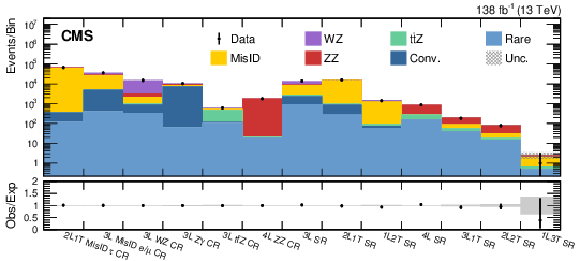
png pdf |
Figure 2:
Binned representation of the control and signal regions for the combined multilepton event selection and the combined 2016-2018 data set. The CR bins follow their definitions as given in Table 1, and the SR bins correspond to the channels as defined by the lepton flavor composition. The normalizations of the background samples in the CRs are described in Sections 5.1 and 5.2. All three (four) lepton events are required to have $ Q_{\ell}=1 (0) $, and those satisfying any of the CR requirements are removed from the SR bins. All subsequent selections given in Tables 2 and 3 are based on events given in the SR bins. The lower panel shows the ratio of observed events to the total expected SM background prediction (Obs/Exp), and the gray band represents the statistical uncertainties in the background prediction. |

png pdf |
Figure 3:
The $ M_{\mathrm{OSSF}} $ spectrum for the combined 2L1T, 2L2T, 3L, 3L1T, and 4L event selection (excluding the $ {\mathrm{Z}}{\gamma} $ CR) and the combined 2016-2018 data set. All three (four) lepton events are required to have $ Q_{\ell}=1\,(0) $. The lower panel shows the ratio of observed events to the total expected SM background prediction (Obs/Exp), and the gray band represents the statistical uncertainties in the background prediction. |
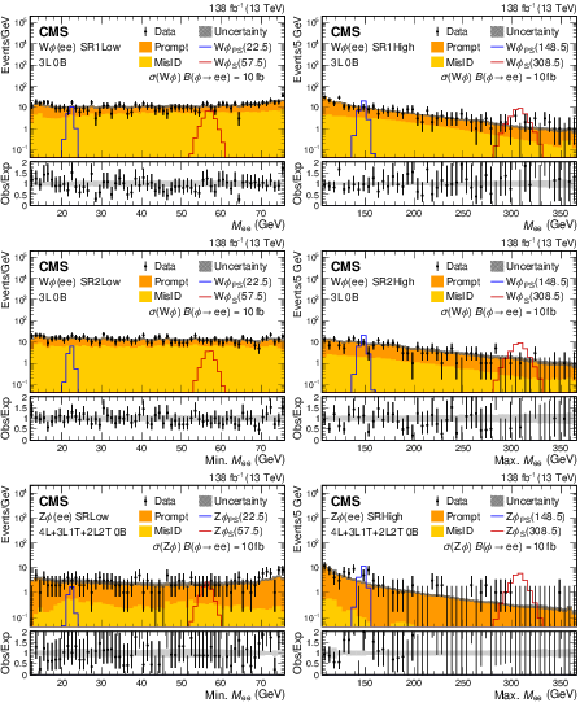
png pdf |
Figure 4:
Dilepton mass spectra for the $ {\mathrm{W}}{\phi}(\mathrm{e}\mathrm{e}) $ SR1 (upper), SR2 (middle), and for the $ {\mathrm{Z}}{\phi}(\mathrm{e}\mathrm{e}) $ SR (lower) event selections for the combined 2016-2018 data set. The low (high) mass spectra are shown on the left (right). The lower panel shows the ratio of observed events to the total expected SM background prediction (Obs/Exp), and the gray band represents the sum of statistical and systematic uncertainties in the background prediction. The expected background distributions and the uncertainties are shown after the data is fit under the background-only hypothesis. For illustration, two example signal hypotheses for the production and decay of a scalar and a pseudoscalar $ \phi $ boson are shown, and their masses (in units of GeV) are indicated in the legend. The signals are normalized to the product of the cross section and branching fraction of 10 fb. |

png pdf |
Figure 4-a:
Dilepton low mass spectrum for the $ {\mathrm{W}}{\phi}(\mathrm{e}\mathrm{e}) $ SR1 event selection for the combined 2016-2018 data set. The lower panel shows the ratio of observed events to the total expected SM background prediction (Obs/Exp), and the gray band represents the sum of statistical and systematic uncertainties in the background prediction. The expected background distributions and the uncertainties are shown after the data is fit under the background-only hypothesis. For illustration, two example signal hypotheses for the production and decay of a scalar and a pseudoscalar $ \phi $ boson are shown, and their masses (in units of GeV) are indicated in the legend. The signals are normalized to the product of the cross section and branching fraction of 10 fb. |
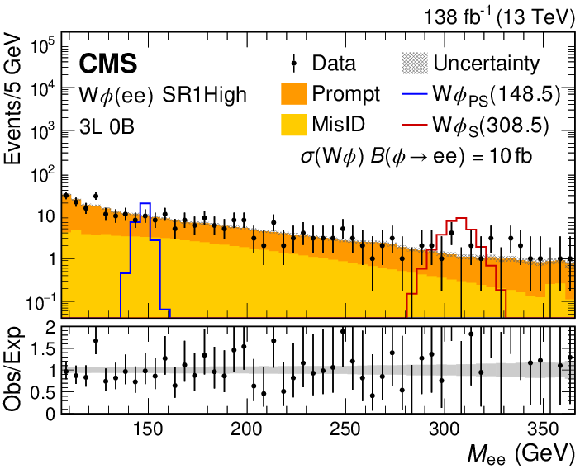
png pdf |
Figure 4-b:
Dilepton high mass spectrum for the $ {\mathrm{W}}{\phi}(\mathrm{e}\mathrm{e}) $ SR1 event selection for the combined 2016-2018 data set. The lower panel shows the ratio of observed events to the total expected SM background prediction (Obs/Exp), and the gray band represents the sum of statistical and systematic uncertainties in the background prediction. The expected background distributions and the uncertainties are shown after the data is fit under the background-only hypothesis. For illustration, two example signal hypotheses for the production and decay of a scalar and a pseudoscalar $ \phi $ boson are shown, and their masses (in units of GeV) are indicated in the legend. The signals are normalized to the product of the cross section and branching fraction of 10 fb. |
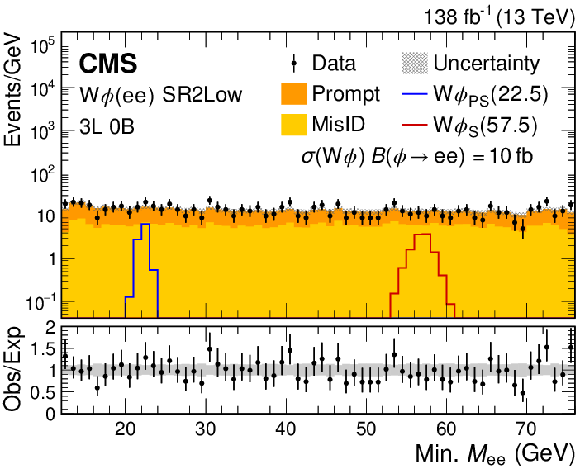
png pdf |
Figure 4-c:
Dilepton low mass spectrum for the $ {\mathrm{W}}{\phi}(\mathrm{e}\mathrm{e}) $ SR2 event selection for the combined 2016-2018 data set. The lower panel shows the ratio of observed events to the total expected SM background prediction (Obs/Exp), and the gray band represents the sum of statistical and systematic uncertainties in the background prediction. The expected background distributions and the uncertainties are shown after the data is fit under the background-only hypothesis. For illustration, two example signal hypotheses for the production and decay of a scalar and a pseudoscalar $ \phi $ boson are shown, and their masses (in units of GeV) are indicated in the legend. The signals are normalized to the product of the cross section and branching fraction of 10 fb. |

png pdf |
Figure 4-d:
Dilepton high mass spectrum for the $ {\mathrm{W}}{\phi}(\mathrm{e}\mathrm{e}) $ SR2 event selection for the combined 2016-2018 data set. The lower panel shows the ratio of observed events to the total expected SM background prediction (Obs/Exp), and the gray band represents the sum of statistical and systematic uncertainties in the background prediction. The expected background distributions and the uncertainties are shown after the data is fit under the background-only hypothesis. For illustration, two example signal hypotheses for the production and decay of a scalar and a pseudoscalar $ \phi $ boson are shown, and their masses (in units of GeV) are indicated in the legend. The signals are normalized to the product of the cross section and branching fraction of 10 fb. |
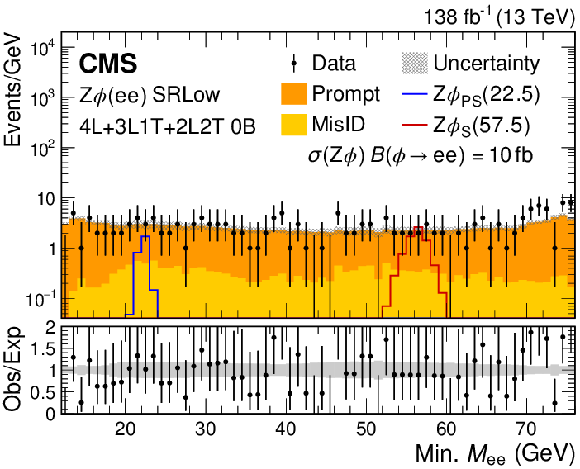
png pdf |
Figure 4-e:
Dilepton low mass spectrum for the $ {\mathrm{Z}}{\phi}(\mathrm{e}\mathrm{e}) $ SR event selection for the combined 2016-2018 data set. The lower panel shows the ratio of observed events to the total expected SM background prediction (Obs/Exp), and the gray band represents the sum of statistical and systematic uncertainties in the background prediction. The expected background distributions and the uncertainties are shown after the data is fit under the background-only hypothesis. For illustration, two example signal hypotheses for the production and decay of a scalar and a pseudoscalar $ \phi $ boson are shown, and their masses (in units of GeV) are indicated in the legend. The signals are normalized to the product of the cross section and branching fraction of 10 fb. |
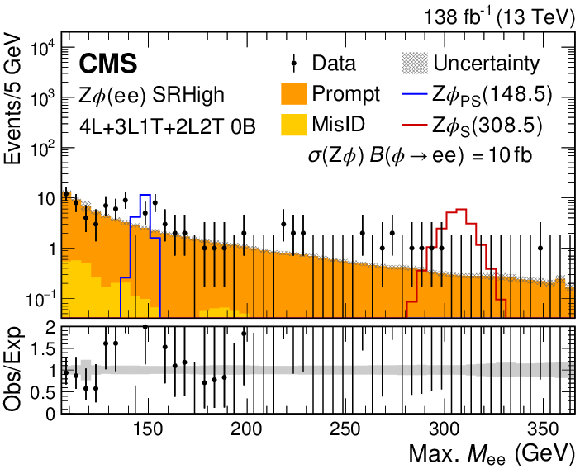
png pdf |
Figure 4-f:
Dilepton high mass spectrum for the $ {\mathrm{Z}}{\phi}(\mathrm{e}\mathrm{e}) $ SR event selection for the combined 2016-2018 data set. The lower panel shows the ratio of observed events to the total expected SM background prediction (Obs/Exp), and the gray band represents the sum of statistical and systematic uncertainties in the background prediction. The expected background distributions and the uncertainties are shown after the data is fit under the background-only hypothesis. For illustration, two example signal hypotheses for the production and decay of a scalar and a pseudoscalar $ \phi $ boson are shown, and their masses (in units of GeV) are indicated in the legend. The signals are normalized to the product of the cross section and branching fraction of 10 fb. |
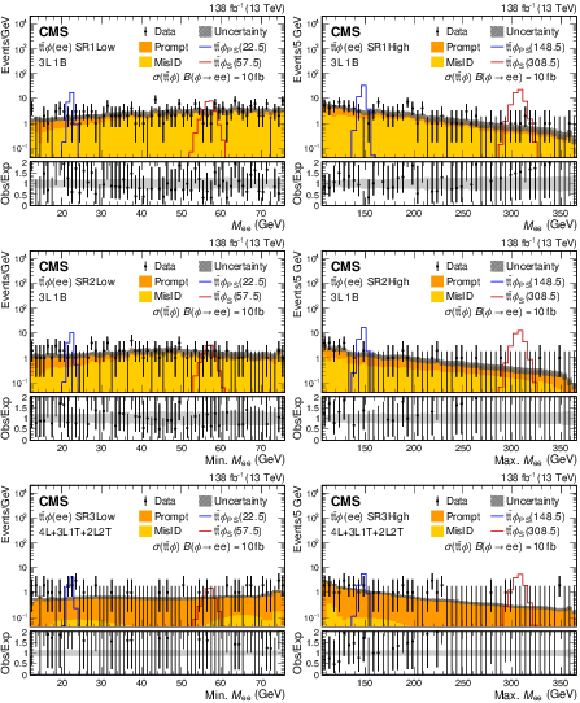
png pdf |
Figure 5:
Dilepton mass spectra for the $ {{\mathrm{t}\overline{\mathrm{t}}} }{\phi}(\mathrm{e}\mathrm{e}) $ SR1 (upper), SR2 (middle), and SR3 (lower) event selections for the combined 2016-2018 data set. The low (high) mass spectra are shown on the left (right). The lower panel shows the ratio of observed events to the total expected SM background prediction (Obs/Exp), and the gray band represents the sum of statistical and systematic uncertainties in the background prediction. The expected background distributions and the uncertainties are shown after the data is fit under the background-only hypothesis. For illustration, two example signal hypotheses for the production and decay of a scalar and a pseudoscalar $ \phi $ boson are shown, and their masses (in units of GeV) are indicated in the legend. The signals are normalized to the product of the cross section and branching fraction of 10 fb. |

png pdf |
Figure 5-a:
Dilepton low mass spectrum for the $ {{\mathrm{t}\overline{\mathrm{t}}} }{\phi}(\mathrm{e}\mathrm{e}) $ SR1 event selection for the combined 2016-2018 data set. The lower panel shows the ratio of observed events to the total expected SM background prediction (Obs/Exp), and the gray band represents the sum of statistical and systematic uncertainties in the background prediction. The expected background distributions and the uncertainties are shown after the data is fit under the background-only hypothesis. For illustration, two example signal hypotheses for the production and decay of a scalar and a pseudoscalar $ \phi $ boson are shown, and their masses (in units of GeV) are indicated in the legend. The signals are normalized to the product of the cross section and branching fraction of 10 fb. |

png pdf |
Figure 5-b:
Dilepton high mass spectrum for the $ {{\mathrm{t}\overline{\mathrm{t}}} }{\phi}(\mathrm{e}\mathrm{e}) $ SR1 event selection for the combined 2016-2018 data set. The lower panel shows the ratio of observed events to the total expected SM background prediction (Obs/Exp), and the gray band represents the sum of statistical and systematic uncertainties in the background prediction. The expected background distributions and the uncertainties are shown after the data is fit under the background-only hypothesis. For illustration, two example signal hypotheses for the production and decay of a scalar and a pseudoscalar $ \phi $ boson are shown, and their masses (in units of GeV) are indicated in the legend. The signals are normalized to the product of the cross section and branching fraction of 10 fb. |

png pdf |
Figure 5-c:
Dilepton low mass spectrum for the $ {{\mathrm{t}\overline{\mathrm{t}}} }{\phi}(\mathrm{e}\mathrm{e}) $ SR2 event selection for the combined 2016-2018 data set. The lower panel shows the ratio of observed events to the total expected SM background prediction (Obs/Exp), and the gray band represents the sum of statistical and systematic uncertainties in the background prediction. The expected background distributions and the uncertainties are shown after the data is fit under the background-only hypothesis. For illustration, two example signal hypotheses for the production and decay of a scalar and a pseudoscalar $ \phi $ boson are shown, and their masses (in units of GeV) are indicated in the legend. The signals are normalized to the product of the cross section and branching fraction of 10 fb. |
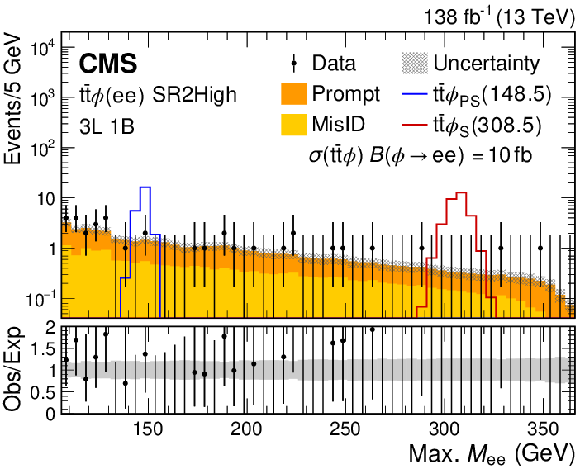
png pdf |
Figure 5-d:
Dilepton high mass spectrum for the $ {{\mathrm{t}\overline{\mathrm{t}}} }{\phi}(\mathrm{e}\mathrm{e}) $ SR2 event selection for the combined 2016-2018 data set. The lower panel shows the ratio of observed events to the total expected SM background prediction (Obs/Exp), and the gray band represents the sum of statistical and systematic uncertainties in the background prediction. The expected background distributions and the uncertainties are shown after the data is fit under the background-only hypothesis. For illustration, two example signal hypotheses for the production and decay of a scalar and a pseudoscalar $ \phi $ boson are shown, and their masses (in units of GeV) are indicated in the legend. The signals are normalized to the product of the cross section and branching fraction of 10 fb. |
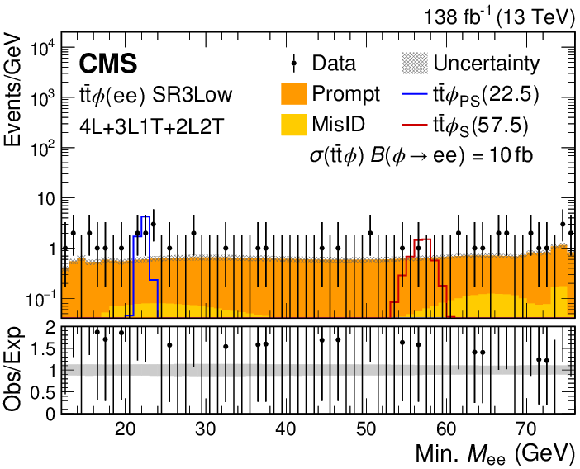
png pdf |
Figure 5-e:
Dilepton low mass spectrum for the $ {{\mathrm{t}\overline{\mathrm{t}}} }{\phi}(\mathrm{e}\mathrm{e}) $ SR3 event selection for the combined 2016-2018 data set. The lower panel shows the ratio of observed events to the total expected SM background prediction (Obs/Exp), and the gray band represents the sum of statistical and systematic uncertainties in the background prediction. The expected background distributions and the uncertainties are shown after the data is fit under the background-only hypothesis. For illustration, two example signal hypotheses for the production and decay of a scalar and a pseudoscalar $ \phi $ boson are shown, and their masses (in units of GeV) are indicated in the legend. The signals are normalized to the product of the cross section and branching fraction of 10 fb. |

png pdf |
Figure 5-f:
Dilepton high mass spectrum for the $ {{\mathrm{t}\overline{\mathrm{t}}} }{\phi}(\mathrm{e}\mathrm{e}) $ SR3 event selection for the combined 2016-2018 data set. The lower panel shows the ratio of observed events to the total expected SM background prediction (Obs/Exp), and the gray band represents the sum of statistical and systematic uncertainties in the background prediction. The expected background distributions and the uncertainties are shown after the data is fit under the background-only hypothesis. For illustration, two example signal hypotheses for the production and decay of a scalar and a pseudoscalar $ \phi $ boson are shown, and their masses (in units of GeV) are indicated in the legend. The signals are normalized to the product of the cross section and branching fraction of 10 fb. |
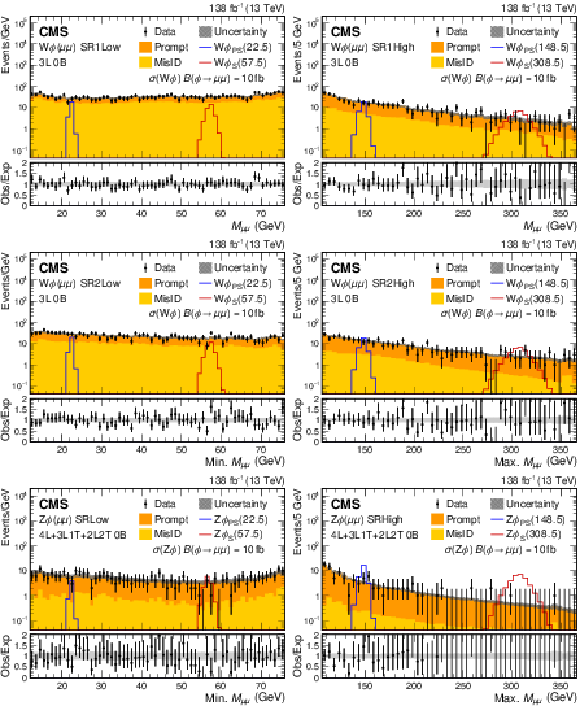
png pdf |
Figure 6:
Dilepton mass spectra for the $ {\mathrm{W}}{\phi}(\mu\mu) $ SR1 (upper), SR2 (middle), and $ {\mathrm{Z}}{\phi}(\mu\mu) $ SR (lower) event selections for the combined 2016-2018 data set. The low (high) mass spectra are shown on the left (right). The lower panel shows the ratio of observed events to the total expected SM background prediction (Obs/Exp), and the gray band represents the sum of statistical and systematic uncertainties in the background prediction. The expected background distributions and the uncertainties are shown after the data is fit under the background-only hypothesis. For illustration, two example signal hypotheses for the production and decay of a scalar and a pseudoscalar $ \phi $ boson are shown, and their masses (in units of GeV) are indicated in the legend. The signals are normalized to the product of the cross section and branching fraction of 10 fb. |
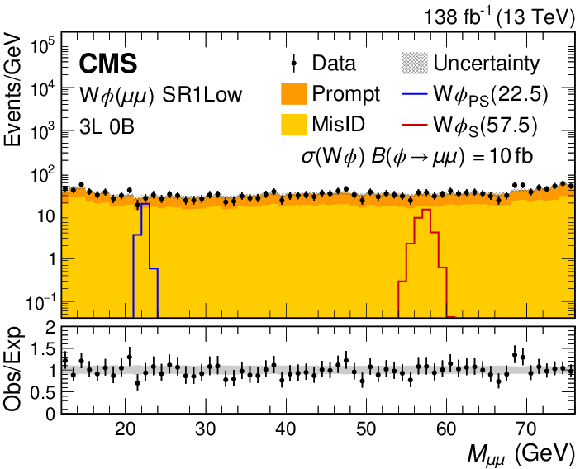
png pdf |
Figure 6-a:
Dilepton low mass spectrum for the $ {\mathrm{W}}{\phi}(\mu\mu) $ SR1 event selection for the combined 2016-2018 data set. The lower panel shows the ratio of observed events to the total expected SM background prediction (Obs/Exp), and the gray band represents the sum of statistical and systematic uncertainties in the background prediction. The expected background distributions and the uncertainties are shown after the data is fit under the background-only hypothesis. For illustration, two example signal hypotheses for the production and decay of a scalar and a pseudoscalar $ \phi $ boson are shown, and their masses (in units of GeV) are indicated in the legend. The signals are normalized to the product of the cross section and branching fraction of 10 fb. |

png pdf |
Figure 6-b:
Dilepton high mass spectrum for the $ {\mathrm{W}}{\phi}(\mu\mu) $ SR1 event selection for the combined 2016-2018 data set. The lower panel shows the ratio of observed events to the total expected SM background prediction (Obs/Exp), and the gray band represents the sum of statistical and systematic uncertainties in the background prediction. The expected background distributions and the uncertainties are shown after the data is fit under the background-only hypothesis. For illustration, two example signal hypotheses for the production and decay of a scalar and a pseudoscalar $ \phi $ boson are shown, and their masses (in units of GeV) are indicated in the legend. The signals are normalized to the product of the cross section and branching fraction of 10 fb. |

png pdf |
Figure 6-c:
Dilepton low mass spectrum for the $ {\mathrm{W}}{\phi}(\mu\mu) $ SR2 event selection for the combined 2016-2018 data set. The lower panel shows the ratio of observed events to the total expected SM background prediction (Obs/Exp), and the gray band represents the sum of statistical and systematic uncertainties in the background prediction. The expected background distributions and the uncertainties are shown after the data is fit under the background-only hypothesis. For illustration, two example signal hypotheses for the production and decay of a scalar and a pseudoscalar $ \phi $ boson are shown, and their masses (in units of GeV) are indicated in the legend. The signals are normalized to the product of the cross section and branching fraction of 10 fb. |
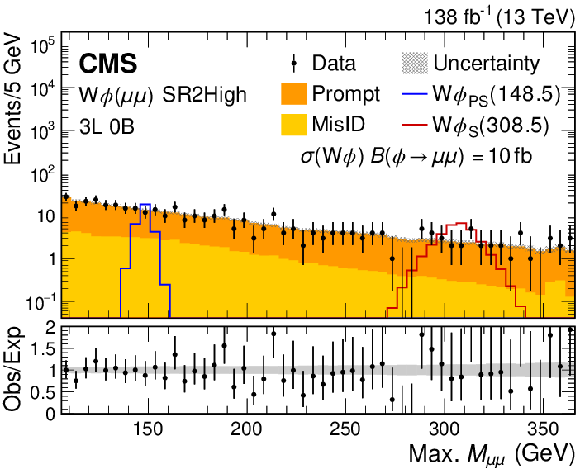
png pdf |
Figure 6-d:
Dilepton high mass spectrum for the $ {\mathrm{W}}{\phi}(\mu\mu) $ SR2 event selection for the combined 2016-2018 data set. The lower panel shows the ratio of observed events to the total expected SM background prediction (Obs/Exp), and the gray band represents the sum of statistical and systematic uncertainties in the background prediction. The expected background distributions and the uncertainties are shown after the data is fit under the background-only hypothesis. For illustration, two example signal hypotheses for the production and decay of a scalar and a pseudoscalar $ \phi $ boson are shown, and their masses (in units of GeV) are indicated in the legend. The signals are normalized to the product of the cross section and branching fraction of 10 fb. |
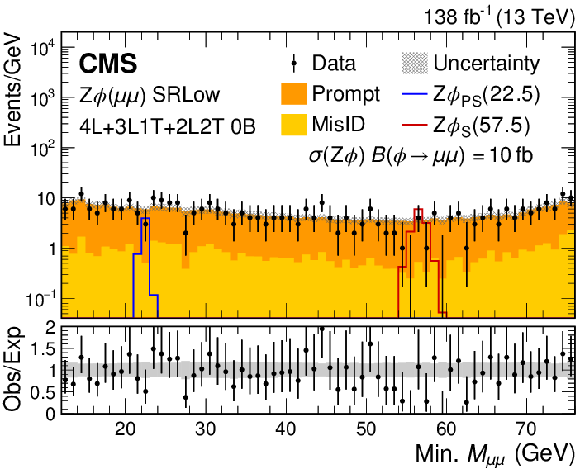
png pdf |
Figure 6-e:
Dilepton low mass spectrum for the $ {\mathrm{Z}}{\phi}(\mu\mu) $ SR event selection for the combined 2016-2018 data set. The lower panel shows the ratio of observed events to the total expected SM background prediction (Obs/Exp), and the gray band represents the sum of statistical and systematic uncertainties in the background prediction. The expected background distributions and the uncertainties are shown after the data is fit under the background-only hypothesis. For illustration, two example signal hypotheses for the production and decay of a scalar and a pseudoscalar $ \phi $ boson are shown, and their masses (in units of GeV) are indicated in the legend. The signals are normalized to the product of the cross section and branching fraction of 10 fb. |
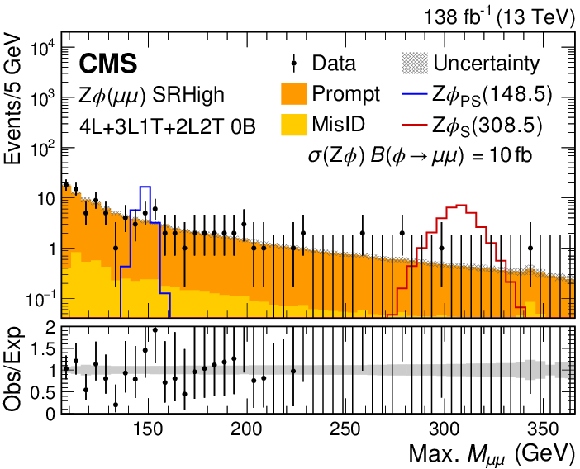
png pdf |
Figure 6-f:
Dilepton high mass spectrum for the $ {\mathrm{Z}}{\phi}(\mu\mu) $ SR event selection for the combined 2016-2018 data set. The lower panel shows the ratio of observed events to the total expected SM background prediction (Obs/Exp), and the gray band represents the sum of statistical and systematic uncertainties in the background prediction. The expected background distributions and the uncertainties are shown after the data is fit under the background-only hypothesis. For illustration, two example signal hypotheses for the production and decay of a scalar and a pseudoscalar $ \phi $ boson are shown, and their masses (in units of GeV) are indicated in the legend. The signals are normalized to the product of the cross section and branching fraction of 10 fb. |
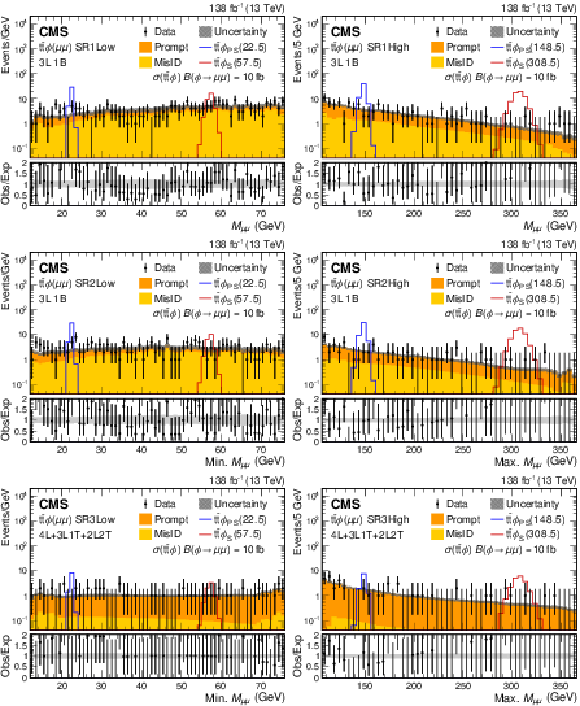
png pdf |
Figure 7:
Dilepton mass spectra for the $ {{\mathrm{t}\overline{\mathrm{t}}} }{\phi}(\mu\mu) $ SR1 (upper), SR2 (middle), and SR3 (lower) event selections for the combined 2016-2018 data set. The low (high) mass spectra are shown on the left (right). The lower panel shows the ratio of observed events to the total expected SM background prediction (Obs/Exp), and the gray band represents the sum of statistical and systematic uncertainties in the background prediction. The expected background distributions and the uncertainties are shown after the data is fit under the background-only hypothesis. For illustration, two example signal hypotheses for the production and decay of a scalar and a pseudoscalar $ \phi $ boson are shown, and their masses (in units of GeV) are indicated in the legend. The signals are normalized to the product of the cross section and branching fraction of 10 fb. |

png pdf |
Figure 7-a:
Dilepton low mass spectrum for the $ {{\mathrm{t}\overline{\mathrm{t}}} }{\phi}(\mu\mu) $ SR1 event selection for the combined 2016-2018 data set. The lower panel shows the ratio of observed events to the total expected SM background prediction (Obs/Exp), and the gray band represents the sum of statistical and systematic uncertainties in the background prediction. The expected background distributions and the uncertainties are shown after the data is fit under the background-only hypothesis. For illustration, two example signal hypotheses for the production and decay of a scalar and a pseudoscalar $ \phi $ boson are shown, and their masses (in units of GeV) are indicated in the legend. The signals are normalized to the product of the cross section and branching fraction of 10 fb. |
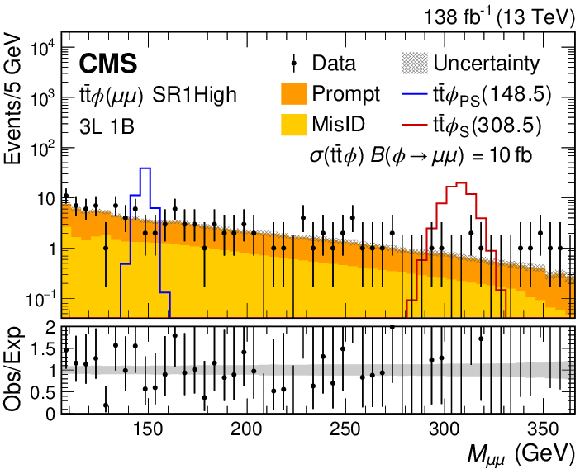
png pdf |
Figure 7-b:
Dilepton high mass spectrum for the $ {{\mathrm{t}\overline{\mathrm{t}}} }{\phi}(\mu\mu) $ SR1 event selection for the combined 2016-2018 data set. The lower panel shows the ratio of observed events to the total expected SM background prediction (Obs/Exp), and the gray band represents the sum of statistical and systematic uncertainties in the background prediction. The expected background distributions and the uncertainties are shown after the data is fit under the background-only hypothesis. For illustration, two example signal hypotheses for the production and decay of a scalar and a pseudoscalar $ \phi $ boson are shown, and their masses (in units of GeV) are indicated in the legend. The signals are normalized to the product of the cross section and branching fraction of 10 fb. |

png pdf |
Figure 7-c:
Dilepton low mass spectrum for the $ {{\mathrm{t}\overline{\mathrm{t}}} }{\phi}(\mu\mu) $ SR2 event selection for the combined 2016-2018 data set. The lower panel shows the ratio of observed events to the total expected SM background prediction (Obs/Exp), and the gray band represents the sum of statistical and systematic uncertainties in the background prediction. The expected background distributions and the uncertainties are shown after the data is fit under the background-only hypothesis. For illustration, two example signal hypotheses for the production and decay of a scalar and a pseudoscalar $ \phi $ boson are shown, and their masses (in units of GeV) are indicated in the legend. The signals are normalized to the product of the cross section and branching fraction of 10 fb. |
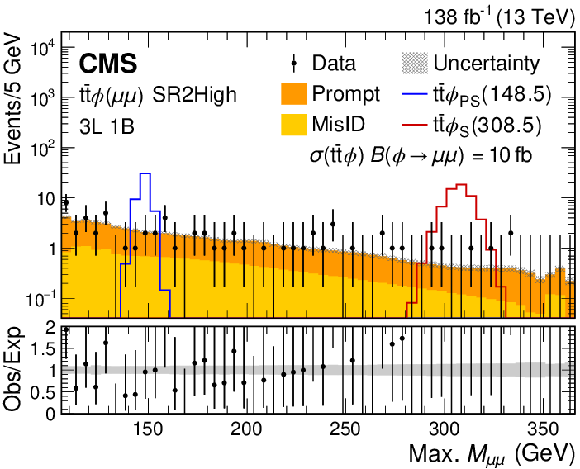
png pdf |
Figure 7-d:
Dilepton high mass spectrum for the $ {{\mathrm{t}\overline{\mathrm{t}}} }{\phi}(\mu\mu) $ SR2 event selection for the combined 2016-2018 data set. The lower panel shows the ratio of observed events to the total expected SM background prediction (Obs/Exp), and the gray band represents the sum of statistical and systematic uncertainties in the background prediction. The expected background distributions and the uncertainties are shown after the data is fit under the background-only hypothesis. For illustration, two example signal hypotheses for the production and decay of a scalar and a pseudoscalar $ \phi $ boson are shown, and their masses (in units of GeV) are indicated in the legend. The signals are normalized to the product of the cross section and branching fraction of 10 fb. |
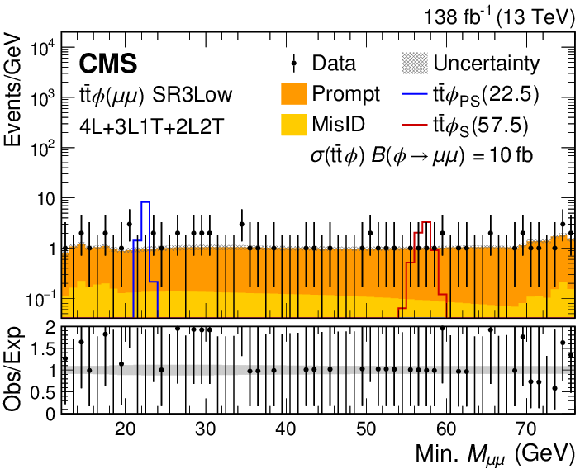
png pdf |
Figure 7-e:
Dilepton low mass spectrum for the $ {{\mathrm{t}\overline{\mathrm{t}}} }{\phi}(\mu\mu) $ SR3 event selection for the combined 2016-2018 data set. The lower panel shows the ratio of observed events to the total expected SM background prediction (Obs/Exp), and the gray band represents the sum of statistical and systematic uncertainties in the background prediction. The expected background distributions and the uncertainties are shown after the data is fit under the background-only hypothesis. For illustration, two example signal hypotheses for the production and decay of a scalar and a pseudoscalar $ \phi $ boson are shown, and their masses (in units of GeV) are indicated in the legend. The signals are normalized to the product of the cross section and branching fraction of 10 fb. |

png pdf |
Figure 7-f:
Dilepton high mass spectrum for the $ {{\mathrm{t}\overline{\mathrm{t}}} }{\phi}(\mu\mu) $ SR3 event selection for the combined 2016-2018 data set. The lower panel shows the ratio of observed events to the total expected SM background prediction (Obs/Exp), and the gray band represents the sum of statistical and systematic uncertainties in the background prediction. The expected background distributions and the uncertainties are shown after the data is fit under the background-only hypothesis. For illustration, two example signal hypotheses for the production and decay of a scalar and a pseudoscalar $ \phi $ boson are shown, and their masses (in units of GeV) are indicated in the legend. The signals are normalized to the product of the cross section and branching fraction of 10 fb. |

png pdf |
Figure 8:
Dilepton mass spectra for the $ {\mathrm{W}}{\phi}(\tau\tau) $ SR (left) and $ {\mathrm{Z}}{\phi}(\tau\tau) $ SR (right) event selections for the combined 2016-2018 data set. The lower panel shows the ratio of observed events to the total expected SM background prediction (Obs/Exp), and the gray band represents the sum of statistical and systematic uncertainties in the background prediction. The rightmost bins contain the overflow events in each distribution. The expected background distributions and the uncertainties are shown after the data is fit under the background-only hypothesis. For illustration, two example signal hypotheses for the production and decay of a scalar and a pseudoscalar $ \phi $ boson are shown, and their masses (in units of GeV) are indicated in the legend. The signals are normalized to the product of the cross section and branching fraction of 10 fb. |
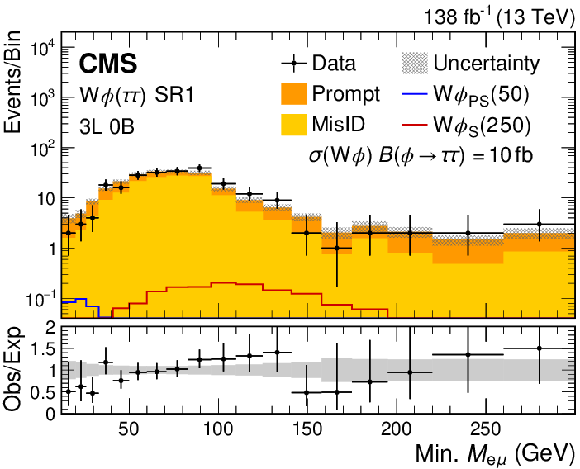
png pdf |
Figure 8-a:
Dilepton mass spectra for the $ {\mathrm{W}}{\phi}(\tau\tau) $ SR1 event selection for the combined 2016-2018 data set. The lower panel shows the ratio of observed events to the total expected SM background prediction (Obs/Exp), and the gray band represents the sum of statistical and systematic uncertainties in the background prediction. The rightmost bins contain the overflow events in each distribution. The expected background distributions and the uncertainties are shown after the data is fit under the background-only hypothesis. For illustration, two example signal hypotheses for the production and decay of a scalar and a pseudoscalar $ \phi $ boson are shown, and their masses (in units of GeV) are indicated in the legend. The signals are normalized to the product of the cross section and branching fraction of 10 fb. |
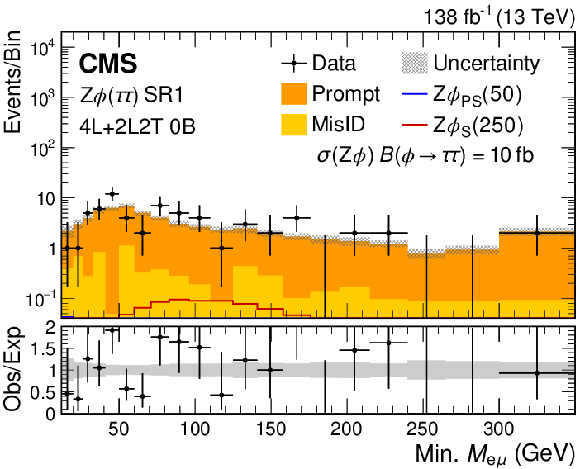
png pdf |
Figure 8-b:
Dilepton mass spectra for the $ {\mathrm{Z}}{\phi}(\tau\tau) $ SR1 event selection for the combined 2016-2018 data set. The lower panel shows the ratio of observed events to the total expected SM background prediction (Obs/Exp), and the gray band represents the sum of statistical and systematic uncertainties in the background prediction. The rightmost bins contain the overflow events in each distribution. The expected background distributions and the uncertainties are shown after the data is fit under the background-only hypothesis. For illustration, two example signal hypotheses for the production and decay of a scalar and a pseudoscalar $ \phi $ boson are shown, and their masses (in units of GeV) are indicated in the legend. The signals are normalized to the product of the cross section and branching fraction of 10 fb. |

png pdf |
Figure 8-c:
Dilepton mass spectra for the $ {\mathrm{W}}{\phi}(\tau\tau) $ SR2 event selection for the combined 2016-2018 data set. The lower panel shows the ratio of observed events to the total expected SM background prediction (Obs/Exp), and the gray band represents the sum of statistical and systematic uncertainties in the background prediction. The rightmost bins contain the overflow events in each distribution. The expected background distributions and the uncertainties are shown after the data is fit under the background-only hypothesis. For illustration, two example signal hypotheses for the production and decay of a scalar and a pseudoscalar $ \phi $ boson are shown, and their masses (in units of GeV) are indicated in the legend. The signals are normalized to the product of the cross section and branching fraction of 10 fb. |

png pdf |
Figure 8-d:
Dilepton mass spectra for the $ {\mathrm{Z}}{\phi}(\tau\tau) $ SR2 event selection for the combined 2016-2018 data set. The lower panel shows the ratio of observed events to the total expected SM background prediction (Obs/Exp), and the gray band represents the sum of statistical and systematic uncertainties in the background prediction. The rightmost bins contain the overflow events in each distribution. The expected background distributions and the uncertainties are shown after the data is fit under the background-only hypothesis. For illustration, two example signal hypotheses for the production and decay of a scalar and a pseudoscalar $ \phi $ boson are shown, and their masses (in units of GeV) are indicated in the legend. The signals are normalized to the product of the cross section and branching fraction of 10 fb. |
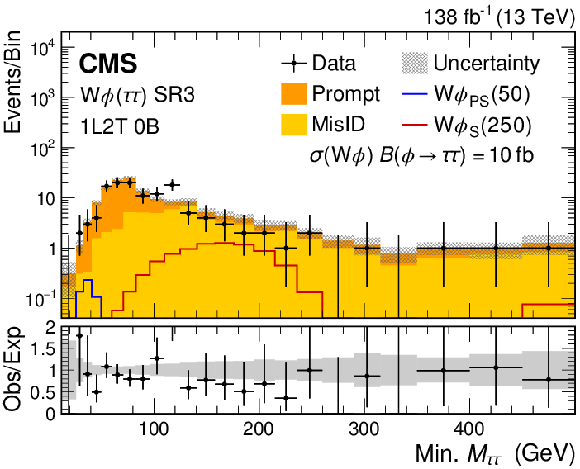
png pdf |
Figure 8-e:
Dilepton mass spectra for the $ {\mathrm{W}}{\phi}(\tau\tau) $ SR3 event selection for the combined 2016-2018 data set. The lower panel shows the ratio of observed events to the total expected SM background prediction (Obs/Exp), and the gray band represents the sum of statistical and systematic uncertainties in the background prediction. The rightmost bins contain the overflow events in each distribution. The expected background distributions and the uncertainties are shown after the data is fit under the background-only hypothesis. For illustration, two example signal hypotheses for the production and decay of a scalar and a pseudoscalar $ \phi $ boson are shown, and their masses (in units of GeV) are indicated in the legend. The signals are normalized to the product of the cross section and branching fraction of 10 fb. |
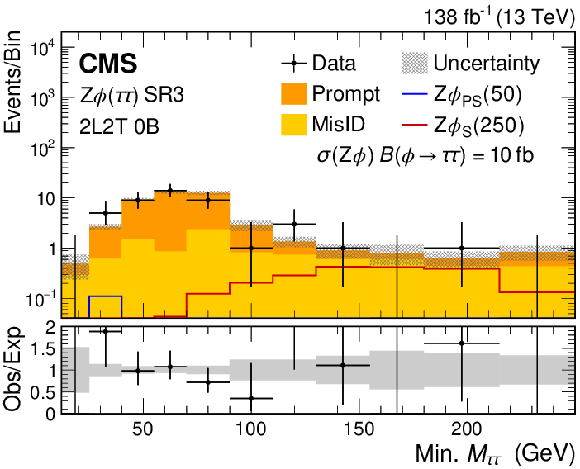
png pdf |
Figure 8-f:
Dilepton mass spectra for the $ {\mathrm{Z}}{\phi}(\tau\tau) $ SR3 event selection for the combined 2016-2018 data set. The lower panel shows the ratio of observed events to the total expected SM background prediction (Obs/Exp), and the gray band represents the sum of statistical and systematic uncertainties in the background prediction. The rightmost bins contain the overflow events in each distribution. The expected background distributions and the uncertainties are shown after the data is fit under the background-only hypothesis. For illustration, two example signal hypotheses for the production and decay of a scalar and a pseudoscalar $ \phi $ boson are shown, and their masses (in units of GeV) are indicated in the legend. The signals are normalized to the product of the cross section and branching fraction of 10 fb. |

png pdf |
Figure 9:
Dilepton mass spectra for the $ {{\mathrm{t}\overline{\mathrm{t}}} }{\phi}(\tau\tau) $ SR1-6 event selections for the combined 2016-2018 data set. The lower panel shows the ratio of observed events to the total expected SM background prediction (Obs/Exp), and the gray band represents the sum of statistical and systematic uncertainties in the background prediction. The rightmost bins contain the overflow events in each distribution. The expected background distributions and the uncertainties are shown after the data is fit under the background-only hypothesis. For illustration, two example signal hypotheses for the production and decay of a scalar and a pseudoscalar $ \phi $ boson are shown, and their masses (in units of GeV) are indicated in the legend. The signals are normalized to the product of the cross section and branching fraction of 10 fb. |
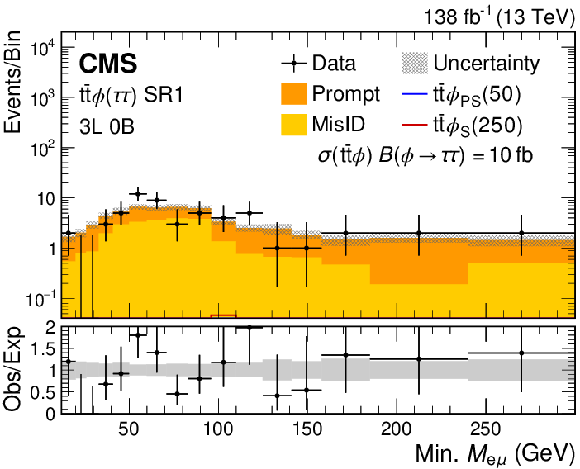
png pdf |
Figure 9-a:
Dilepton mass spectrum for the $ {{\mathrm{t}\overline{\mathrm{t}}} }{\phi}(\tau\tau) $ SR1 event selection for the combined 2016-2018 data set. The lower panel shows the ratio of observed events to the total expected SM background prediction (Obs/Exp), and the gray band represents the sum of statistical and systematic uncertainties in the background prediction. The rightmost bins contain the overflow events in each distribution. The expected background distributions and the uncertainties are shown after the data is fit under the background-only hypothesis. For illustration, two example signal hypotheses for the production and decay of a scalar and a pseudoscalar $ \phi $ boson are shown, and their masses (in units of GeV) are indicated in the legend. The signals are normalized to the product of the cross section and branching fraction of 10 fb. |

png pdf |
Figure 9-b:
Dilepton mass spectrum for the $ {{\mathrm{t}\overline{\mathrm{t}}} }{\phi}(\tau\tau) $ SR2 event selection for the combined 2016-2018 data set. The lower panel shows the ratio of observed events to the total expected SM background prediction (Obs/Exp), and the gray band represents the sum of statistical and systematic uncertainties in the background prediction. The rightmost bins contain the overflow events in each distribution. The expected background distributions and the uncertainties are shown after the data is fit under the background-only hypothesis. For illustration, two example signal hypotheses for the production and decay of a scalar and a pseudoscalar $ \phi $ boson are shown, and their masses (in units of GeV) are indicated in the legend. The signals are normalized to the product of the cross section and branching fraction of 10 fb. |
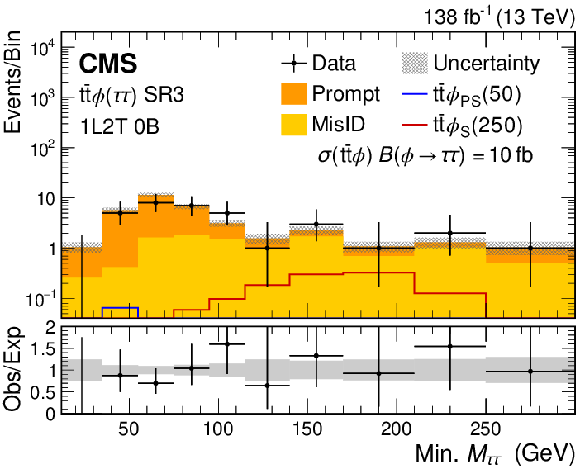
png pdf |
Figure 9-c:
Dilepton mass spectrum for the $ {{\mathrm{t}\overline{\mathrm{t}}} }{\phi}(\tau\tau) $ SR3 event selection for the combined 2016-2018 data set. The lower panel shows the ratio of observed events to the total expected SM background prediction (Obs/Exp), and the gray band represents the sum of statistical and systematic uncertainties in the background prediction. The rightmost bins contain the overflow events in each distribution. The expected background distributions and the uncertainties are shown after the data is fit under the background-only hypothesis. For illustration, two example signal hypotheses for the production and decay of a scalar and a pseudoscalar $ \phi $ boson are shown, and their masses (in units of GeV) are indicated in the legend. The signals are normalized to the product of the cross section and branching fraction of 10 fb. |
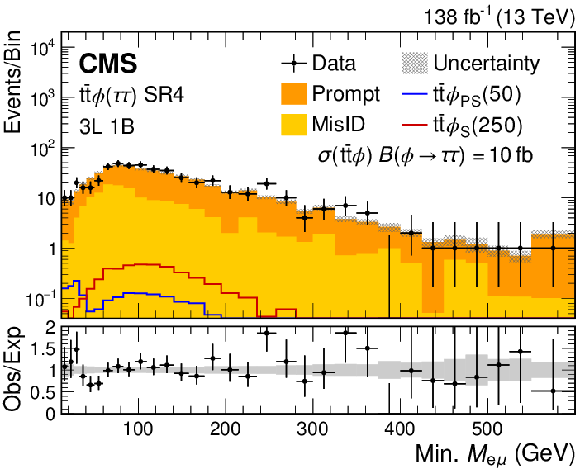
png pdf |
Figure 9-d:
Dilepton mass spectrum for the $ {{\mathrm{t}\overline{\mathrm{t}}} }{\phi}(\tau\tau) $ SR4 event selection for the combined 2016-2018 data set. The lower panel shows the ratio of observed events to the total expected SM background prediction (Obs/Exp), and the gray band represents the sum of statistical and systematic uncertainties in the background prediction. The rightmost bins contain the overflow events in each distribution. The expected background distributions and the uncertainties are shown after the data is fit under the background-only hypothesis. For illustration, two example signal hypotheses for the production and decay of a scalar and a pseudoscalar $ \phi $ boson are shown, and their masses (in units of GeV) are indicated in the legend. The signals are normalized to the product of the cross section and branching fraction of 10 fb. |

png pdf |
Figure 9-e:
Dilepton mass spectrum for the $ {{\mathrm{t}\overline{\mathrm{t}}} }{\phi}(\tau\tau) $ SR5 event selection for the combined 2016-2018 data set. The lower panel shows the ratio of observed events to the total expected SM background prediction (Obs/Exp), and the gray band represents the sum of statistical and systematic uncertainties in the background prediction. The rightmost bins contain the overflow events in each distribution. The expected background distributions and the uncertainties are shown after the data is fit under the background-only hypothesis. For illustration, two example signal hypotheses for the production and decay of a scalar and a pseudoscalar $ \phi $ boson are shown, and their masses (in units of GeV) are indicated in the legend. The signals are normalized to the product of the cross section and branching fraction of 10 fb. |
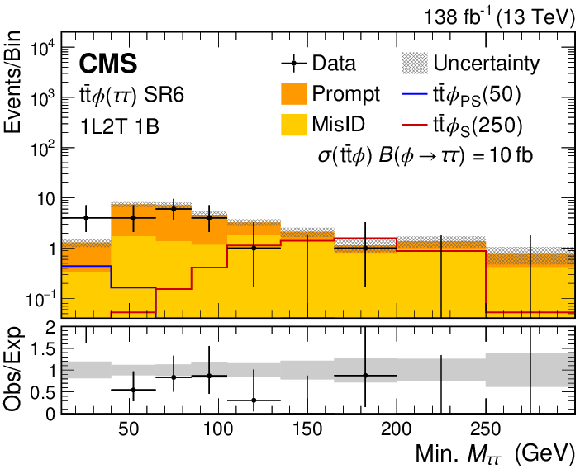
png pdf |
Figure 9-f:
Dilepton mass spectrum for the $ {{\mathrm{t}\overline{\mathrm{t}}} }{\phi}(\tau\tau) $ SR6 event selection for the combined 2016-2018 data set. The lower panel shows the ratio of observed events to the total expected SM background prediction (Obs/Exp), and the gray band represents the sum of statistical and systematic uncertainties in the background prediction. The rightmost bins contain the overflow events in each distribution. The expected background distributions and the uncertainties are shown after the data is fit under the background-only hypothesis. For illustration, two example signal hypotheses for the production and decay of a scalar and a pseudoscalar $ \phi $ boson are shown, and their masses (in units of GeV) are indicated in the legend. The signals are normalized to the product of the cross section and branching fraction of 10 fb. |

png pdf |
Figure 10:
Dilepton mass spectra for the $ {{\mathrm{t}\overline{\mathrm{t}}} }{\phi}(\tau\tau) $ SR7 event selection for the combined 2016-2018 data set. The lower panel shows the ratio of observed events to the total expected SM background prediction (Obs/Exp), and the gray band represents the sum of statistical and systematic uncertainties in the background prediction. The rightmost bins contain the overflow events in each distribution. The expected background distributions and the uncertainties are shown after the data is fit under the background-only hypothesis. For illustration, two example signal hypotheses for the production and decay of a scalar and a pseudoscalar $ \phi $ boson are shown, and their masses (in units of GeV) are indicated in the legend. The signals are normalized to the product of the cross section and branching fraction of 10 fb. |

png pdf |
Figure 11:
The 95% confidence level upper limits on the product of the production cross section and branching fraction of the $ {\mathrm{W}}{\phi} $ signal in the $ \mathrm{e}\mathrm{e} $ (upper), $ \mu\mu $ (middle), and $ \tau\tau $ (lower) decay scenarios. The results for the scalar coupling are shown on the left and pseudoscalar on the right. The vertical gray band indicates the mass region not considered in the analysis. The red line is the theoretical prediction for the product of the production cross section and branching fraction of the $ {\mathrm{W}}{\phi} $ signal. |

png pdf |
Figure 11-a:
The 95% confidence level upper limits on the product of the production cross section and branching fraction of the $ {\mathrm{W}}{\phi} $ signal in the $ \mathrm{e}\mathrm{e} $ decay scenario, for the scalar coupling. The vertical gray band indicates the mass region not considered in the analysis. The red line is the theoretical prediction for the product of the production cross section and branching fraction of the $ {\mathrm{W}}{\phi} $ signal. |
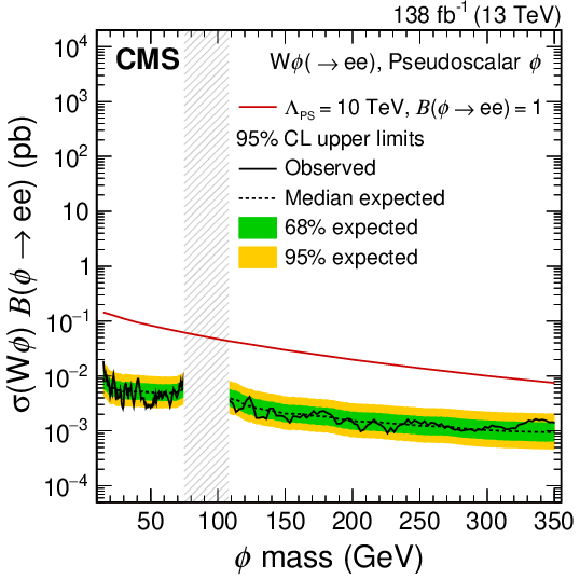
png pdf |
Figure 11-b:
The 95% confidence level upper limits on the product of the production cross section and branching fraction of the $ {\mathrm{W}}{\phi} $ signal in the $ \mathrm{e}\mathrm{e} $ decay scenario, for the pseudoscalar coupling. The vertical gray band indicates the mass region not considered in the analysis. The red line is the theoretical prediction for the product of the production cross section and branching fraction of the $ {\mathrm{W}}{\phi} $ signal. |
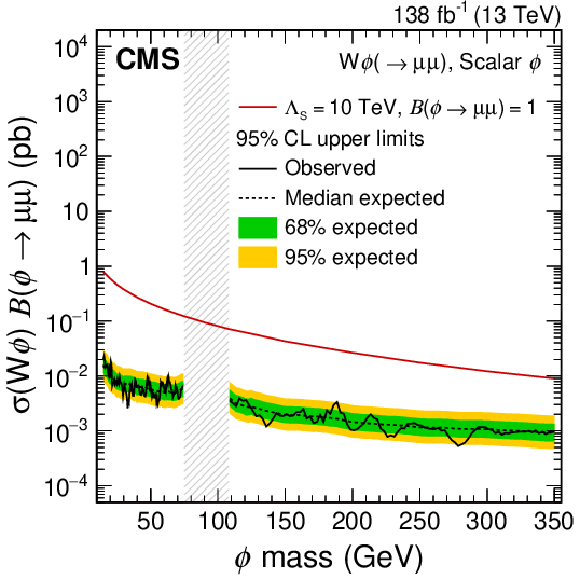
png pdf |
Figure 11-c:
The 95% confidence level upper limits on the product of the production cross section and branching fraction of the $ {\mathrm{W}}{\phi} $ signal in the $ \mu\mu $ decay scenario, for the scalar coupling. The vertical gray band indicates the mass region not considered in the analysis. The red line is the theoretical prediction for the product of the production cross section and branching fraction of the $ {\mathrm{W}}{\phi} $ signal. |

png pdf |
Figure 11-d:
The 95% confidence level upper limits on the product of the production cross section and branching fraction of the $ {\mathrm{W}}{\phi} $ signal in the $ \mu\mu $ decay scenario, for the pseudoscalar coupling. The vertical gray band indicates the mass region not considered in the analysis. The red line is the theoretical prediction for the product of the production cross section and branching fraction of the $ {\mathrm{W}}{\phi} $ signal. |

png pdf |
Figure 11-e:
The 95% confidence level upper limits on the product of the production cross section and branching fraction of the $ {\mathrm{W}}{\phi} $ signal in the $ \tau\tau $ decay scenario, for the scalar coupling. The vertical gray band indicates the mass region not considered in the analysis. The red line is the theoretical prediction for the product of the production cross section and branching fraction of the $ {\mathrm{W}}{\phi} $ signal. |

png pdf |
Figure 11-f:
The 95% confidence level upper limits on the product of the production cross section and branching fraction of the $ {\mathrm{W}}{\phi} $ signal in the $ \tau\tau $ decay scenario, for the pseudoscalar coupling. The vertical gray band indicates the mass region not considered in the analysis. The red line is the theoretical prediction for the product of the production cross section and branching fraction of the $ {\mathrm{W}}{\phi} $ signal. |

png pdf |
Figure 12:
The 95% confidence level upper limits on the product of the production cross section and branching fraction of the $ {\mathrm{Z}}{\phi} $ signal in the $ \mathrm{e}\mathrm{e} $ (upper), $ \mu\mu $ (middle) and $ \tau\tau $ (lower) decay scenarios. The results for the scalar coupling are shown on the left and pseudoscalar on the right. The vertical gray band indicates the mass region not considered in the analysis. The red line is the theoretical prediction for the product of the production cross section and branching fraction of the $ {\mathrm{Z}}{\phi} $ signal. |
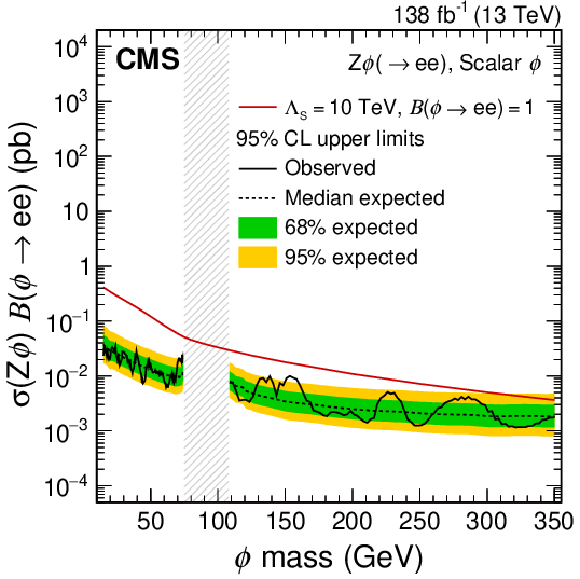
png pdf |
Figure 12-a:
The 95% confidence level upper limits on the product of the production cross section and branching fraction of the $ {\mathrm{Z}}{\phi} $ signal in the $ \mathrm{e}\mathrm{e} $ decay scenario, for the scalar coupling. The vertical gray band indicates the mass region not considered in the analysis. The red line is the theoretical prediction for the product of the production cross section and branching fraction of the $ {\mathrm{Z}}{\phi} $ signal. |

png pdf |
Figure 12-b:
The 95% confidence level upper limits on the product of the production cross section and branching fraction of the $ {\mathrm{Z}}{\phi} $ signal in the $ \mathrm{e}\mathrm{e} $ decay scenario, for the pseudoscalar coupling. The vertical gray band indicates the mass region not considered in the analysis. The red line is the theoretical prediction for the product of the production cross section and branching fraction of the $ {\mathrm{Z}}{\phi} $ signal. |
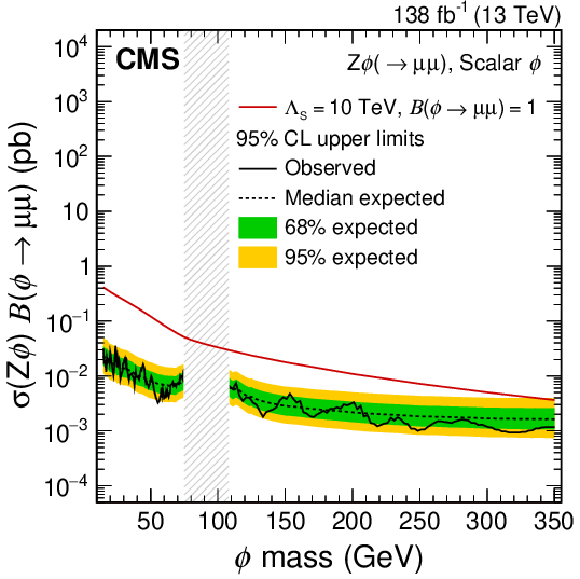
png pdf |
Figure 12-c:
The 95% confidence level upper limits on the product of the production cross section and branching fraction of the $ {\mathrm{Z}}{\phi} $ signal in the $ \mu\mu $ decay scenario, for the scalar coupling. The vertical gray band indicates the mass region not considered in the analysis. The red line is the theoretical prediction for the product of the production cross section and branching fraction of the $ {\mathrm{Z}}{\phi} $ signal. |
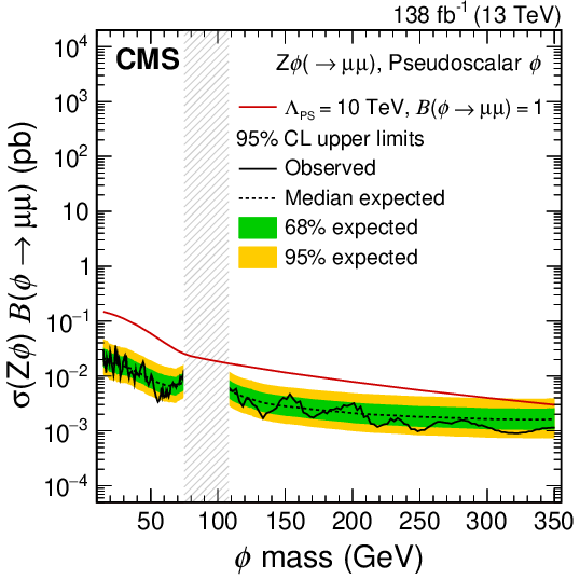
png pdf |
Figure 12-d:
The 95% confidence level upper limits on the product of the production cross section and branching fraction of the $ {\mathrm{Z}}{\phi} $ signal in the $ \mu\mu $ decay scenario, for the pseudoscalar coupling. The vertical gray band indicates the mass region not considered in the analysis. The red line is the theoretical prediction for the product of the production cross section and branching fraction of the $ {\mathrm{Z}}{\phi} $ signal. |

png pdf |
Figure 12-e:
The 95% confidence level upper limits on the product of the production cross section and branching fraction of the $ {\mathrm{Z}}{\phi} $ signal in the $ \tau\tau $ decay scenario, for the scalar coupling. The vertical gray band indicates the mass region not considered in the analysis. The red line is the theoretical prediction for the product of the production cross section and branching fraction of the $ {\mathrm{Z}}{\phi} $ signal. |
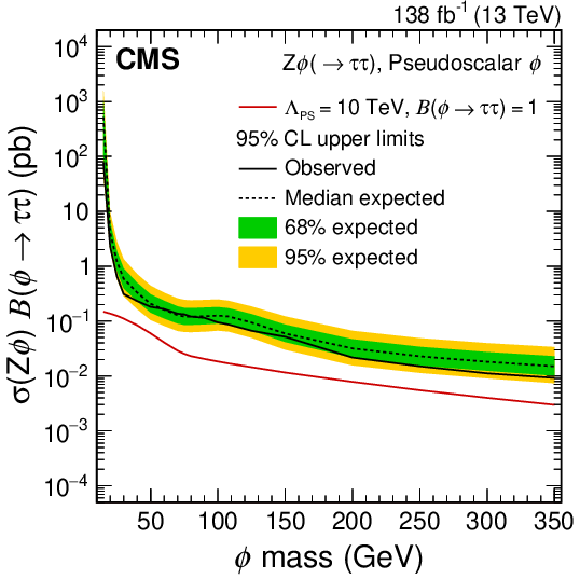
png pdf |
Figure 12-f:
The 95% confidence level upper limits on the product of the production cross section and branching fraction of the $ {\mathrm{Z}}{\phi} $ signal in the $ \tau\tau $ decay scenario, for the pseudoscalar coupling. The vertical gray band indicates the mass region not considered in the analysis. The red line is the theoretical prediction for the product of the production cross section and branching fraction of the $ {\mathrm{Z}}{\phi} $ signal. |

png pdf |
Figure 13:
The 95% confidence level upper limits on the product of the production cross section and branching fraction of the $ {\mathrm{W}}{\phi} $ signal on the left and the $ {\mathrm{Z}}{\phi} $ signal on the right with H-like couplings in the $ \mathrm{e}\mathrm{e} $ (upper), $ \mu\mu $ (middle) and $ \tau\tau $ (lower) decay scenarios. The vertical gray band indicates the mass region not considered in the analysis. The red line is the theoretical prediction for the product of the production cross section and branching fraction of the $ {\mathrm{W}}{\phi} $ and $ {\mathrm{Z}}{\phi} $ signals. |
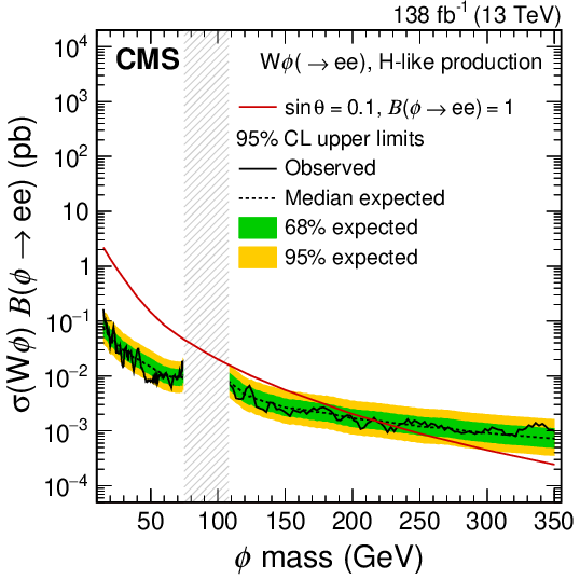
png pdf |
Figure 13-a:
The 95% confidence level upper limits on the product of the production cross section and branching fraction of the $ {\mathrm{W}}{\phi} $ signal with H-like couplings in the $ \mathrm{e}\mathrm{e} $ decay scenario. The vertical gray band indicates the mass region not considered in the analysis. The red line is the theoretical prediction for the product of the production cross section and branching fraction of the $ {\mathrm{W}}{\phi} $ signal. |
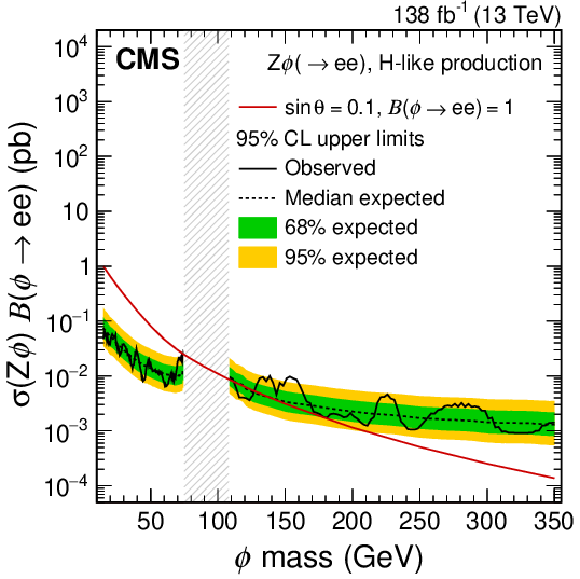
png pdf |
Figure 13-b:
The 95% confidence level upper limits on the product of the production cross section and branching fraction of the $ {\mathrm{Z}}{\phi} $ signal with H-like couplings in the $ \mathrm{e}\mathrm{e} $ decay scenario. The vertical gray band indicates the mass region not considered in the analysis. The red line is the theoretical prediction for the product of the production cross section and branching fraction of the $ {\mathrm{Z}}{\phi} $ signal. |
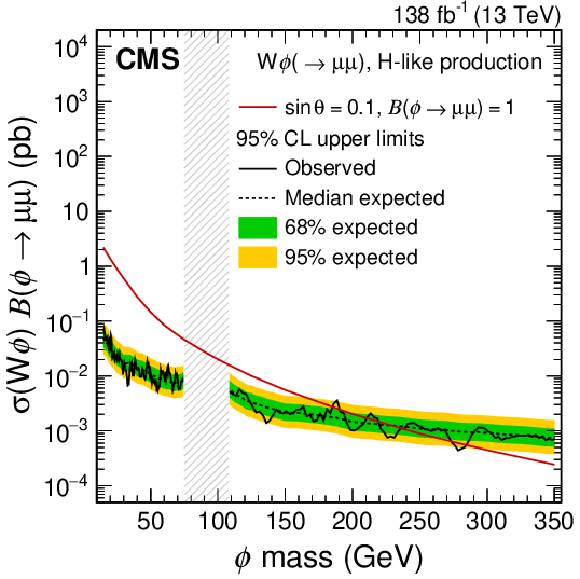
png pdf |
Figure 13-c:
The 95% confidence level upper limits on the product of the production cross section and branching fraction of the $ {\mathrm{W}}{\phi} $ signal with H-like couplings in the $ \mu\mu $ decay scenario. The vertical gray band indicates the mass region not considered in the analysis. The red line is the theoretical prediction for the product of the production cross section and branching fraction of the $ {\mathrm{W}}{\phi} $ signal. |

png pdf |
Figure 13-d:
The 95% confidence level upper limits on the product of the production cross section and branching fraction of the $ {\mathrm{Z}}{\phi} $ signal with H-like couplings in the $ \mu\mu $ decay scenario. The vertical gray band indicates the mass region not considered in the analysis. The red line is the theoretical prediction for the product of the production cross section and branching fraction of the $ {\mathrm{Z}}{\phi} $ signal. |
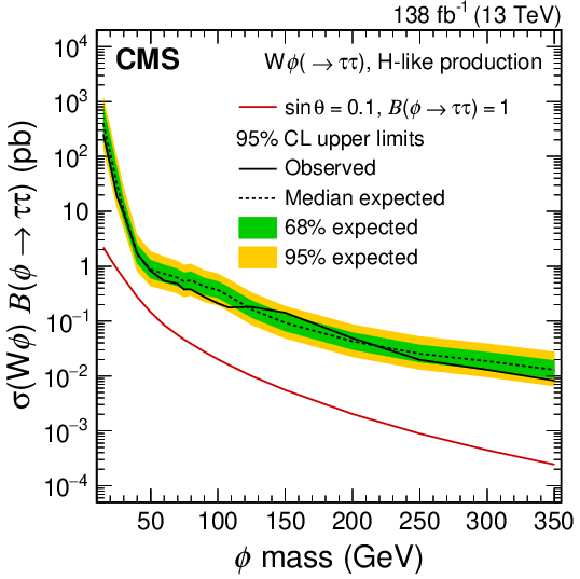
png pdf |
Figure 13-e:
The 95% confidence level upper limits on the product of the production cross section and branching fraction of the $ {\mathrm{W}}{\phi} $ signal with H-like couplings in the $ \tau\tau $ decay scenario. The vertical gray band indicates the mass region not considered in the analysis. The red line is the theoretical prediction for the product of the production cross section and branching fraction of the $ {\mathrm{W}}{\phi} $ signal. |
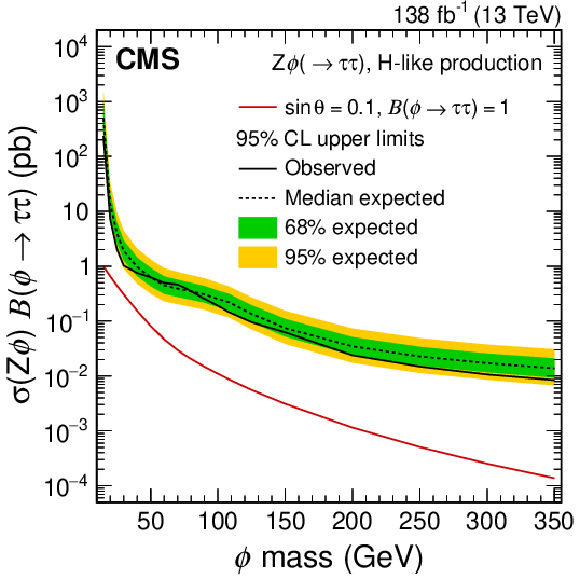
png pdf |
Figure 13-f:
The 95% confidence level upper limits on the product of the production cross section and branching fraction of the $ {\mathrm{Z}}{\phi} $ signal with H-like couplings in the $ \tau\tau $ decay scenario. The vertical gray band indicates the mass region not considered in the analysis. The red line is the theoretical prediction for the product of the production cross section and branching fraction of the $ {\mathrm{Z}}{\phi} $ signal. |
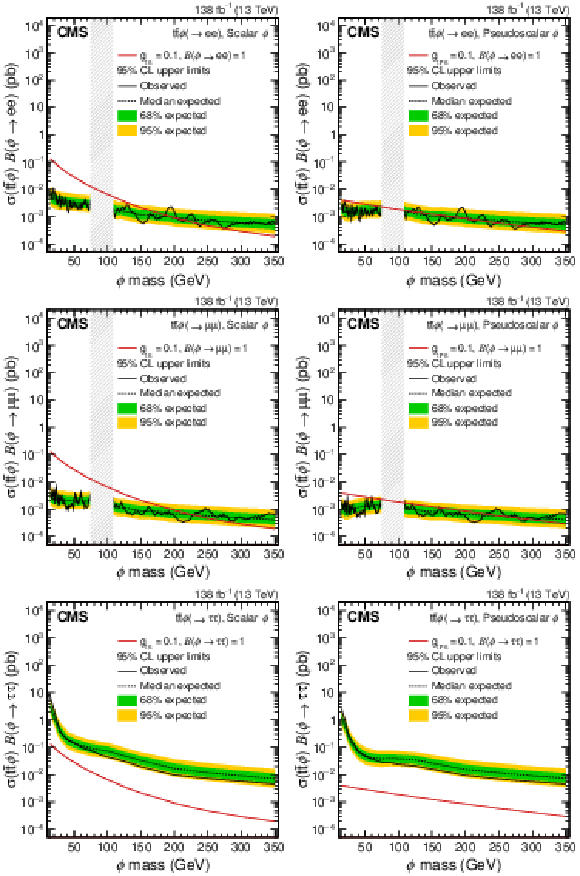
png pdf |
Figure 14:
The 95% confidence level upper limits on the product of the production cross section and branching fraction of the $ {{\mathrm{t}\overline{\mathrm{t}}} }{\phi} $ signal in the $ \mathrm{e}\mathrm{e} $ (upper), $ \mu\mu $ (middle) and $ \tau\tau $ (lower) decay scenarios. The results for the scalar coupling are shown on the left and pseudoscalar on the right. The vertical gray band indicates the mass region not considered in the analysis. The red line is the theoretical prediction for the product of the production cross section and branching fraction of the $ {{\mathrm{t}\overline{\mathrm{t}}} }{\phi} $ signal. |
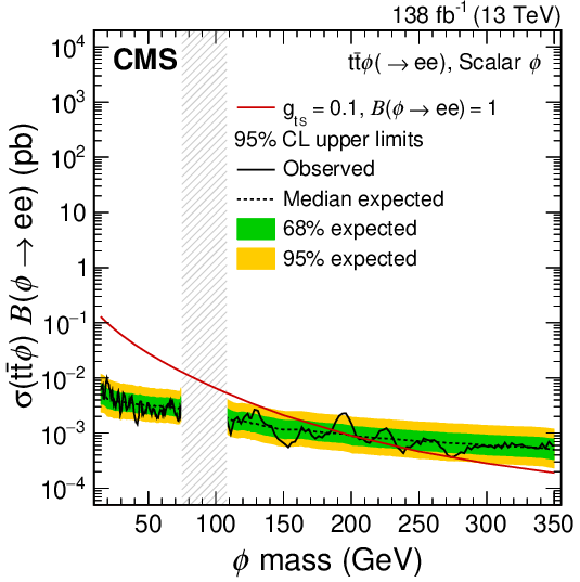
png pdf |
Figure 14-a:
The 95% confidence level upper limits on the product of the production cross section and branching fraction of the $ {{\mathrm{t}\overline{\mathrm{t}}} }{\phi} $ signal in the $ \mathrm{e}\mathrm{e} $ decay scenario, for the scalar coupling. The vertical gray band indicates the mass region not considered in the analysis. The red line is the theoretical prediction for the product of the production cross section and branching fraction of the $ {{\mathrm{t}\overline{\mathrm{t}}} }{\phi} $ signal. |

png pdf |
Figure 14-b:
The 95% confidence level upper limits on the product of the production cross section and branching fraction of the $ {{\mathrm{t}\overline{\mathrm{t}}} }{\phi} $ signal in the $ \mathrm{e}\mathrm{e} $ decay scenario, for the pseudoscalar coupling. The vertical gray band indicates the mass region not considered in the analysis. The red line is the theoretical prediction for the product of the production cross section and branching fraction of the $ {{\mathrm{t}\overline{\mathrm{t}}} }{\phi} $ signal. |

png pdf |
Figure 14-c:
The 95% confidence level upper limits on the product of the production cross section and branching fraction of the $ {{\mathrm{t}\overline{\mathrm{t}}} }{\phi} $ signal in the $ \mu\mu $ decay scenario, for the scalar coupling. The vertical gray band indicates the mass region not considered in the analysis. The red line is the theoretical prediction for the product of the production cross section and branching fraction of the $ {{\mathrm{t}\overline{\mathrm{t}}} }{\phi} $ signal. |
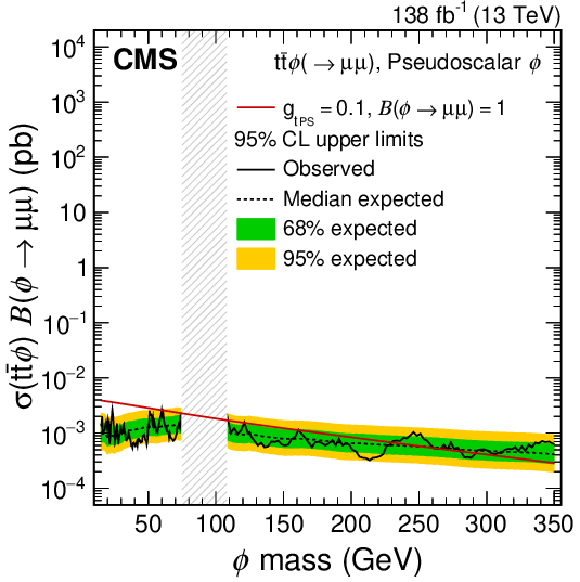
png pdf |
Figure 14-d:
The 95% confidence level upper limits on the product of the production cross section and branching fraction of the $ {{\mathrm{t}\overline{\mathrm{t}}} }{\phi} $ signal in the $ \mu\mu $ decay scenario, for the pseudoscalar coupling. The vertical gray band indicates the mass region not considered in the analysis. The red line is the theoretical prediction for the product of the production cross section and branching fraction of the $ {{\mathrm{t}\overline{\mathrm{t}}} }{\phi} $ signal. |

png pdf |
Figure 14-e:
The 95% confidence level upper limits on the product of the production cross section and branching fraction of the $ {{\mathrm{t}\overline{\mathrm{t}}} }{\phi} $ signal in the $ \tau\tau $ decay scenario, for the scalar coupling. The vertical gray band indicates the mass region not considered in the analysis. The red line is the theoretical prediction for the product of the production cross section and branching fraction of the $ {{\mathrm{t}\overline{\mathrm{t}}} }{\phi} $ signal. |

png pdf |
Figure 14-f:
The 95% confidence level upper limits on the product of the production cross section and branching fraction of the $ {{\mathrm{t}\overline{\mathrm{t}}} }{\phi} $ signal in the $ \tau\tau $ decay scenario, for the pseudoscalar coupling. The vertical gray band indicates the mass region not considered in the analysis. The red line is the theoretical prediction for the product of the production cross section and branching fraction of the $ {{\mathrm{t}\overline{\mathrm{t}}} }{\phi} $ signal. |

png pdf |
Figure 15:
The 95% confidence level upper limits on $ {\mathrm{g}}_{{\mathrm{t S}}}^2 $ and $ {\mathrm{g}}_{{\mathrm{t PS}}}^2 $ for the dilaton- and axion-like $ {{\mathrm{t}\overline{\mathrm{t}}} }{\phi} $ signal model (left and right). Masses of the $ \phi $ boson above 300 GeV are not probed for the dilaton- and axion-like signal models as the $ \phi $ branching fraction into top quark-antiquark pairs becomes nonnegligible. |

png pdf |
Figure 15-a:
The 95% confidence level upper limits on $ {\mathrm{g}}_{{\mathrm{t S}}}^2 $ and $ {\mathrm{g}}_{{\mathrm{t PS}}}^2 $ for the dilaton-like $ {{\mathrm{t}\overline{\mathrm{t}}} }{\phi} $ signal model. Masses of the $ \phi $ boson above 300 GeV are not probed for the dilaton-like signal model as the $ \phi $ branching fraction into top quark-antiquark pairs becomes nonnegligible. |
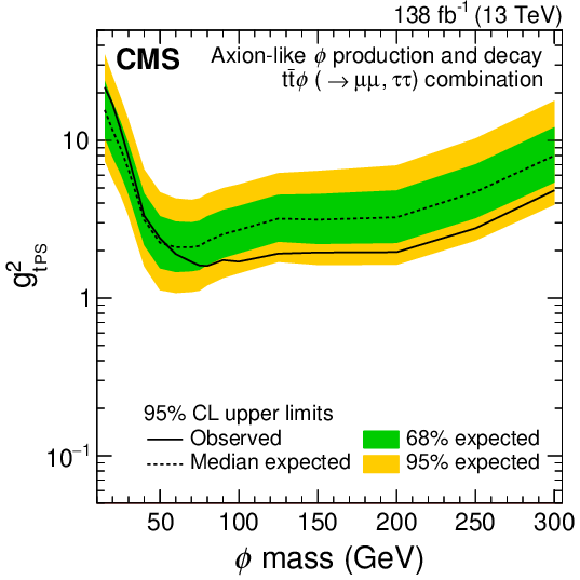
png pdf |
Figure 15-b:
The 95% confidence level upper limits on $ {\mathrm{g}}_{{\mathrm{t S}}}^2 $ and $ {\mathrm{g}}_{{\mathrm{t PS}}}^2 $ for the axion-like $ {{\mathrm{t}\overline{\mathrm{t}}} }{\phi} $ signal model. Masses of the $ \phi $ boson above 300 GeV are not probed for the axion-like signal model as the $ \phi $ branching fraction into top quark-antiquark pairs becomes nonnegligible. |

png pdf |
Figure 16:
The 95% confidence level upper limits on the product of $ \sin^2\theta $ and branching fraction for the H-like production of $ {\mathrm{X}}{\phi}\to\mathrm{e}\mathrm{e} $ and $ {\mathrm{X}}{\phi}\to\mu\mu $ (left and right). The vertical gray band indicates the mass region not considered in the analysis. |
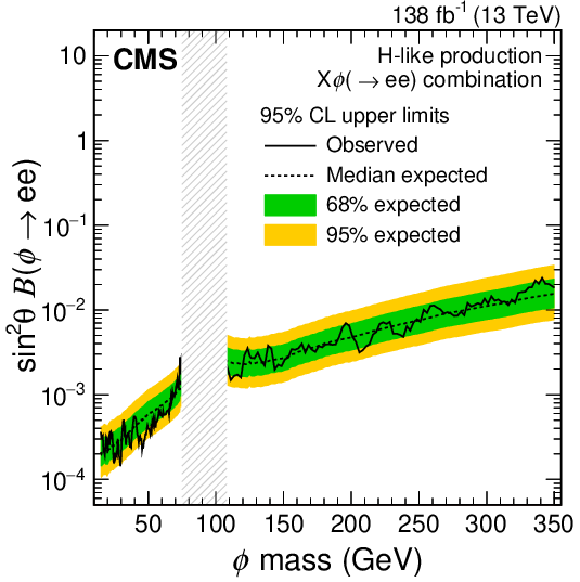
png pdf |
Figure 16-a:
The 95% confidence level upper limits on the product of $ \sin^2\theta $ and branching fraction for the H-like production of $ {\mathrm{X}}{\phi}\to\mathrm{e}\mathrm{e} $. The vertical gray band indicates the mass region not considered in the analysis. |

png pdf |
Figure 16-b:
The 95% confidence level upper limits on the product of $ \sin^2\theta $ and branching fraction for the H-like production of $ {\mathrm{X}}{\phi}\to\mu\mu $. The vertical gray band indicates the mass region not considered in the analysis. |

png pdf |
Figure 17:
The 95% confidence level upper limits on $ \sin^2\theta $ for the H-like production and decay of $ {\mathrm{X}}{\phi} $ signal model. |
| Tables | |

png pdf |
Table 1:
A summary of control regions for the SM processes $ {\mathrm{Z}}{\mathrm{Z}} $, $ {\mathrm{Z}}{\gamma} $, $ {\mathrm{W}}{\mathrm{Z}} $, and $ {{\mathrm{t}\overline{\mathrm{t}}} }{\mathrm{Z}} $, and for the misidentified lepton backgrounds (MisID $ \mathrm{e}/\mu $ and MisID $ \tau $). The $ p_{\mathrm{T}}^\text{miss} $, $ M_{\mathrm{T}} $, 3L minimum lepton transverse momentum $ p_{\mathrm{T3}} $, $ M_{\ell} $, and $ S_{\mathrm{T}} $ quantities are given in units of GeV. The 3L OnZ CR is further split into 3L MisID $ \mathrm{e}/\mu $ CR, 3L $ {\mathrm{W}}{\mathrm{Z}} $ CR, and 3L $ {{\mathrm{t}\overline{\mathrm{t}}} }{\mathrm{Z}} $ CR. The terminology is described in Section 5. |
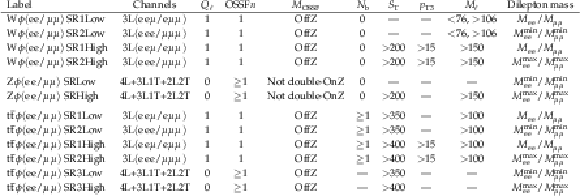
png pdf |
Table 2:
Low- and high-mass signal region selections for $ {\mathrm{X}}{\phi}\to\mathrm{e}\mathrm{e}/\mu\mu $ signals. Events satisfying the control region requirements are vetoed throughout, and only those with a reconstructed $ \phi $ candidate are retained using the specified dilepton mass variable. The $ S_{\mathrm{T}} $, $ p_{\mathrm{T3}} $, and $ M_{\ell} $ requirements are specified in units of GeV. The two entries in the labels, channels, and dilepton mass variables are provided for the $ X\phi\to\mathrm{e}\mathrm{e} $ and $ X\phi\to\mu\mu $ signal scenarios, as appropriate. |
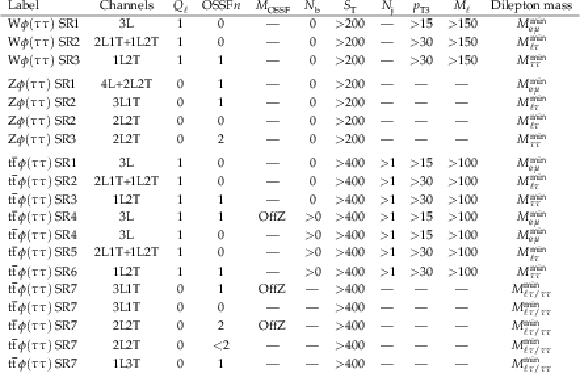
png pdf |
Table 3:
Signal selections for $ {\mathrm{X}}{\phi}\to\tau\tau $ signals. Events satisfying the control region requirements are vetoed throughout, and only those with a reconstructed $ \phi $ candidate are retained using the specified dilepton mass variable. The $ S_{\mathrm{T}} $, $ p_{\mathrm{T3}} $, and $ M_{\ell} $ requirements are specified in units of GeV. |
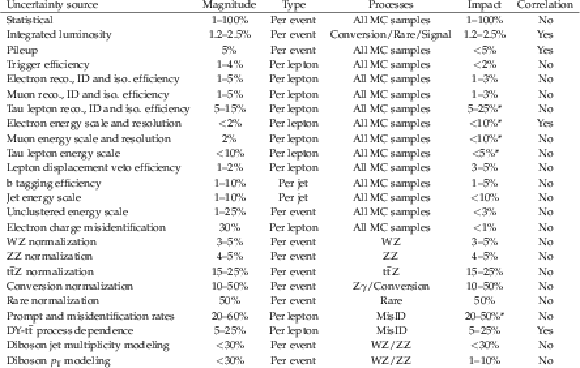
png pdf |
Table 4:
Sources, magnitudes, impacts, and correlation properties of systematic uncertainties in the signal regions. Magnitude refers to the relative change in the underlying uncertainty source, whereas impact quantifies the resultant relative change in the signal and background yields passing the event selection. Uncertainty sources marked as ``Yes'' under the Correlation column are correlated across the 3 years of data collection, and those marked with an asterisk in the Impact column are mass-dependent. |

png pdf |
Table 5:
A summary of model-dependent scenarios, and the corresponding subsets of SRs combined in the interpretations. |
| Summary |
| A search for beyond-the-standard-model phenomena producing resonant dilepton signatures of any flavor in multilepton events has been performed using pp collision data collected with the CMS detector at $ \sqrt{s} = $ 13 TeV, corresponding to an integrated luminosity of 138 fb$ ^{-1} $. The results provide direct and model independent constraints on the allowed parameter space for new spin-0 particles, $ \phi $, with scalar, pseudoscalar, or H-like couplings. The $ \phi $ bosons are assumed to be produced in association with a W or Z boson or a top quark-antiquark ($ \mathrm{t} \overline{\mathrm{t}} $) pair, and decay into $ \mathrm{e}\mathrm{e} $, $ \mu\mu $, or $ \tau\tau $ pairs. Constraints are calculated at 95% confidence level on the product of the production cross section and leptonic branching fraction of such bosons with masses in the range 15-350 GeV. No statistically significant excess is observed over the standard model background in the probed mass spectra. Over this mass range, the product of the cross section and branching fraction for the $ \tau\tau $ ($ \mathrm{e}\mathrm{e} $ and $ \mu\mu $) final states is excluded above 0.004-35, 0.004-80, and 0.008-250 pb (0.5-50, 0.5-30, and 1-200 fb) as a function of $ \phi $ mass for scalar, pseudoscalar, and H-like bosons, respectively. Several model-dependent interpretations have also been considered. The $ {{\mathrm{t}\overline{\mathrm{t}}} }{\phi} $ mode provides the first direct bounds on the coupling of the $ \phi $ boson to top quarks in the context of fermiophilic models. For a fermiophilic dilaton-like model with scalar couplings, the most stringent limit on the coupling is 0.63-0.66, obtained in the $ \phi $ mass range 40-60 GeV. For a fermiophilic axion-like model with pseudoscalar couplings, the most stringent limit on the coupling is 1.59, obtained for a $ \phi $ mass of 70 GeV. To constrain the Higgs-$ \phi $ mixing angle, $ \sin^2\theta $, in the case where the $ \phi $ is H-like, the independent $ {\mathrm{W}}{\phi} $, $ {\mathrm{Z}}{\phi} $, and $ {{\mathrm{t}\overline{\mathrm{t}}} }{\phi} $ signal regions are combined. The observed (expected) upper limit on $ \sin^2\theta $ is 1.2 (1.9) for a $ \phi $ mass of 125 GeV; the most stringent observed exclusion is obtained for a $ \phi $ mass of 30 GeV, corresponding to an upper limit on $ \sin^2\theta $ of 0.59 (0.64). |
| Additional Figures | |
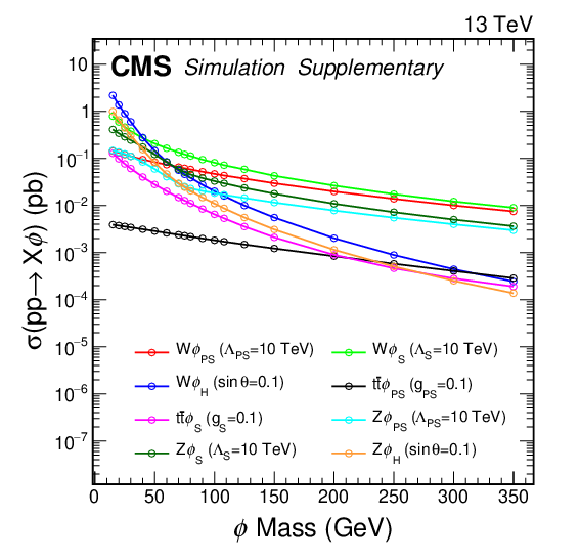
png pdf |
Additional Figure 1:
Cross section in units of pb for the $ {\mathrm{W}}{\phi} $, $ {\mathrm{Z}}{\phi} $, and $ {{\mathrm{t}\overline{\mathrm{t}}} }{\phi} $ signals as a function of the $ \phi $ boson mass in GeV. All cross sections are inclusive of all W, Z, $ {\mathrm{t}\overline{\mathrm{t}}} $ and $ \phi $ decay modes. |

png pdf |
Additional Figure 2:
The 95% confidence level observed upper limits on the product of $ \sigma({\mathrm{W}}{\phi}) $ and $ \mathcal{B}(\phi \to \ell\ell) $ for the $ {\mathrm{W}}{\phi} $ signal with scalar couplings, where $ \sigma $ denotes the production cross section and $ \mathcal{B}(\phi \to \ell\ell) $ is the branching fraction of the $ \phi $ boson into a lepton pair of given flavor. Exclusions on the dielectron, dimuon, and ditau decay scenarios of the $ \phi $ boson are shown with the green, blue, and orange solid lines, respectively. The red dash-dotted line is the theoretical prediction for $ \sigma\mathcal{B} $ of the $ {\mathrm{W}}{\phi} $ signal. The vertical gray band indicates the mass region not considered in the analysis in the dielectron and dimuon decay scenarios of the $ \phi $ boson. |

png pdf |
Additional Figure 3:
The 95% confidence level observed upper limits on the product of $ \sigma({\mathrm{W}}{\phi}) $ and $ \mathcal{B}(\phi \to \ell\ell) $ for the $ {\mathrm{W}}{\phi} $ signal with pseudoscalar couplings, where $ \sigma $ denotes the production cross section and $ \mathcal{B}(\phi \to \ell\ell) $ is the branching fraction of the $ \phi $ boson into a lepton pair of given flavor. Exclusions on the dielectron, dimuon, and ditau decay scenarios of the $ \phi $ boson are shown with the green, blue, and orange solid lines, respectively. The red dash-dotted line is the theoretical prediction for $ \sigma\mathcal{B} $ of the $ {\mathrm{W}}{\phi} $ signal. The vertical gray band indicates the mass region not considered in the analysis in the dielectron and dimuon decay scenarios of the $ \phi $ boson. |
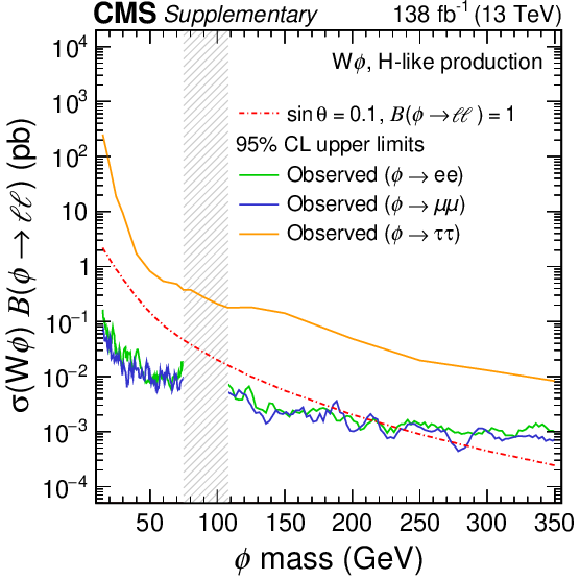
png pdf |
Additional Figure 4:
The 95% confidence level observed upper limits on the product of $ \sigma({\mathrm{W}}{\phi}) $ and $ \mathcal{B}(\phi \to \ell\ell) $ for the $ {\mathrm{W}}{\phi} $ signal with H-like production, where $ \sigma $ denotes the production cross section and $ \mathcal{B}(\phi \to \ell\ell) $ is the branching fraction of the $ \phi $ boson into a lepton pair of given flavor. Exclusions on the dielectron, dimuon, and ditau decay scenarios of the $ \phi $ boson are shown with the green, blue, and orange solid lines, respectively. The red dash-dotted line is the theoretical prediction for $ \sigma\mathcal{B} $ of the $ {\mathrm{W}}{\phi} $ signal. The vertical gray band indicates the mass region not considered in the analysis in the dielectron and dimuon decay scenarios of the $ \phi $ boson. |

png pdf |
Additional Figure 5:
The 95% confidence level observed upper limits on the product of $ \sigma({\mathrm{Z}}{\phi}) $ and $ \mathcal{B}(\phi \to \ell\ell) $ for the $ {\mathrm{Z}}{\phi} $ signal with scalar couplings, where $ \sigma $ denotes the production cross section and $ \mathcal{B}(\phi \to \ell\ell) $ is the branching fraction of the $ \phi $ boson into a lepton pair of given flavor. Exclusions on the dielectron, dimuon, and ditau decay scenarios of the $ \phi $ boson are shown with the green, blue, and orange solid lines, respectively. The red dash-dotted line is the theoretical prediction for $ \sigma\mathcal{B} $ of the $ {\mathrm{Z}}{\phi} $ signal. The vertical gray band indicates the mass region not considered in the analysis in the dielectron and dimuon decay scenarios of the $ \phi $ boson. |

png pdf |
Additional Figure 6:
The 95% confidence level observed upper limits on the product of $ \sigma({\mathrm{Z}}{\phi}) $ and $ \mathcal{B}(\phi \to \ell\ell) $ for the $ {\mathrm{Z}}{\phi} $ signal with pseudoscalar couplings, where $ \sigma $ denotes the production cross section and $ \mathcal{B}(\phi \to \ell\ell) $ is the branching fraction of the $ \phi $ boson into a lepton pair of given flavor. Exclusions on the dielectron, dimuon, and ditau decay scenarios of the $ \phi $ boson are shown with the green, blue, and orange solid lines, respectively. The red dash-dotted line is the theoretical prediction for $ \sigma\mathcal{B} $ of the $ {\mathrm{Z}}{\phi} $ signal. The vertical gray band indicates the mass region not considered in the analysis in the dielectron and dimuon decay scenarios of the $ \phi $ boson. |
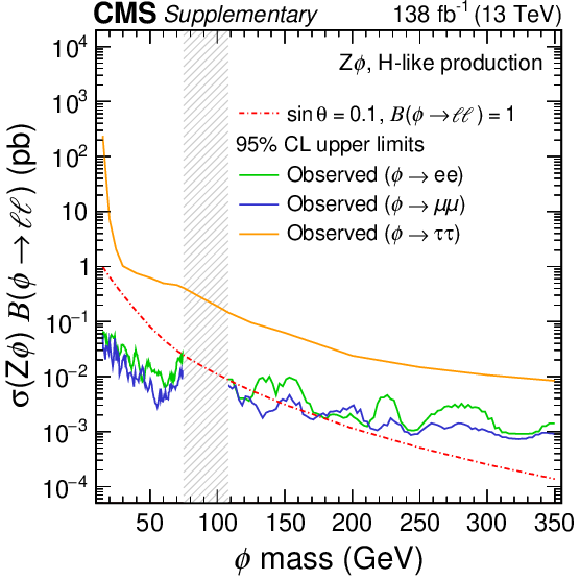
png pdf |
Additional Figure 7:
The 95% confidence level observed upper limits on the product of $ \sigma({\mathrm{Z}}{\phi}) $ and $ \mathcal{B}(\phi \to \ell\ell) $ for the $ {\mathrm{Z}}{\phi} $ signal with H-like production, where $ \sigma $ denotes the production cross section and $ \mathcal{B}(\phi \to \ell\ell) $ is the branching fraction of the $ \phi $ boson into a lepton pair of given flavor. Exclusions on the dielectron, dimuon, and ditau decay scenarios of the $ \phi $ boson are shown with the green, blue, and orange solid lines, respectively. The red dash-dotted line is the theoretical prediction for $ \sigma\mathcal{B} $ of the $ {\mathrm{Z}}{\phi} $ signal. The vertical gray band indicates the mass region not considered in the analysis in the dielectron and dimuon decay scenarios of the $ \phi $ boson. |
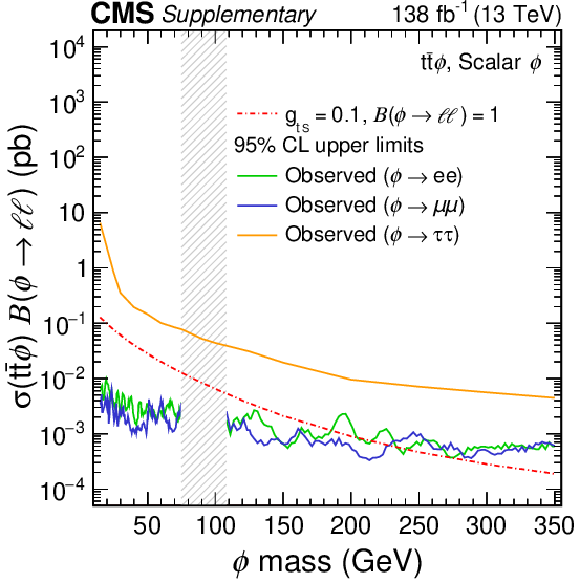
png pdf |
Additional Figure 8:
The 95% confidence level observed upper limits on the product of $ \sigma({{\mathrm{t}\overline{\mathrm{t}}} }{\phi}) $ and $ \mathcal{B}(\phi \to \ell\ell) $ for the $ {{\mathrm{t}\overline{\mathrm{t}}} }{\phi} $ signal with scalar couplings, where $ \sigma $ denotes the production cross section and $ \mathcal{B}(\phi \to \ell\ell) $ is the branching fraction of the $ \phi $ boson into a lepton pair of given flavor. Exclusions on the dielectron, dimuon, and ditau decay scenarios of the $ \phi $ boson are shown with the green, blue, and orange solid lines, respectively. The red dash-dotted line is the theoretical prediction for $ \sigma\mathcal{B} $ of the $ {{\mathrm{t}\overline{\mathrm{t}}} }{\phi} $ signal. The vertical gray band indicates the mass region not considered in the analysis in the dielectron and dimuon decay scenarios of the $ \phi $ boson. |

png pdf |
Additional Figure 9:
The 95% confidence level observed upper limits on the product of $ \sigma({{\mathrm{t}\overline{\mathrm{t}}} }{\phi}) $ and $ \mathcal{B}(\phi \to \ell\ell) $ for the $ {{\mathrm{t}\overline{\mathrm{t}}} }{\phi} $ signal with pseudoscalar couplings, where $ \sigma $ denotes the production cross section and $ \mathcal{B}(\phi \to \ell\ell) $ is the branching fraction of the $ \phi $ boson into a lepton pair of given flavor. Exclusions on the dielectron, dimuon, and ditau decay scenarios of the $ \phi $ boson are shown with the green, blue, and orange solid lines, respectively. The red dash-dotted line is the theoretical prediction for $ \sigma\mathcal{B} $ of the $ {{\mathrm{t}\overline{\mathrm{t}}} }{\phi} $ signal. The vertical gray band indicates the mass region not considered in the analysis in the dielectron and dimuon decay scenarios of the $ \phi $ boson. |
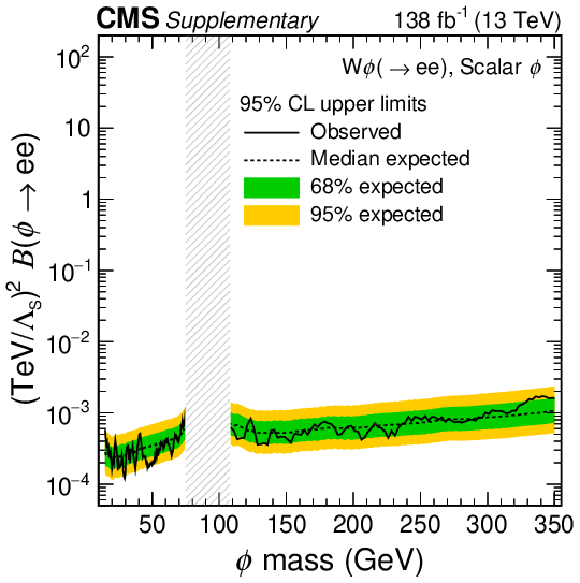
png pdf |
Additional Figure 10:
The 95% confidence level expected and observed upper limits on the product of $ (1/\Lambda_{\mathrm{S}})^2 $ and $ \mathcal{B}(\phi \to \mathrm{e}\mathrm{e}) $ of the $ {\mathrm{W}}{\phi} $ signal with scalar couplings, where $ \Lambda_{\mathrm{S}} $ denotes the mass scale of the effective interaction and $ \mathcal{B}(\phi \to \mathrm{e}\mathrm{e}) $ is the branching fraction of the $ \phi $ boson into an electron pair. The vertical gray band indicates the mass region not considered in the analysis. |
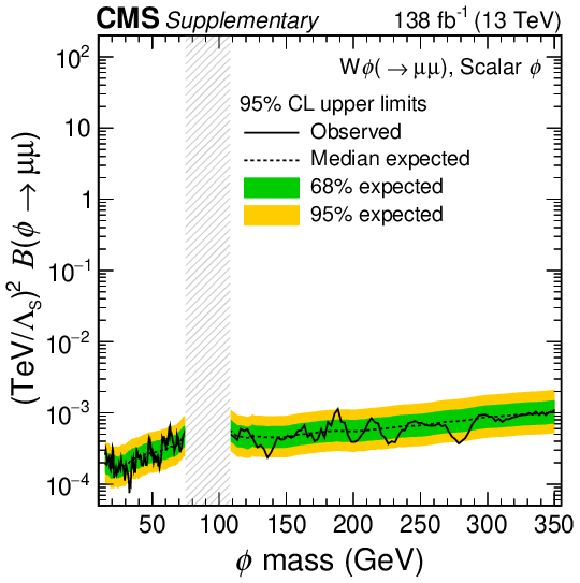
png pdf |
Additional Figure 11:
The 95% confidence level expected and observed upper limits on the product of $ (1/\Lambda_{\mathrm{S}})^2 $ and $ \mathcal{B}(\phi \to \mu\mu) $ of the $ {\mathrm{W}}{\phi} $ signal with scalar couplings, where $ \Lambda_{\mathrm{S}} $ denotes the mass scale of the effective interaction and $ \mathcal{B}(\phi \to \mu\mu) $ is the branching fraction of the $ \phi $ boson into a muon pair. The vertical gray band indicates the mass region not considered in the analysis. |
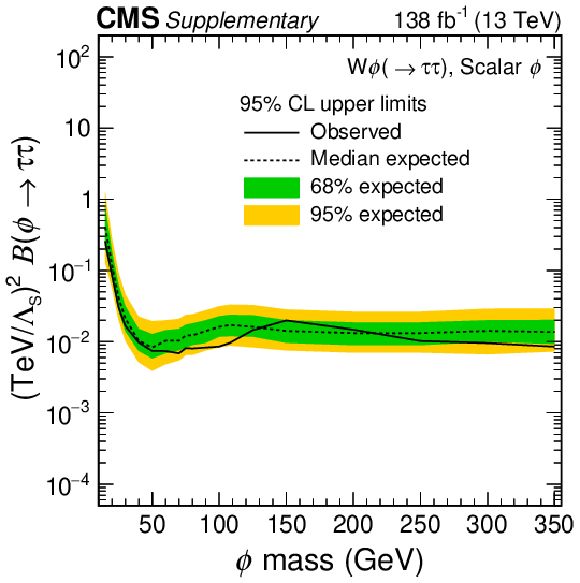
png pdf |
Additional Figure 12:
The 95% confidence level expected and observed upper limits on the product of $ (1/\Lambda_{\mathrm{S}})^2 $ and $ \mathcal{B}(\phi \to \tau\tau) $ of the $ {\mathrm{W}}{\phi} $ signal with scalar couplings, where $ \Lambda_{\mathrm{S}} $ denotes the mass scale of the effective interaction and $ \mathcal{B}(\phi \to \tau\tau) $ is the branching fraction of the $ \phi $ boson into a tau pair. |
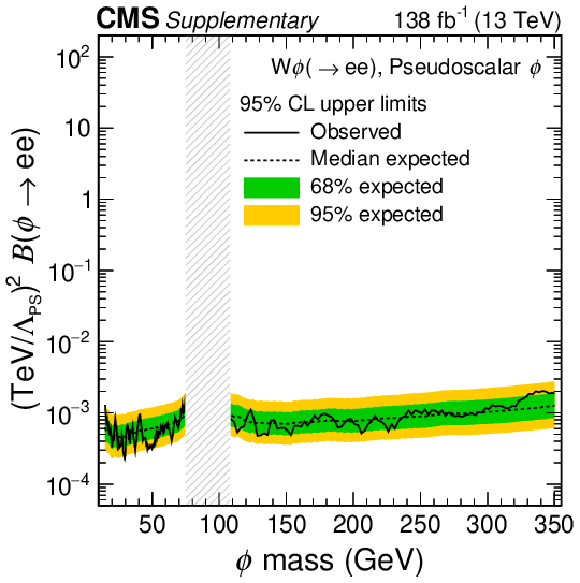
png pdf |
Additional Figure 13:
The 95% confidence level expected and observed upper limits on the product of $ (1/\Lambda_{\mathrm{PS}})^2 $ and $ \mathcal{B}(\phi \to \mathrm{e}\mathrm{e}) $ of the $ {\mathrm{W}}{\phi} $ signal with pseudoscalar couplings, where $ \Lambda_{\mathrm{PS}} $ denotes the mass scale of the effective interaction and $ \mathcal{B}(\phi \to \mathrm{e}\mathrm{e}) $ is the branching fraction of the $ \phi $ boson into an electron pair. The vertical gray band indicates the mass region not considered in the analysis. |

png pdf |
Additional Figure 14:
The 95% confidence level expected and observed upper limits on the product of $ (1/\Lambda_{\mathrm{PS}})^2 $ and $ \mathcal{B}(\phi \to \mu\mu) $ of the $ {\mathrm{W}}{\phi} $ signal with pseudoscalar couplings, where $ \Lambda_{\mathrm{PS}} $ denotes the mass scale of the effective interaction and $ \mathcal{B}(\phi \to \mu\mu) $ is the branching fraction of the $ \phi $ boson into a muon pair. The vertical gray band indicates the mass region not considered in the analysis. |
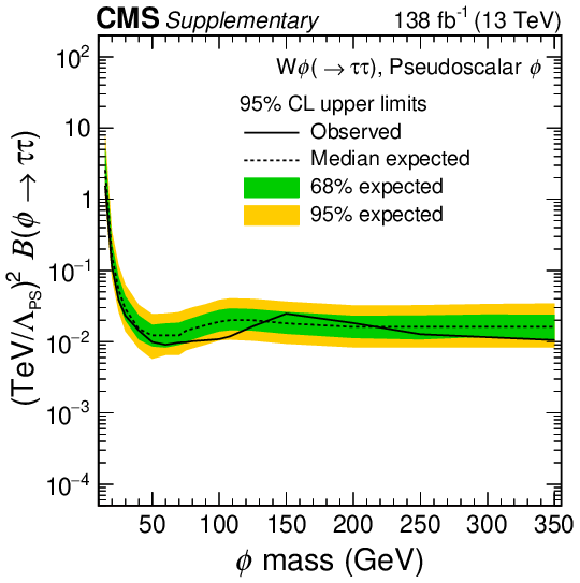
png pdf |
Additional Figure 15:
The 95% confidence level expected and observed upper limits on the product of $ (1/\Lambda_{\mathrm{PS}})^2 $ and $ \mathcal{B}(\phi \to \tau\tau) $ of the $ {\mathrm{W}}{\phi} $ signal with pseudoscalar couplings, where $ \Lambda_{\mathrm{PS}} $ denotes the mass scale of the effective interaction and $ \mathcal{B}(\phi \to \tau\tau) $ is the branching fraction of the $ \phi $ boson into a tau pair. |
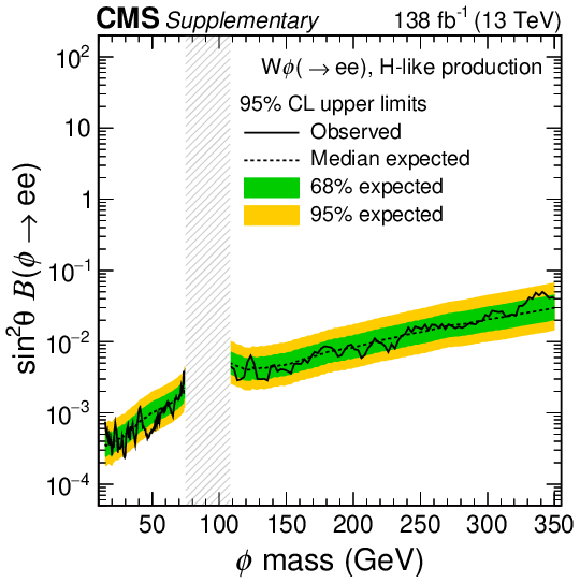
png pdf |
Additional Figure 16:
The 95% confidence level expected and observed upper limits on the product of $ \sin^2\theta $ and $ \mathcal{B}(\phi \to \mathrm{e}\mathrm{e}) $ of the $ {\mathrm{W}}{\phi} $ signal with H-like production, where $ \theta $ denotes the mixing angle of the Higgs boson with the $ \phi $ boson and $ \mathcal{B}(\phi \to \mathrm{e}\mathrm{e}) $ is the branching fraction of the $ \phi $ boson into an electron pair. The vertical gray band indicates the mass region not considered in the analysis. |

png pdf |
Additional Figure 17:
The 95% confidence level expected and observed upper limits on the product of $ \sin^2\theta $ and $ \mathcal{B}(\phi \to \mu\mu) $ of the $ {\mathrm{W}}{\phi} $ signal with H-like production, where $ \theta $ denotes the mixing angle of the Higgs boson with the $ \phi $ boson, and $ \mathcal{B}(\phi \to \mu\mu) $ is the branching fraction of the $ \phi $ boson into a muon pair. The vertical gray band indicates the mass region not considered in the analysis. |
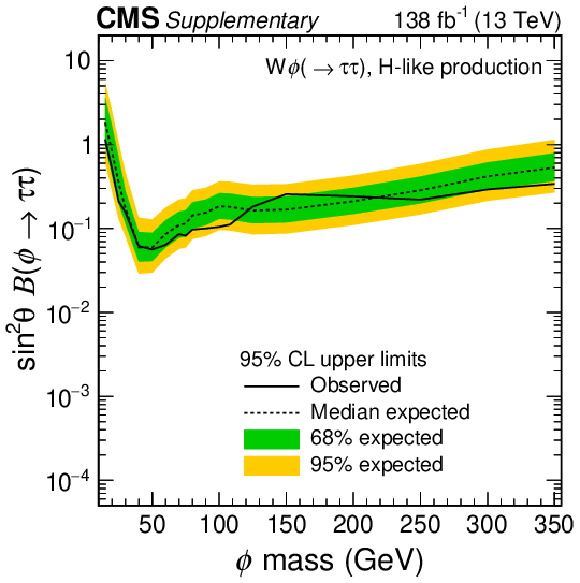
png pdf |
Additional Figure 18:
The 95% confidence level expected and observed upper limits on the product of $ \sin^2\theta $ and $ \mathcal{B}(\phi \to \tau\tau) $ of the $ {\mathrm{W}}{\phi} $ signal with H-like production, where $ \theta $ denotes the mixing angle of the Higgs boson with the $ \phi $ boson and $ \mathcal{B}(\phi \to \tau\tau) $ is the branching fraction of the $ \phi $ boson into a tau pair. |
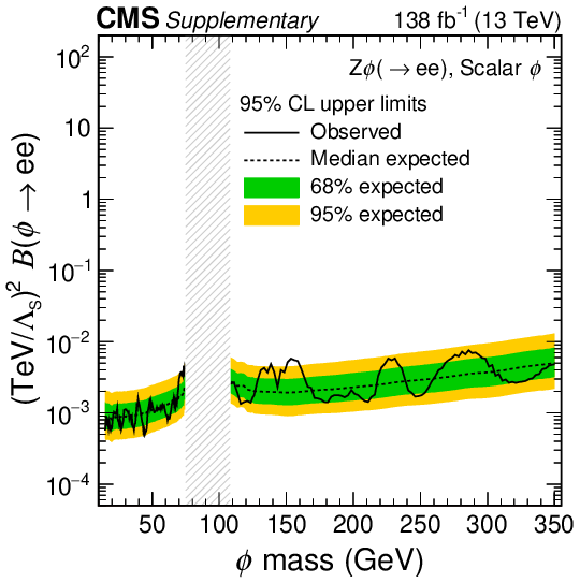
png pdf |
Additional Figure 19:
The 95% confidence level expected and observed upper limits on the product of $ (1/\Lambda_{\mathrm{S}})^2 $ and $ \mathcal{B}(\phi \to \mathrm{e}\mathrm{e}) $ of the $ {\mathrm{Z}}{\phi} $ signal with scalar couplings, where $ \Lambda_{\mathrm{S}} $ denotes the mass scale of the effective interaction and $ \mathcal{B}(\phi \to \mathrm{e}\mathrm{e}) $ is the branching fraction of the $ \phi $ boson into an electron pair. The vertical gray band indicates the mass region not considered in the analysis. |
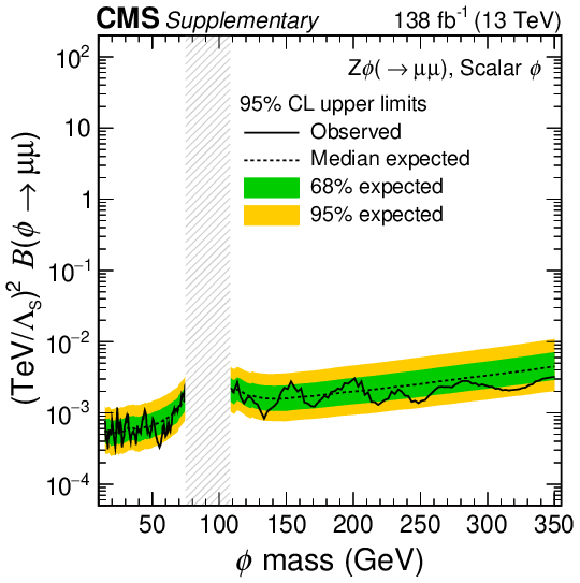
png pdf |
Additional Figure 20:
The 95% confidence level expected and observed upper limits on the product of $ (1/\Lambda_{\mathrm{S}})^2 $ and $ \mathcal{B}(\phi \to \mu\mu) $ of the $ {\mathrm{Z}}{\phi} $ signal with scalar couplings, where $ \Lambda_{\mathrm{S}} $ denotes the mass scale of the effective interaction and $ \mathcal{B}(\phi \to \mu\mu) $ is the branching fraction of the $ \phi $ boson into a muon pair. The vertical gray band indicates the mass region not considered in the analysis. |
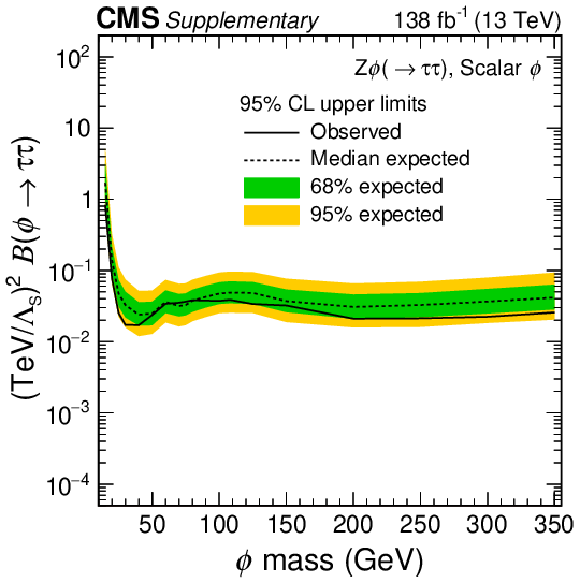
png pdf |
Additional Figure 21:
The 95% confidence level expected and observed upper limits on the product of $ (1/\Lambda_{\mathrm{S}})^2 $ and $ \mathcal{B}(\phi \to \tau\tau) $ of the $ {\mathrm{Z}}{\phi} $ signal with scalar couplings, where $ \Lambda_{\mathrm{S}} $ denotes the mass scale of the effective interaction and $ \mathcal{B}(\phi \to \tau\tau) $ is the branching fraction of the $ \phi $ boson into a tau pair. |
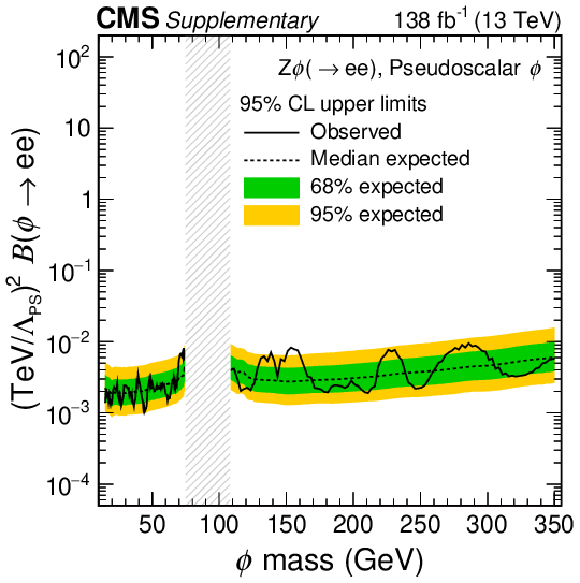
png pdf |
Additional Figure 22:
The 95% confidence level expected and observed upper limits on the product of $ (1/\Lambda_{\mathrm{PS}})^2 $ and $ \mathcal{B}(\phi \to \mathrm{e}\mathrm{e}) $ of the $ {\mathrm{Z}}{\phi} $ signal with pseudoscalar couplings, where $ \Lambda_{\mathrm{S}} $ denotes the mass scale of the effective interaction and $ \mathcal{B}(\phi \to \mathrm{e}\mathrm{e}) $ is the branching fraction of the $ \phi $ boson into an electron pair. The vertical gray band indicates the mass region not considered in the analysis. |

png pdf |
Additional Figure 23:
The 95% confidence level expected and observed upper limits on the product of $ (1/\Lambda_{\mathrm{PS}})^2 $ and $ \mathcal{B}(\phi \to \mu\mu) $ of the $ {\mathrm{Z}}{\phi} $ signal with pseudoscalar couplings, where $ \Lambda_{\mathrm{PS}} $ denotes the mass scale of the effective interaction and $ \mathcal{B}(\phi \to \mu\mu) $ is the branching fraction of the $ \phi $ boson into a muon pair. The vertical gray band indicates the mass region not considered in the analysis. |
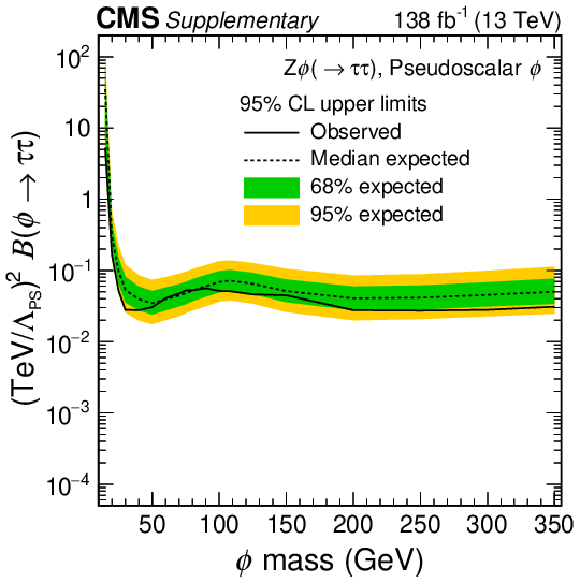
png pdf |
Additional Figure 24:
The 95% confidence level expected and observed upper limits on the product of $ (1/\Lambda_{\mathrm{PS}})^2 $ and $ \mathcal{B}(\phi \to \tau\tau) $ of the $ {\mathrm{Z}}{\phi} $ signal with pseudoscalar couplings, where $ \Lambda_{\mathrm{PS}} $ denotes the mass scale of the effective interaction and $ \mathcal{B}(\phi \to \tau\tau) $ is the branching fraction of the $ \phi $ boson into a tau pair. |

png pdf |
Additional Figure 25:
The 95% confidence level expected and observed upper limits on the product of $ \sin^2\theta $ and $ \mathcal{B}(\phi \to \mathrm{e}\mathrm{e}) $ of the $ {\mathrm{Z}}{\phi} $ signal with H-like production, where $ \theta $ denotes the mixing angle of the Higgs boson with the $ \phi $ boson and $ \mathcal{B}(\phi \to \mathrm{e}\mathrm{e}) $ is the branching fraction of the $ \phi $ boson into an electron pair. The vertical gray band indicates the mass region not considered in the analysis. |

png pdf |
Additional Figure 26:
The 95% confidence level expected and observed upper limits on the product of $ \sin^2\theta $ and $ \mathcal{B}(\phi \to \mu\mu) $ of the $ {\mathrm{Z}}{\phi} $ signal with H-like production, where $ \theta $ denotes the mixing angle of the Higgs boson with the $ \phi $ boson and $ \mathcal{B}(\phi \to \mu\mu) $ is the branching fraction of the $ \phi $ boson into a muon pair. The vertical gray band indicates the mass region not considered in the analysis. |

png pdf |
Additional Figure 27:
The 95% confidence level expected and observed upper limits on the product of $ \sin^2\theta $ and $ \mathcal{B}(\phi \to \tau\tau) $ of the $ {\mathrm{Z}}{\phi} $ signal with H-like production, where $ \theta $ denotes the mixing angle of the Higgs boson with the $ \phi $ boson and $ \mathcal{B}(\phi \to \tau\tau) $ is the branching fraction of the $ \phi $ boson into a tau pair. |

png pdf |
Additional Figure 28:
The 95% confidence level expected and observed upper limits on the product of $ {\mathrm{g}}_{{\mathrm{t S}}}^2 $ and $ \mathcal{B}(\phi \to \mathrm{e}\mathrm{e}) $ of the $ {{\mathrm{t}\overline{\mathrm{t}}} }{\phi} $ signal with scalar couplings, where $ {\mathrm{g}}_{{\mathrm{t S}}} $ denotes the coupling of the $ \phi $ boson to the top quark and $ \mathcal{B}(\phi \to \mathrm{e}\mathrm{e}) $ is the branching fraction of the $ \phi $ boson into an electron pair. The vertical gray band indicates the mass region not considered in the analysis. |
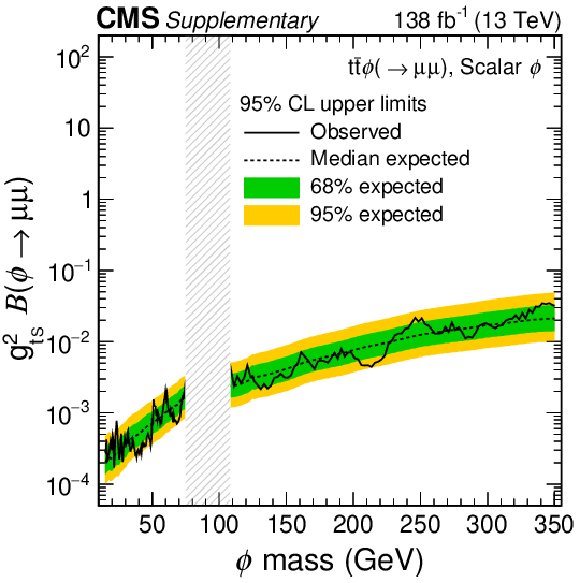
png pdf |
Additional Figure 29:
The 95% confidence level expected and observed upper limits on the product of $ {\mathrm{g}}_{{\mathrm{t S}}}^2 $ and $ \mathcal{B}(\phi \to \mu\mu) $ of the $ {{\mathrm{t}\overline{\mathrm{t}}} }{\phi} $ signal with scalar couplings, where $ {\mathrm{g}}_{{\mathrm{t S}}} $ denotes the coupling of the $ \phi $ boson to the top quark and $ \mathcal{B}(\phi \to \mu\mu) $ is the branching fraction of the $ \phi $ boson into a muon pair. The vertical gray band indicates the mass region not considered in the analysis. |
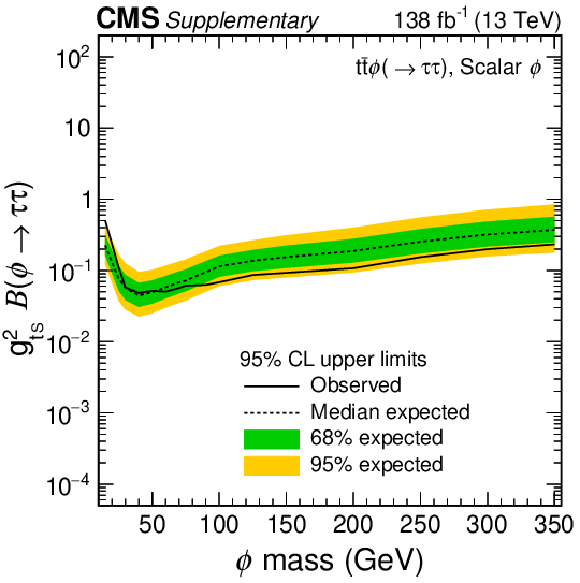
png pdf |
Additional Figure 30:
The 95% confidence level expected and observed upper limits on the product of $ {\mathrm{g}}_{{\mathrm{t S}}}^2 $ and $ \mathcal{B}(\phi \to \tau\tau) $ of the $ {{\mathrm{t}\overline{\mathrm{t}}} }{\phi} $ signal with scalar couplings, where $ {\mathrm{g}}_{{\mathrm{t S}}} $ denotes the coupling of the $ \phi $ boson to the top quark and $ \mathcal{B}(\phi \to \tau\tau) $ is the branching fraction of the $ \phi $ boson into a ditau pair. |
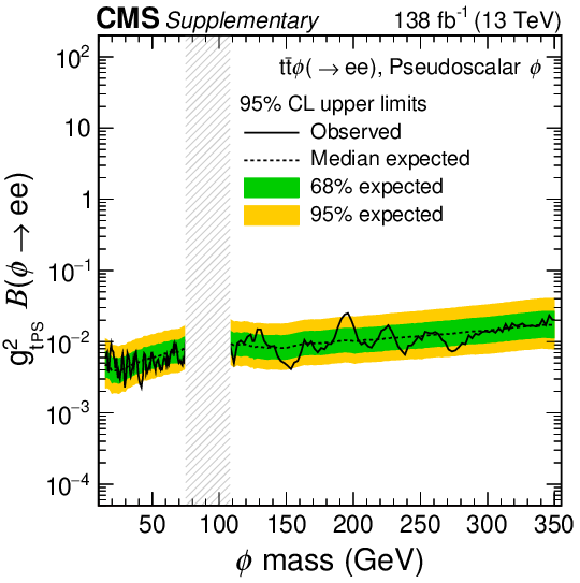
png pdf |
Additional Figure 31:
The 95% confidence level expected and observed upper limits on the product of $ {\mathrm{g}}_{{\mathrm{t PS}}}^2 $ and $ \mathcal{B}(\phi \to \mathrm{e}\mathrm{e}) $ of the $ {{\mathrm{t}\overline{\mathrm{t}}} }{\phi} $ signal with pseudoscalar couplings, where $ {\mathrm{g}}_{{\mathrm{t PS}}} $ denotes the coupling of the $ \phi $ boson to the top quark and $ \mathcal{B}(\phi \to \mathrm{e}\mathrm{e}) $ is the branching fraction of the $ \phi $ boson into an electron pair. The vertical gray band indicates the mass region not considered in the analysis. |
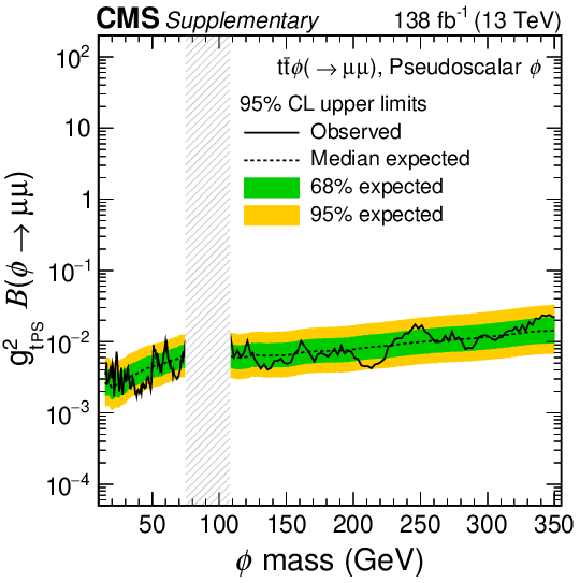
png pdf |
Additional Figure 32:
The 95% confidence level expected and observed upper limits on the product of $ {\mathrm{g}}_{{\mathrm{t PS}}}^2 $ and $ \mathcal{B}(\phi \to \mu\mu) $ of the $ {{\mathrm{t}\overline{\mathrm{t}}} }{\phi} $ signal with pseudoscalar couplings, where $ {\mathrm{g}}_{{\mathrm{t PS}}} $ denotes the coupling of the $ \phi $ boson to the top quark and $ \mathcal{B}(\phi \to \mu\mu) $ is the branching fraction of the $ \phi $ boson into a muon pair. The vertical gray band indicates the mass region not considered in the analysis. |
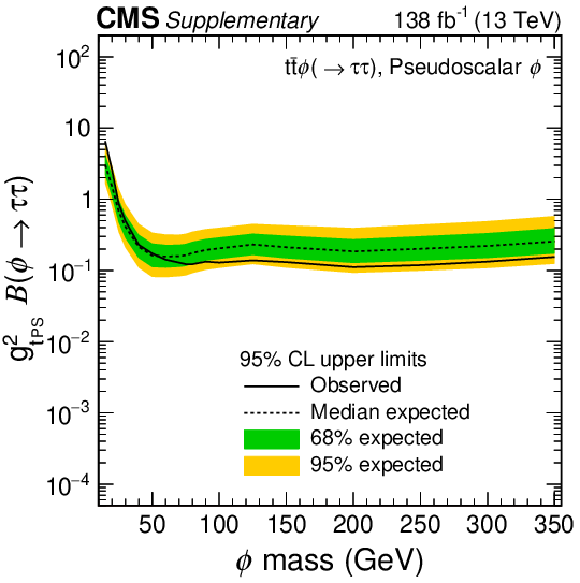
png pdf |
Additional Figure 33:
The 95% confidence level expected and observed upper limits on the product of $ {\mathrm{g}}_{{\mathrm{t PS}}}^2 $ and $ \mathcal{B}(\phi \to \tau\tau) $ of the $ {{\mathrm{t}\overline{\mathrm{t}}} }{\phi} $ signal with pseudoscalar couplings, where $ {\mathrm{g}}_{{\mathrm{t PS}}} $ denotes the coupling of the $ \phi $ boson to the top quark and $ \mathcal{B}(\phi \to \tau\tau) $ is the branching fraction of the $ \phi $ boson into a tau pair. |
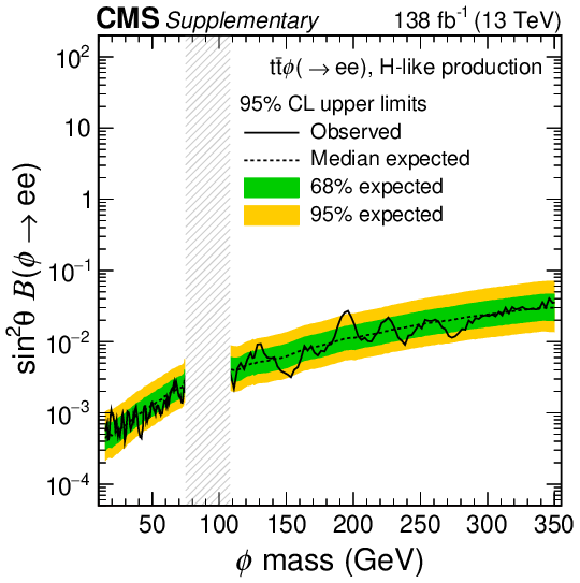
png pdf |
Additional Figure 34:
The 95% confidence level expected and observed upper limits on the product of $ \sin^2\theta $ and $ \mathcal{B}(\phi \to \mathrm{e}\mathrm{e}) $ of the $ {{\mathrm{t}\overline{\mathrm{t}}} }{\phi} $ signal with H-like production, where $ \theta $ denotes the mixing angle of the Higgs boson with the $ \phi $ boson and $ \mathcal{B}(\phi \to \mathrm{e}\mathrm{e}) $ is the branching fraction of the $ \phi $ boson into an electron pair. The vertical gray band indicates the mass region not considered in the analysis. |
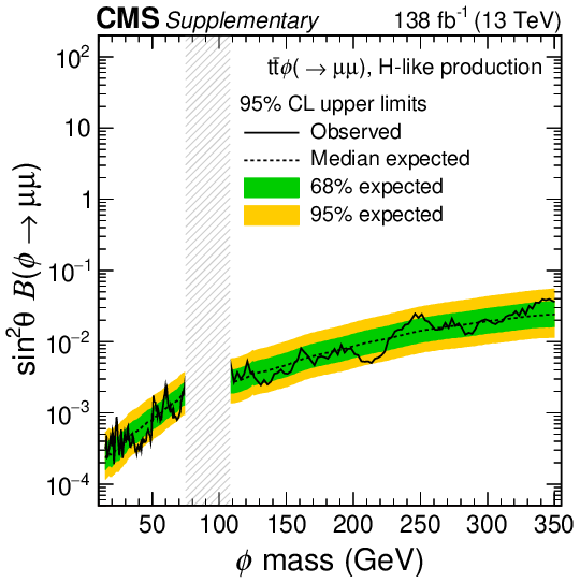
png pdf |
Additional Figure 35:
The 95% confidence level expected and observed upper limits on the product of $ \sin^2\theta $ and $ \mathcal{B}(\phi \to \mu\mu) $ of the $ {{\mathrm{t}\overline{\mathrm{t}}} }{\phi} $ signal with H-like production, where $ \theta $ denotes the mixing angle of the Higgs boson with the $ \phi $ boson and $ \mathcal{B}(\phi \to \mu\mu) $ is the branching fraction of the $ \phi $ boson into a muon pair. The vertical gray band indicates the mass region not considered in the analysis. |

png pdf |
Additional Figure 36:
The 95% confidence level expected and observed upper limits on the product of $ \sin^2\theta $ and $ \mathcal{B}(\phi \to \tau\tau) $ of the $ {{\mathrm{t}\overline{\mathrm{t}}} }{\phi} $ signal with H-like production, where $ \theta $ denotes the mixing angle of the Higgs boson with the $ \phi $ boson and $ \mathcal{B}(\phi \to \tau\tau) $ is the branching fraction of the $ \phi $ boson into a tau pair. |
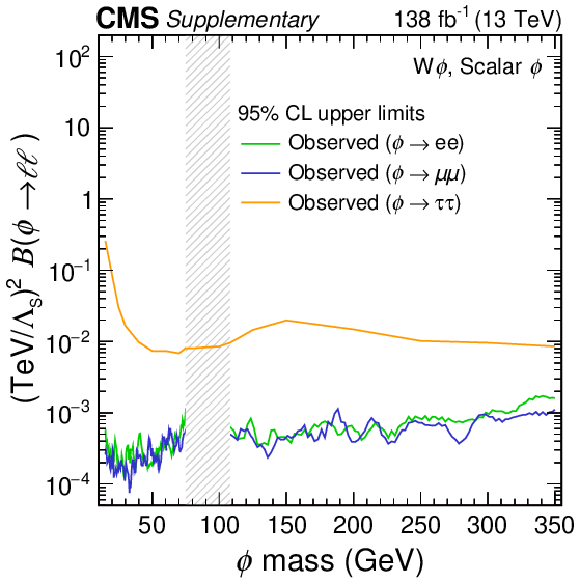
png pdf |
Additional Figure 37:
The 95% confidence level observed upper limits on the product of $ (1/\Lambda_{\mathrm{S}})^2 $ and $ \mathcal{B}(\phi \to \ell\ell) $ of the $ {\mathrm{W}}{\phi} $ signal with scalar couplings, where $ \Lambda_{\mathrm{S}} $ denotes the mass scale of the effective interaction and $ \mathcal{B}(\phi \to \ell\ell) $ is the branching fraction of the $ \phi $ boson into a lepton pair of given flavor. Exclusions on the dielectron, dimuon, and ditau decay scenarios of the $ \phi $ boson are shown with the green, blue, and orange solid lines. The vertical gray band indicates the mass region not considered in the analysis in the dielectron and dimuon decay scenarios of the $ \phi $ boson. |

png pdf |
Additional Figure 38:
The 95% confidence level observed upper limits on the product of $ (1/\Lambda_{\mathrm{PS}})^2 $ and $ \mathcal{B}(\phi \to \ell\ell) $ of the $ {\mathrm{W}}{\phi} $ signal with pseudoscalar couplings, where $ \Lambda_{\mathrm{PS}} $ denotes the mass scale of the effective interaction and $ \mathcal{B}(\phi \to \ell\ell) $ is the branching fraction of the $ \phi $ boson into a lepton pair of given flavor. Exclusions on the dielectron, dimuon, and ditau decay scenarios of the $ \phi $ boson are shown with the green, blue, and orange solid lines. The vertical gray band indicates the mass region not considered in the analysis in the dielectron and dimuon decay scenarios of the $ \phi $ boson. |
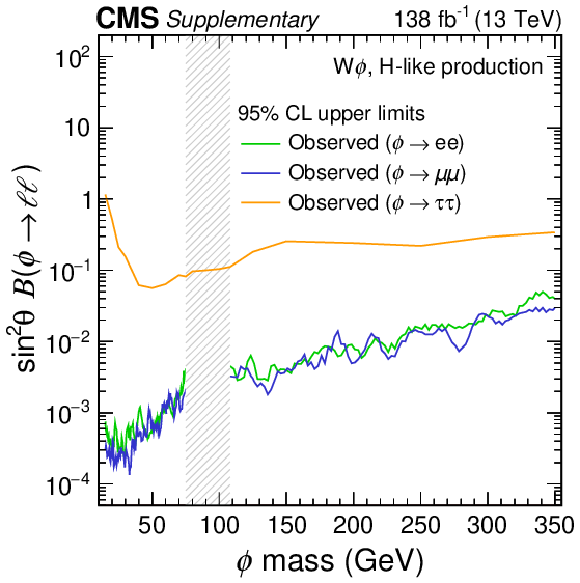
png pdf |
Additional Figure 39:
The 95% confidence level observed upper limits on the product of $ \sin^2\theta $ and $ \mathcal{B}(\phi \to \ell\ell) $ of the $ {\mathrm{W}}{\phi} $ signal with H-like production, where $ \theta $ denotes the mixing angle of the Higgs boson with the $ \phi $ boson and $ \mathcal{B}(\phi \to \ell\ell) $ is the branching fraction of the $ \phi $ boson into a lepton pair of given flavor. Exclusions on the dielectron, dimuon, and ditau decay scenarios of the $ \phi $ boson are shown with the green, blue, and orange solid lines, respectively. The vertical gray band indicates the mass region not considered in the analysis in the dielectron and dimuon decay scenarios of the $ \phi $ boson. |

png pdf |
Additional Figure 40:
The 95% confidence level observed upper limits on the product of $ (1/\Lambda_{\mathrm{S}})^2 $ and $ \mathcal{B}(\phi \to \ell\ell) $ of the $ {\mathrm{Z}}{\phi} $ signal with scalar couplings, where $ \Lambda_{\mathrm{S}} $ denotes the mass scale of the effective interaction, and $ \mathcal{B}(\phi \to \ell\ell) $ is the branching fraction of the $ \phi $ boson into a lepton pair of given flavor. Exclusions on the dielectron, dimuon, and ditau decay scenarios of the $ \phi $ boson are shown with the green, blue, and orange solid lines, respectively. The vertical gray band indicates the mass region not considered in the analysis in the dielectron and dimuon decay scenarios of the $ \phi $ boson. |
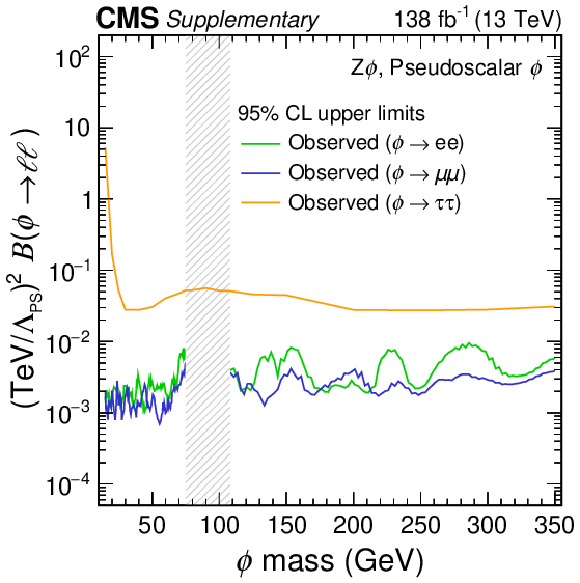
png pdf |
Additional Figure 41:
The 95% confidence level observed upper limits on the product of $ (1/\Lambda_{\mathrm{PS}})^2 $ and $ \mathcal{B}(\phi \to \ell\ell) $ of the $ {\mathrm{Z}}{\phi} $ signal with pseudoscalar couplings, where $ \Lambda_{\mathrm{PS}} $ denotes the mass scale of the effective interaction and $ \mathcal{B}(\phi \to \ell\ell) $ is the branching fraction of the $ \phi $ boson into a lepton pair of given flavor. Exclusions on the dielectron, dimuon, and ditau decay scenarios of the $ \phi $ boson are shown with the green, blue, and orange solid lines, respectively. The vertical gray band indicates the mass region not considered in the analysis in the dielectron and dimuon decay scenarios of the $ \phi $ boson. |
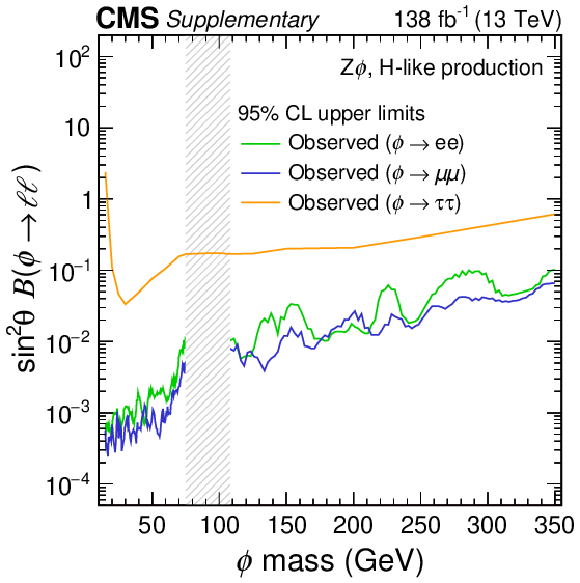
png pdf |
Additional Figure 42:
The 95% confidence level observed upper limits on the product of $ \sin^2\theta $ and $ \mathcal{B}(\phi \to \ell\ell) $ of the $ {\mathrm{Z}}{\phi} $ signal with H-like production, where $ \theta $ denotes the mixing angle of the Higgs boson with the $ \phi $ boson and $ \mathcal{B}(\phi \to \ell\ell) $ is the branching fraction of the $ \phi $ boson into a lepton pair of given flavor. Exclusions on the dielectron, dimuon, and ditau decay scenarios of the $ \phi $ boson are shown with the green, blue, and orange solid lines, respectively. The vertical gray band indicates the mass region not considered in the analysis in the dielectron and dimuon decay scenarios of the $ \phi $ boson. |

png pdf |
Additional Figure 43:
The 95% confidence level observed upper limits on the product of $ {\mathrm{g}}_{{\mathrm{t S}}}^2 $ and $ \mathcal{B}(\phi \to \ell\ell) $ of the $ {{\mathrm{t}\overline{\mathrm{t}}} }{\phi} $ signal with scalar couplings, where $ {\mathrm{g}}_{{\mathrm{t S}}} $ denotes the coupling of the $ \phi $ boson to the top quark and $ \mathcal{B}(\phi \to \ell\ell) $ is the branching fraction of the $ \phi $ boson into a lepton pair of given flavor. Exclusions on the dielectron, dimuon, and ditau decay scenarios of the $ \phi $ boson are shown with the green, blue, and orange solid lines, respectively. The vertical gray band indicates the mass region not considered in the analysis in the dielectron and dimuon decay scenarios of the $ \phi $ boson. |
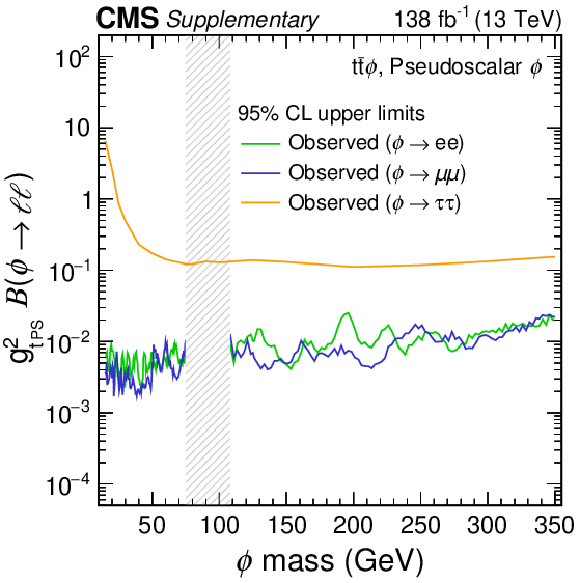
png pdf |
Additional Figure 44:
The 95% confidence level observed upper limits on the product of $ {\mathrm{g}}_{{\mathrm{t PS}}}^2 $ and $ \mathcal{B}(\phi \to \ell\ell) $ of the $ {{\mathrm{t}\overline{\mathrm{t}}} }{\phi} $ signal with pseudoscalar couplings, where $ {\mathrm{g}}_{{\mathrm{t PS}}} $ denotes the coupling of the $ \phi $ boson to the top quark and $ \mathcal{B}(\phi \to \ell\ell) $ is the branching fraction of the $ \phi $ boson into a lepton pair of given flavor. Exclusions on the dielectron, dimuon, and ditau decay scenarios of the $ \phi $ boson are shown with the green, blue, and orange solid lines, respectively. The vertical gray band indicates the mass region not considered in the analysis in the dielectron and dimuon decay scenarios of the $ \phi $ boson. |
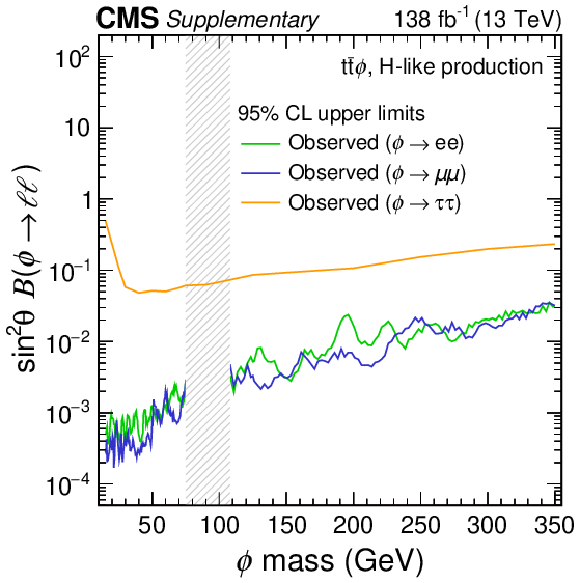
png pdf |
Additional Figure 45:
The 95% confidence level observed upper limits on the product of $ \sin^2\theta $ and $ \mathcal{B}(\phi \to \ell\ell) $ of the $ {{\mathrm{t}\overline{\mathrm{t}}} }{\phi} $ signal with H-like production, where $ \theta $ denotes the mixing angle of the Higgs boson with the $ \phi $ boson and $ \mathcal{B}(\phi \to \ell\ell) $ is the branching fraction of the $ \phi $ boson into a lepton pair of given flavor. Exclusions on the dielectron, dimuon, and ditau decay scenarios of the $ \phi $ boson are shown with the green, blue, and orange solid lines, respectively. The vertical gray band indicates the mass region not considered in the analysis in the dielectron and dimuon decay scenarios of the $ \phi $ boson. |

png pdf |
Additional Figure 46:
The product of acceptance and efficiency, $ {\mathrm{A}}\varepsilon $, for a scalar $ \phi $ boson in the $ {\mathrm{W}}{\phi} $ signal (with leptonic W decay) in each signal region in the dielectron decay scenario. Each value is computed as the ratio of the number of simulated signal events passing all selection criteria to the total number of simulated signal events, and includes the data-to-simulation correction factors described in the paper. |
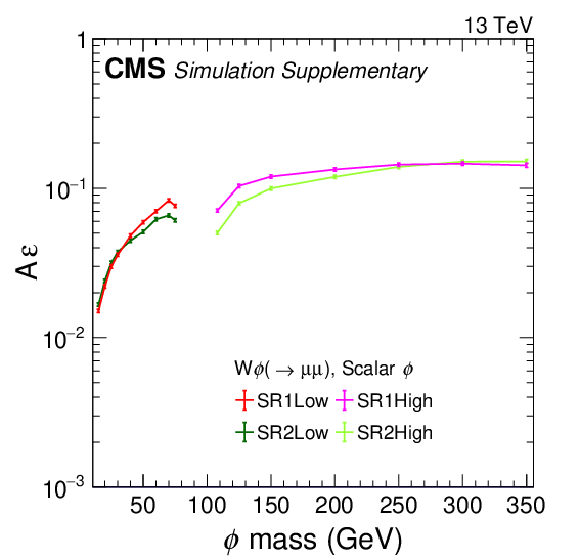
png pdf |
Additional Figure 47:
The product of acceptance and efficiency, $ {\mathrm{A}}\varepsilon $, for a scalar $ \phi $ boson in the $ {\mathrm{W}}{\phi} $ signal (with leptonic W decay) in each signal region in the dimuon decay scenario. Each value is computed as the ratio of the number of simulated signal events passing all selection criteria to the total number of simulated signal events, and includes the data-to-simulation correction factors described in the paper. |
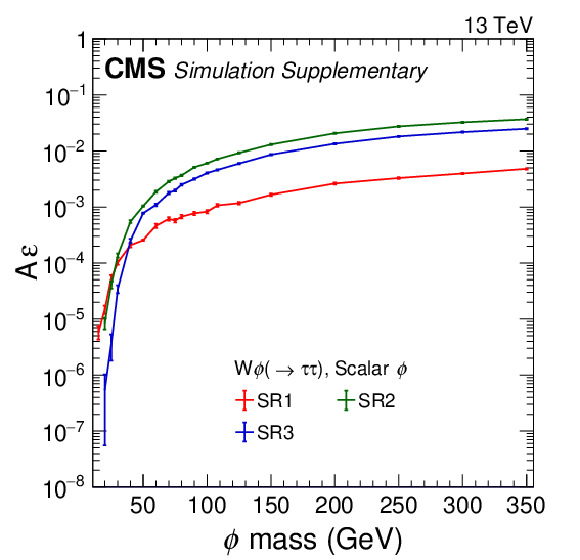
png pdf |
Additional Figure 48:
The product of acceptance and efficiency, $ {\mathrm{A}}\varepsilon $, for a scalar $ \phi $ boson in the $ {\mathrm{W}}{\phi} $ signal (with leptonic W decay) in each signal region in the ditau decay scenario. Each value is computed as the ratio of the number of simulated signal events passing all selection criteria to the total number of simulated signal events, and includes the data-to-simulation correction factors described in the paper. |
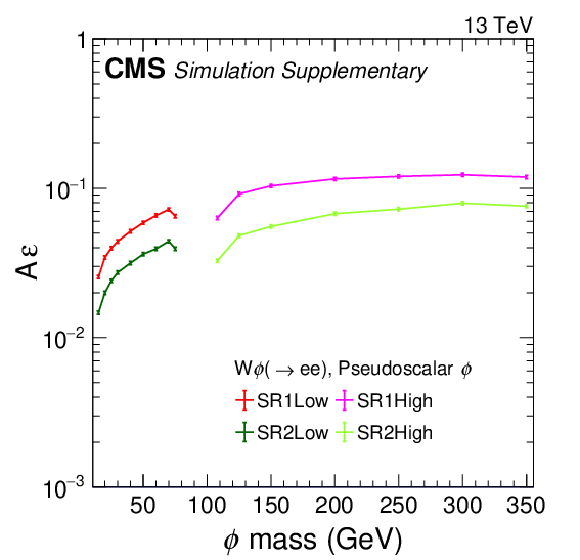
png pdf |
Additional Figure 49:
The product of acceptance and efficiency, $ {\mathrm{A}}\varepsilon $, for a pseudoscalar $ \phi $ boson in the $ {\mathrm{W}}{\phi} $ signal (with leptonic W decay) in each signal region in the dielectron decay scenario. Each value is computed as the ratio of the number of simulated signal events passing all selection criteria to the total number of simulated signal events, and includes the data-to-simulation correction factors described in the paper. |
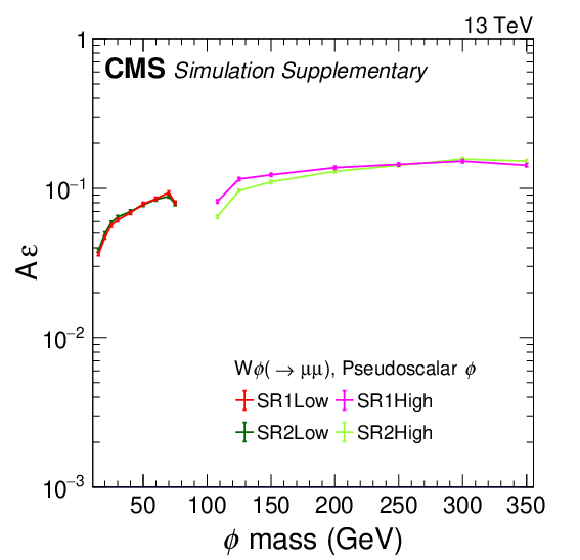
png pdf |
Additional Figure 50:
The product of acceptance and efficiency, $ {\mathrm{A}}\varepsilon $, for a pseudoscalar $ \phi $ boson in the $ {\mathrm{W}}{\phi} $ signal (with leptonic W decay) in each signal region in the dimuon decay scenario. Each value is computed as the ratio of the number of simulated signal events passing all selection criteria to the total number of simulated signal events, and includes the data-to-simulation correction factors described in the paper. |
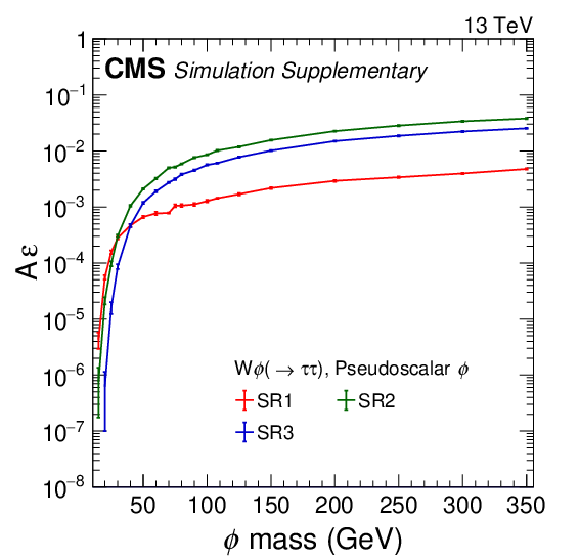
png pdf |
Additional Figure 51:
The product of acceptance and efficiency, $ {\mathrm{A}}\varepsilon $, for a pseudoscalar $ \phi $ boson in the $ {\mathrm{W}}{\phi} $ signal (with leptonic W decay) in each signal region in the ditau decay scenario. Each value is computed as the ratio of the number of simulated signal events passing all selection criteria to the total number of simulated signal events, and includes the data-to-simulation correction factors described in the paper. |
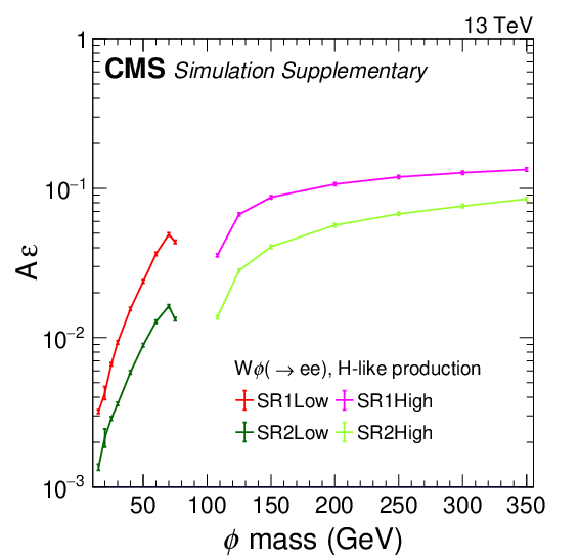
png pdf |
Additional Figure 52:
The product of acceptance and efficiency, $ {\mathrm{A}}\varepsilon $, for an H-like $ \phi $ boson in the $ {\mathrm{W}}{\phi} $ signal (with leptonic W decay) in each signal region in the dielectron decay scenario. Each value is computed as the ratio of the number of simulated signal events passing all selection criteria to the total number of simulated signal events, and includes the data-to-simulation correction factors described in the paper. |

png pdf |
Additional Figure 53:
The product of acceptance and efficiency, $ {\mathrm{A}}\varepsilon $, for an H-like $ \phi $ boson in the $ {\mathrm{W}}{\phi} $ signal (with leptonic W decay) in each signal region in the dimuon decay scenario. Each value is computed as the ratio of the number of simulated signal events passing all selection criteria to the total number of simulated signal events, and includes the data-to-simulation correction factors described in the paper. |
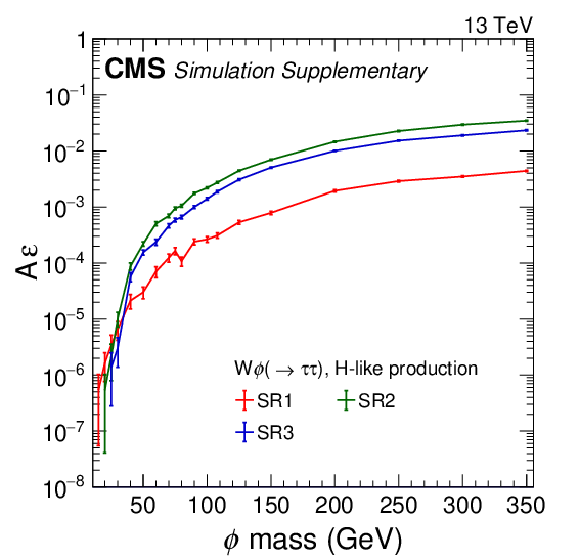
png pdf |
Additional Figure 54:
The product of acceptance and efficiency, $ {\mathrm{A}}\varepsilon $, for an H-like $ \phi $ boson in the $ {\mathrm{W}}{\phi} $ signal (with leptonic W decay) in each signal region in the ditau decay scenario. Each value is computed as the ratio of the number of simulated signal events passing all selection criteria to the total number of simulated signal events, and includes the data-to-simulation correction factors described in the paper. |

png pdf |
Additional Figure 55:
The product of acceptance and efficiency, $ {\mathrm{A}}\varepsilon $, for a scalar $ \phi $ boson in the $ {\mathrm{Z}}{\phi} $ signal (with leptonic Z decay) in each signal region in the dielectron decay scenario. Each value is computed as the ratio of the number of simulated signal events passing all selection criteria to the total number of simulated signal events, and includes the data-to-simulation correction factors described in the paper. |

png pdf |
Additional Figure 56:
The product of acceptance and efficiency, $ {\mathrm{A}}\varepsilon $, for a scalar $ \phi $ boson in the $ {\mathrm{Z}}{\phi} $ signal (with leptonic Z decay) in each signal region in the dimuon decay scenario. Each value is computed as the ratio of the number of simulated signal events passing all selection criteria to the total number of simulated signal events, and includes the data-to-simulation correction factors described in the paper. |

png pdf |
Additional Figure 57:
The product of acceptance and efficiency, $ {\mathrm{A}}\varepsilon $, for a scalar $ \phi $ boson in the $ {\mathrm{Z}}{\phi} $ signal (with leptonic Z decay) in each signal region in the ditau decay scenario. Each value is computed as the ratio of the number of simulated signal events passing all selection criteria to the total number of simulated signal events, and includes the data-to-simulation correction factors described in the paper. |

png pdf |
Additional Figure 58:
The product of acceptance and efficiency, $ {\mathrm{A}}\varepsilon $, for a pseudoscalar $ \phi $ boson in the $ {\mathrm{Z}}{\phi} $ signal (with leptonic Z decay) in each signal region in the dielectron decay scenario. Each value is computed as the ratio of the number of simulated signal events passing all selection criteria to the total number of simulated signal events, and includes the data-to-simulation correction factors described in the paper. |
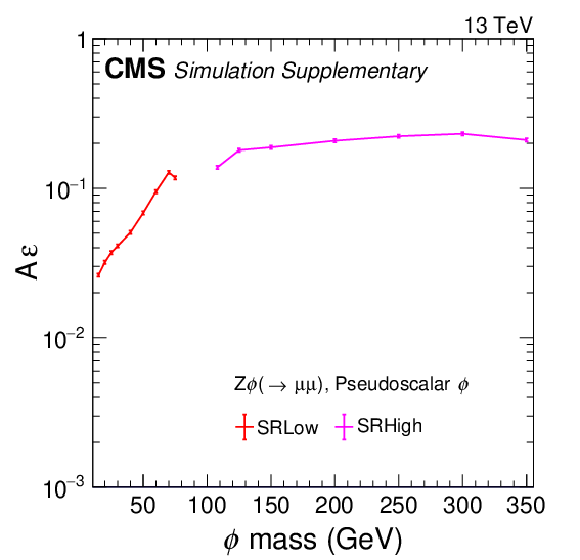
png pdf |
Additional Figure 59:
The product of acceptance and efficiency, $ {\mathrm{A}}\varepsilon $, for a pseudoscalar $ \phi $ boson in the $ {\mathrm{Z}}{\phi} $ signal (with leptonic Z decay) in each signal region in the dimuon decay scenario. Each value is computed as the ratio of the number of simulated signal events passing all selection criteria to the total number of simulated signal events, and includes the data-to-simulation correction factors described in the paper. |
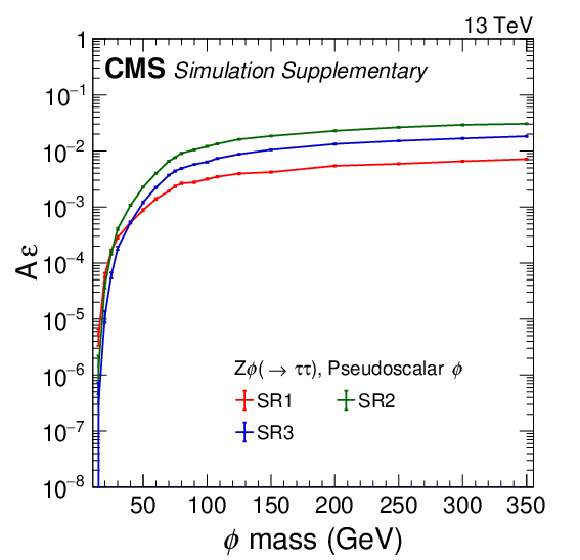
png pdf |
Additional Figure 60:
The product of acceptance and efficiency, $ {\mathrm{A}}\varepsilon $, for a pseudoscalar $ \phi $ boson in the $ {\mathrm{Z}}{\phi} $ signal (with leptonic Z decay) in each signal region in the ditau decay scenario. Each value is computed as the ratio of the number of simulated signal events passing all selection criteria to the total number of simulated signal events, and includes the data-to-simulation correction factors described in the paper. |

png pdf |
Additional Figure 61:
The product of acceptance and efficiency, $ {\mathrm{A}}\varepsilon $, for an H-like $ \phi $ boson in the $ {\mathrm{Z}}{\phi} $ signal (with leptonic Z decay) in each signal region in the dielectron decay scenario. Each value is computed as the ratio of the number of simulated signal events passing all selection criteria to the total number of simulated signal events, and includes the data-to-simulation correction factors described in the paper. |
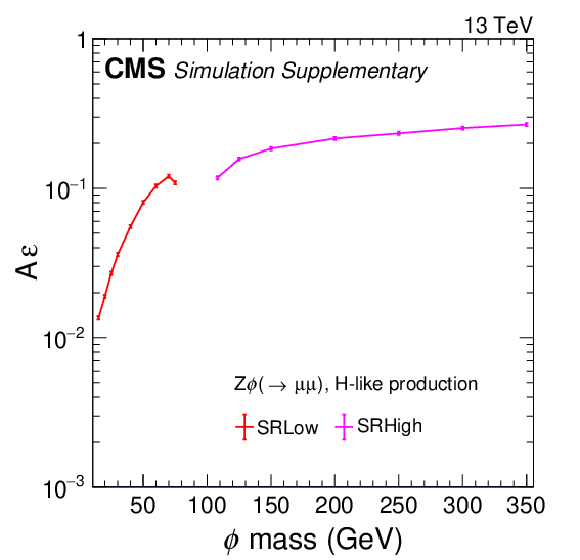
png pdf |
Additional Figure 62:
The product of acceptance and efficiency, $ {\mathrm{A}}\varepsilon $, for an H-like $ \phi $ boson in the $ {\mathrm{Z}}{\phi} $ signal (with leptonic Z decay) in each signal region in the dimuon decay scenario. Each value is computed as the ratio of the number of simulated signal events passing all selection criteria to the total number of simulated signal events, and includes the data-to-simulation correction factors described in the paper. |
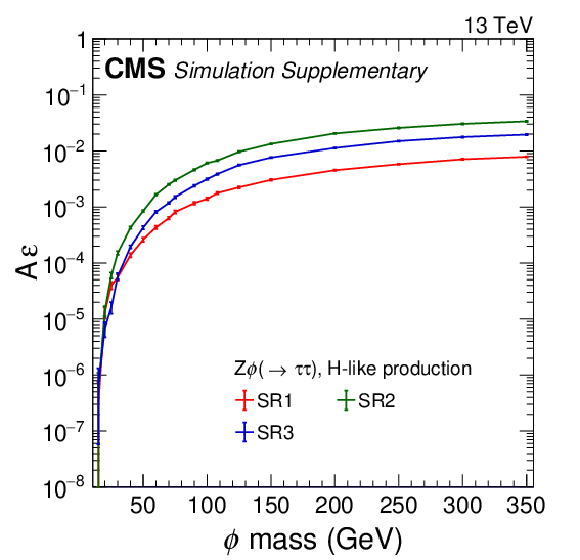
png pdf |
Additional Figure 63:
The product of acceptance and efficiency, $ {\mathrm{A}}\varepsilon $, for an H-like $ \phi $ boson in the $ {\mathrm{Z}}{\phi} $ signal (with leptonic Z decay) in each signal region in the ditau decay scenario. Each value is computed as the ratio of the number of simulated signal events passing all selection criteria to the total number of simulated signal events, and includes the data-to-simulation correction factors described in the paper. |
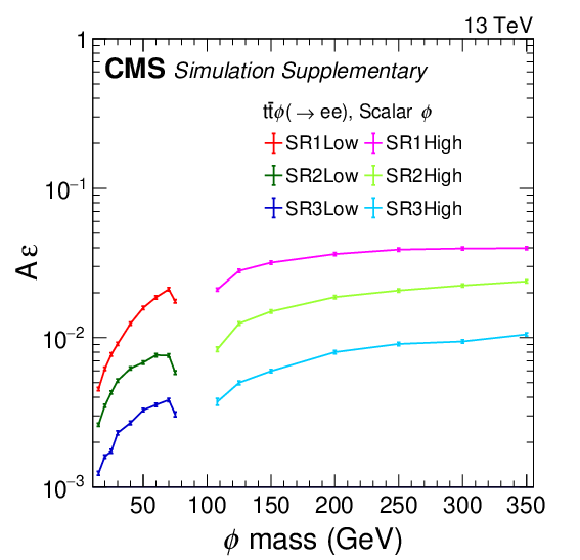
png pdf |
Additional Figure 64:
The product of acceptance and efficiency, $ {\mathrm{A}}\varepsilon $, for a scalar $ \phi $ boson in the $ {{\mathrm{t}\overline{\mathrm{t}}} }{\phi} $ signal (with inclusive $ {\mathrm{t}\overline{\mathrm{t}}} $ decay) in each signal region in the dielectron decay scenario. Each value is computed as the ratio of the number of simulated signal events passing all selection criteria to the total number of simulated signal events, and includes the data-to-simulation correction factors described in the paper. |

png pdf |
Additional Figure 65:
The product of acceptance and efficiency, $ {\mathrm{A}}\varepsilon $, for a scalar $ \phi $ boson in the $ {{\mathrm{t}\overline{\mathrm{t}}} }{\phi} $ signal (with inclusive $ {\mathrm{t}\overline{\mathrm{t}}} $ decay) in each signal region in the dimuon decay scenario. Each value is computed as the ratio of the number of simulated signal events passing all selection criteria to the total number of simulated signal events, and includes the data-to-simulation correction factors described in the paper. |

png pdf |
Additional Figure 66:
The product of acceptance and efficiency, $ {\mathrm{A}}\varepsilon $, for a scalar $ \phi $ boson in the $ {{\mathrm{t}\overline{\mathrm{t}}} }{\phi} $ signal (with inclusive $ {\mathrm{t}\overline{\mathrm{t}}} $ decay) in each signal region in the ditau decay scenario. Each value is computed as the ratio of the number of simulated signal events passing all selection criteria to the total number of simulated signal events, and includes the data-to-simulation correction factors described in the paper. |
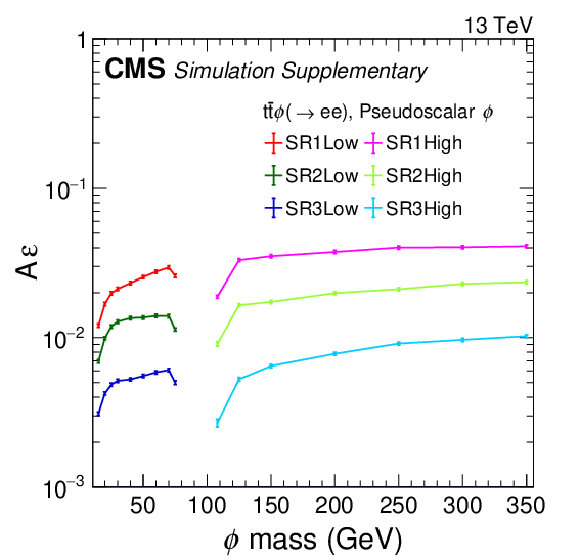
png pdf |
Additional Figure 67:
The product of acceptance and efficiency, $ {\mathrm{A}}\varepsilon $, for a pseudoscalar $ \phi $ boson in the $ {{\mathrm{t}\overline{\mathrm{t}}} }{\phi} $ signal (with inclusive $ {\mathrm{t}\overline{\mathrm{t}}} $ decay) in each signal region in the dielectron decay scenario. Each value is computed as the ratio of the number of simulated signal events passing all selection criteria to the total number of simulated signal events, and includes the data-to-simulation correction factors described in the paper. |

png pdf |
Additional Figure 68:
The product of acceptance and efficiency, $ {\mathrm{A}}\varepsilon $, for a pseudoscalar $ \phi $ boson in the $ {{\mathrm{t}\overline{\mathrm{t}}} }{\phi} $ signal (with inclusive $ {\mathrm{t}\overline{\mathrm{t}}} $ decay) in each signal region in the dimuon decay scenario. Each value is computed as the ratio of the number of simulated signal events passing all selection criteria to the total number of simulated signal events, and includes the data-to-simulation correction factors described in the paper. |

png pdf |
Additional Figure 69:
The product of acceptance and efficiency, $ {\mathrm{A}}\varepsilon $, for a pseudoscalar $ \phi $ boson in the $ {{\mathrm{t}\overline{\mathrm{t}}} }{\phi} $ signal (with inclusive $ {\mathrm{t}\overline{\mathrm{t}}} $ decay) in each signal region in the ditau decay scenario. Each value is computed as the ratio of the number of simulated signal events passing all selection criteria to the total number of simulated signal events, and includes the data-to-simulation correction factors described in the paper. |

png pdf |
Additional Figure 70:
Generator level transverse momentum, $ p_{\mathrm{T}} $, of the $ \phi $ boson in the $ {\mathrm{W}}{\phi} $ signal with scalar couplings. Histograms are provided for several $ \phi $ masses as indicated in units of GeV, and are normalized to the same integral value. The rightmost bin contains the overflow events in each distribution. |
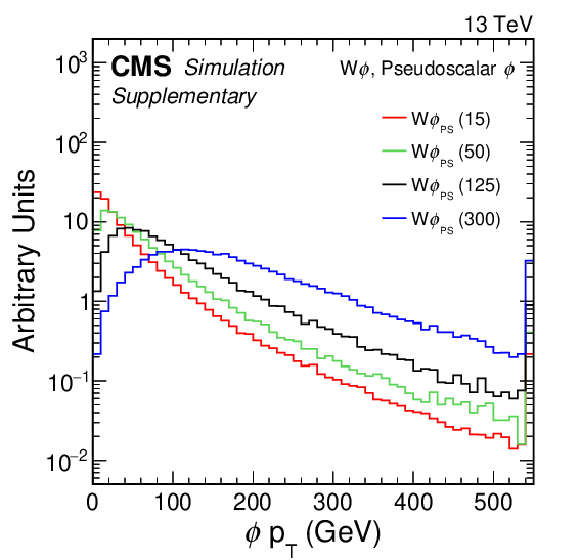
png pdf |
Additional Figure 71:
Generator level transverse momentum, $ p_{\mathrm{T}} $, of $ \phi $ boson in the $ {\mathrm{W}}{\phi} $ signal with pseudoscalar couplings. Histograms are provided for several $ \phi $ masses as indicated in units of GeV, and are normalized to the same integral value. The rightmost bin contains the overflow events in each distribution. |

png pdf |
Additional Figure 72:
Generator level transverse momentum, $ p_{\mathrm{T}} $, of the $ \phi $ boson in the $ {\mathrm{W}}{\phi} $ signal with H-like couplings. Histograms are provided for several $ \phi $ masses as indicated in units of GeV, and are normalized to the same integral value. The rightmost bin contains the overflow events in each distribution. |

png pdf |
Additional Figure 73:
Generator level transverse momentum, $ p_{\mathrm{T}} $, of the $ \phi $ boson with a mass of 15 GeV in the $ {\mathrm{W}}{\phi} $ signal. Histograms are provided for scalar, pseudoscalar, and H-like $ \phi $ coupling scenarios, and are normalized to the same integral value. The rightmost bin contains the overflow events in each distribution. |
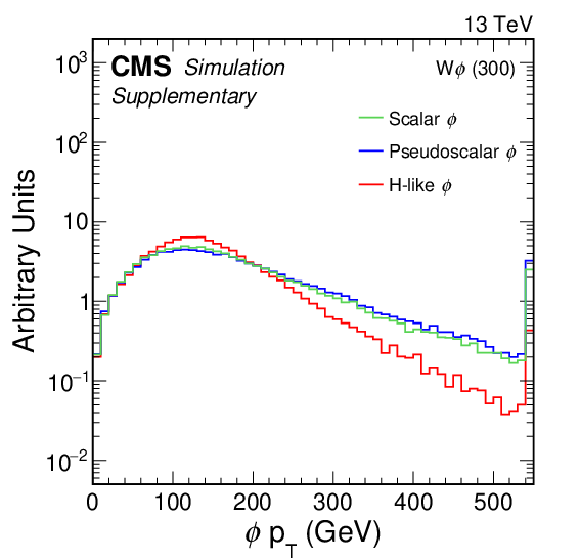
png pdf |
Additional Figure 74:
Generator level transverse momentum, $ p_{\mathrm{T}} $, of the $ \phi $ boson with a mass of 300 GeV in the $ {\mathrm{W}}{\phi} $ signal. Histograms are provided for scalar, pseudoscalar, and H-like $ \phi $ coupling scenarios, and are normalized to the same integral value. The rightmost bin contains the overflow events in each distribution. |
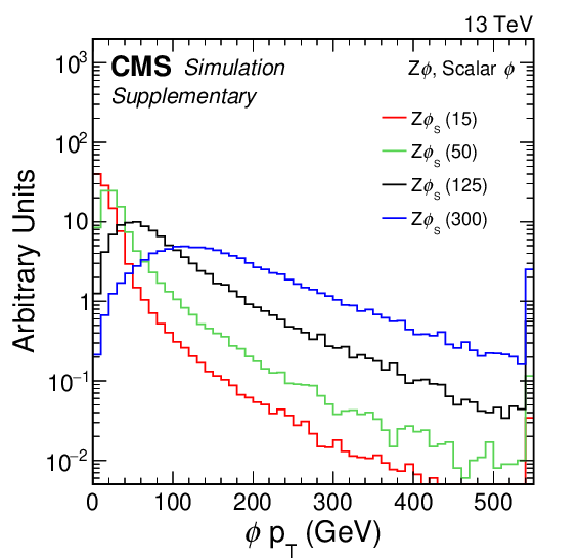
png pdf |
Additional Figure 75:
Generator level transverse momentum, $ p_{\mathrm{T}} $, of the $ \phi $ boson in the $ {\mathrm{Z}}{\phi} $ signal with scalar couplings. Histograms are provided for several $ \phi $ masses as indicated in units of GeV, and are normalized to the same integral value. The rightmost bin contains the overflow events in each distribution. |
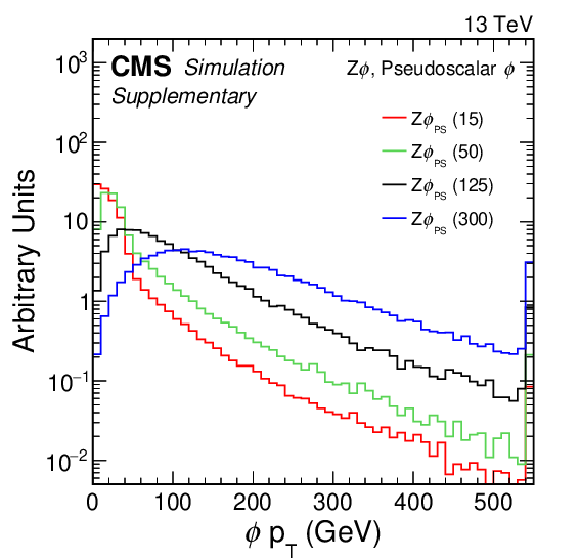
png pdf |
Additional Figure 76:
Generator level transverse momentum, $ p_{\mathrm{T}} $, of the $ \phi $ boson in the $ {\mathrm{Z}}{\phi} $ signal with pseudoscalar couplings. Histograms are provided for several $ \phi $ masses as indicated in units of GeV, and are normalized to the same integral value. The rightmost bin contains the overflow events in each distribution. |
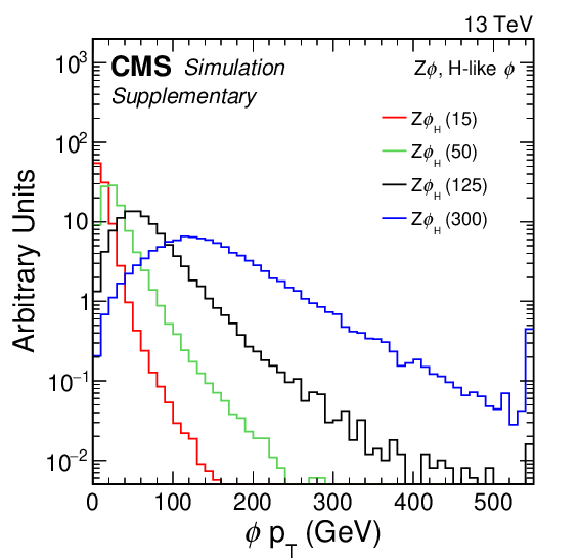
png pdf |
Additional Figure 77:
Generator level transverse momentum, $ p_{\mathrm{T}} $, of the $ \phi $ boson in the $ {\mathrm{Z}}{\phi} $ signal with H-like production. Histograms are provided for several $ \phi $ masses as indicated in units of GeV, and are normalized to the same integral value. The rightmost bin contains the overflow events in each distribution. |

png pdf |
Additional Figure 78:
Generator level transverse momentum, $ p_{\mathrm{T}} $, of the $ \phi $ boson with mass of 15 GeV in the $ {\mathrm{Z}}{\phi} $ signal. Histograms are provided for scalar, pseudoscalar, and H-like $ \phi $ coupling scenarios, and are normalized to the same integral value. The rightmost bin contains the overflow events in each distribution. |
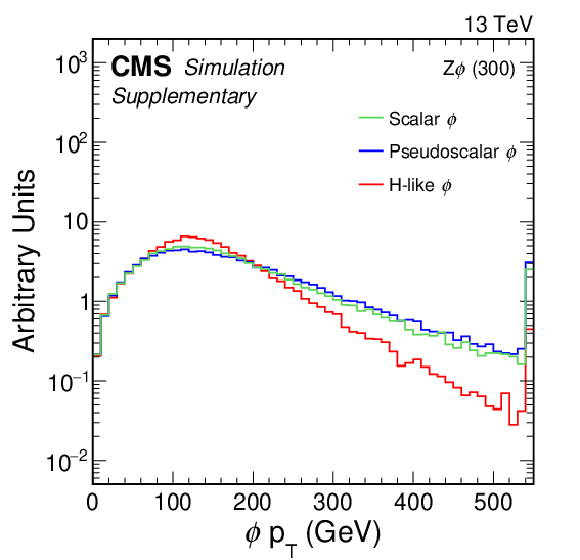
png pdf |
Additional Figure 79:
Generator level transverse momentum, $ p_{\mathrm{T}} $, of the $ \phi $ boson with mass of 300 GeV in the $ {\mathrm{Z}}{\phi} $ signal. Histograms are provided for scalar, pseudoscalar, and\ H-like $ \phi $ coupling scenarios, and are normalized to the same integral value. The rightmost bin contains the overflow events in each distribution. |

png pdf |
Additional Figure 80:
Generator level Z boson reconstructed mass in the $ {\mathrm{Z}}{\phi} $ signal with scalar couplings. Histograms are provided for several $ \phi $ masses as indicated in units of GeV, and are normalized to the same integral value. The rightmost bin contains the overflow events in each distribution. |
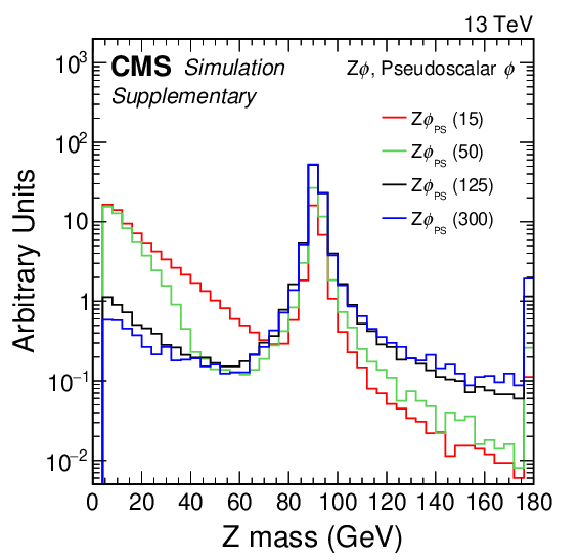
png pdf |
Additional Figure 81:
Generator level Z boson reconstructed mass in the $ {\mathrm{Z}}{\phi} $ signal with pseudoscalar couplings. Histograms are provided for several $ \phi $ masses as indicated in units of GeV, and are normalized to the same integral value. The rightmost bin contains the overflow events in each distribution. |
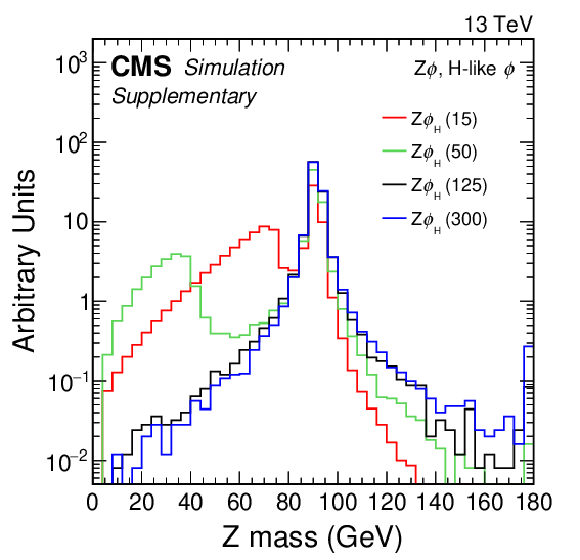
png pdf |
Additional Figure 82:
Generator level Z boson reconstructed mass in the $ {\mathrm{Z}}{\phi} $ signal with H-like production. Histograms are provided for several $ \phi $ masses as indicated in units of GeV, and are normalized to the same integral value. The rightmost bin contains the overflow events in each distribution. |

png pdf |
Additional Figure 83:
Generator level Z boson reconstructed mass in the $ {\mathrm{Z}}{\phi} $ signal with a $ \phi $ boson mass of 15 GeV. Histograms are provided for scalar, pseudoscalar, and H-like $ \phi $ coupling scenarios, and are normalized to the same integral value. The rightmost bin contains the overflow events in each distribution. |
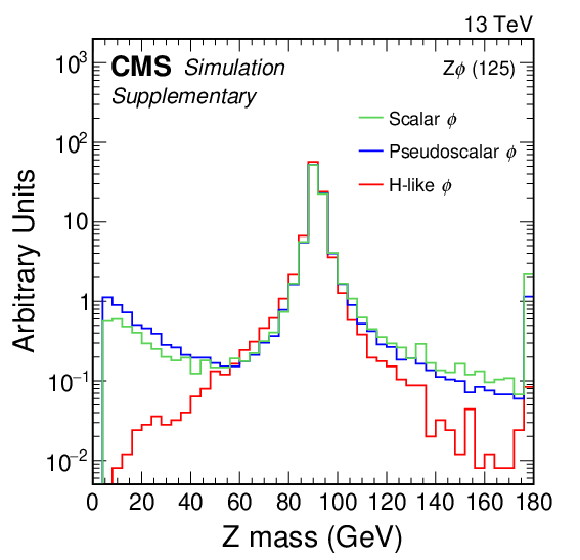
png pdf |
Additional Figure 84:
Generator level Z boson reconstructed mass in the $ {\mathrm{Z}}{\phi} $ signal with a $ \phi $ boson mass of 125 GeV. Histograms are provided for scalar, pseudoscalar, and H-like $ \phi $ coupling scenarios, and are normalized to the same integral value. The rightmost bin contains the overflow events in each distribution. |
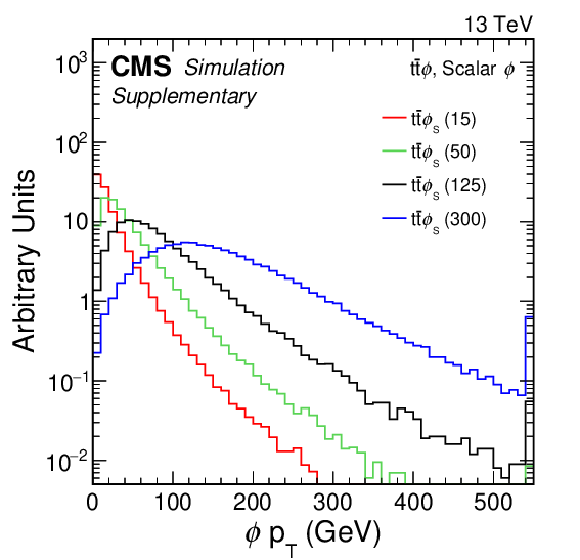
png pdf |
Additional Figure 85:
Generator level transverse momentum, $ p_{\mathrm{T}} $, of $ \phi $ boson in the $ {{\mathrm{t}\overline{\mathrm{t}}} }{\phi} $ signal with scalar couplings. Histograms are provided for several $ \phi $ masses as indicated in units of GeV, and are normalized to the same integral value. The rightmost bin contains the overflow events in each distribution. |

png pdf |
Additional Figure 86:
Generator level transverse momentum, $ p_{\mathrm{T}} $, of the $ \phi $ boson in the $ {{\mathrm{t}\overline{\mathrm{t}}} }{\phi} $ signal with pseudoscalar couplings. Histograms are provided for several $ \phi $ masses as indicated in units of GeV, and are normalized to the same integral value. The rightmost bin contains the overflow events in each distribution. |

png pdf |
Additional Figure 87:
Generator level transverse momentum, $ p_{\mathrm{T}} $, of $ \phi $ boson with mass of 15 GeV in the $ {{\mathrm{t}\overline{\mathrm{t}}} }{\phi} $ signal. Histograms are provided for scalar and pseudoscalar $ \phi $ coupling scenarios, and are normalized to the same integral value. The rightmost bin contains the overflow events in each distribution. |

png pdf |
Additional Figure 88:
Generator level transverse momentum, $ p_{\mathrm{T}} $, of $ \phi $ boson with mass of 125 GeV in the $ {{\mathrm{t}\overline{\mathrm{t}}} }{\phi} $ signal. Histograms are provided for scalar and pseudoscalar $ \phi $ coupling scenarios, and are normalized to the same integral value. The rightmost bin contains the overflow events in each distribution. |
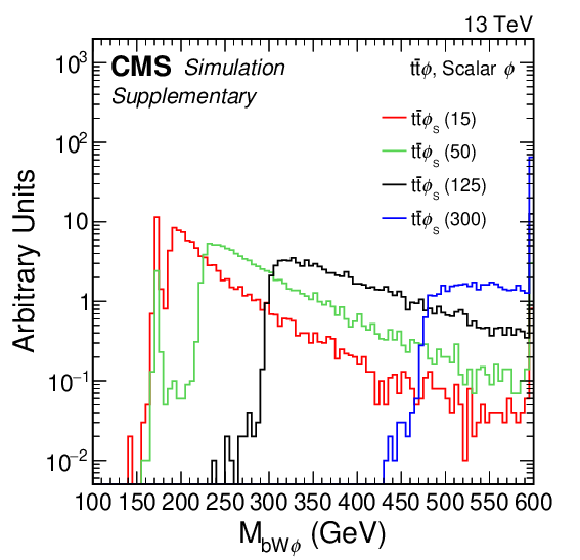
png pdf |
Additional Figure 89:
Generator level invariant mass of the b quark, W boson, and $ \phi $ boson three-body system in the $ {{\mathrm{t}\overline{\mathrm{t}}} }{\phi} $ signal with scalar coupling. Histograms are provided for several $ \phi $ masses as indicated in units of GeV, and are normalized to the same integral value. The rightmost bin contains the overflow events in each distribution. |
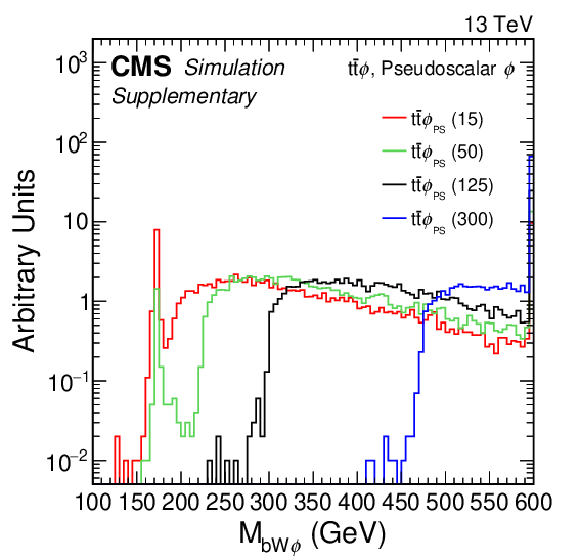
png pdf |
Additional Figure 90:
Generator level invariant mass of the b quark, W boson, and $ \phi $ boson three-body system in the $ {{\mathrm{t}\overline{\mathrm{t}}} }{\phi} $ signal with pseudoscalar coupling. Histograms are provided for several $ \phi $ masses as indicated in units of GeV, and are normalized to the same integral value. The rightmost bin contains the overflow events in each distribution. |
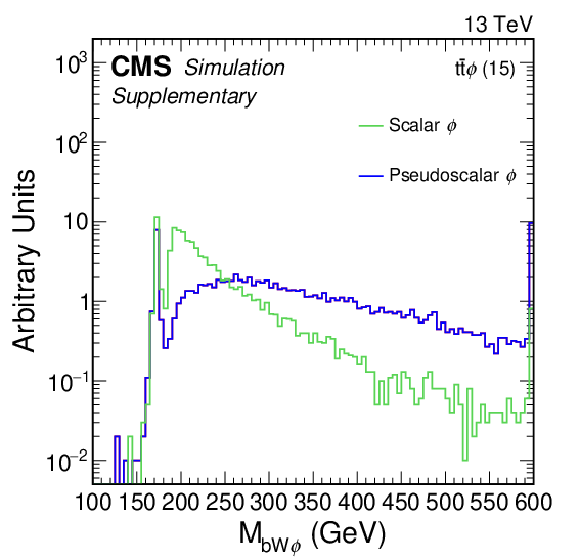
png pdf |
Additional Figure 91:
Generator level invariant mass of the b quark, W boson, and $ \phi $ boson three-body system with $ \phi $ mass of 15 GeV in the $ {{\mathrm{t}\overline{\mathrm{t}}} }{\phi} $ signal. Histograms are provided for scalar and pseudoscalar $ \phi $ coupling scenarios, and are normalized to the same integral value. The rightmost bin contains the overflow events in each distribution. |
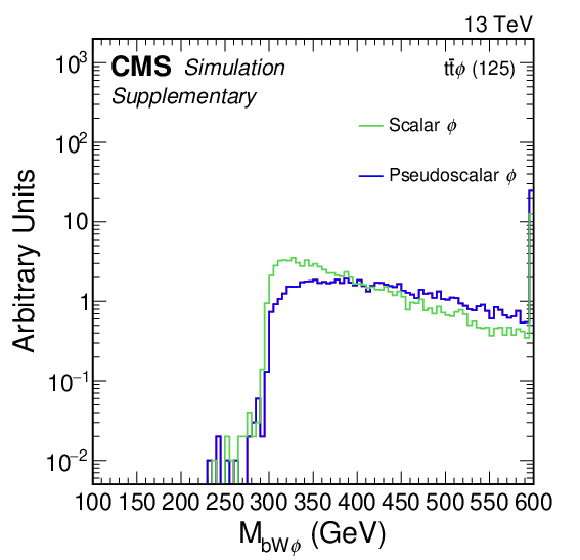
png pdf |
Additional Figure 92:
Generator level invariant mass of the b quark, W boson, and $ \phi $ boson three-body system with $ \phi $ mass of 125 GeV in the $ {{\mathrm{t}\overline{\mathrm{t}}} }{\phi} $ signal. Histograms are provided for scalar and pseudoscalar $ \phi $ coupling scenarios, and are normalized to the same integral value. The rightmost bin contains the overflow events in each distribution. |
| References | ||||
| 1 | G. Cacciapaglia, G. Ferretti, T. Flacke, and H. Serodio | Light scalars in composite Higgs models | Front. Phys. 7 (2019) 22 | 1902.06890 |
| 2 | U. Ellwanger, C. Hugonie, and A. M. Teixeira | The next-to-minimal supersymmetric standard model | Phys. Rept. 496 (2010) 1 | 0910.1785 |
| 3 | M. Maniatis | The next-to-minimal supersymmetric extension of the standard model reviewed | Int. J. Mod. Phys. A 25 (2010) 3505 | 0906.0777 |
| 4 | M. R. Buckley, D. Feld, and D. Goncalves | Scalar simplified models for dark matter | PRD 91 (2015) 015017 | 1410.6497 |
| 5 | M. Casolino et al. | Probing a light CP-odd scalar in di-top-associated production at the LHC | EPJC 75 (2015) 498 | 1507.07004 |
| 6 | W.-F. Chang, T. Modak, and J. N. Ng | Signal for a light singlet scalar at the LHC | PRD 97 (2018) 055020 | 1711.05722 |
| 7 | P. Artoisenet et al. | A framework for Higgs characterisation | JHEP 11 (2013) 043 | 1306.6464 |
| 8 | T. Ghosh, H.-K. Guo, T. Han, and H. Liu | Electroweak phase transition with an SU(2) dark sector | JHEP 07 (2021) 045 | 2012.09758 |
| 9 | E. Gildener and S. Weinberg | Symmetry breaking and scalar bosons | PRD 13 (1976) 3333 | |
| 10 | W. D. Goldberger, B. Grinstein, and W. Skiba | Distinguishing the Higgs boson from the dilaton at the Large Hadron Collider | PRL 100 (2008) 111802 | 0708.1463 |
| 11 | A. Ahmed, A. Mariotti, and S. Najjari | A light dilaton at the LHC | JHEP 05 (2020) 093 | 1912.06645 |
| 12 | V. Barger, M. Ishida, and W.-Y. Keung | Dilaton at the LHC | PRD 85 (2012) 015024 | 1111.2580 |
| 13 | H. Georgi, D. B. Kaplan, and L. Randall | Manifesting the invisible axion at low-energies | PLB 169 (1986) 73 | |
| 14 | K. Mimasu and V. Sanz | ALPs at colliders | JHEP 06 (2015) 173 | 1409.4792 |
| 15 | I. Brivio et al. | ALPs effective field theory and collider signatures | EPJC 77 (2017) 572 | 1701.05379 |
| 16 | M. Bauer, M. Heiles, M. Neubert, and A. Thamm | Axion-like particles at future colliders | EPJC 79 (2019) 74 | 1808.10323 |
| 17 | R. M. Schabinger and J. D. Wells | A minimal spontaneously broken hidden sector and its impact on Higgs boson physics at the large hadron collider | PRD 72 (2005) 093007 | hep-ph/0509209 |
| 18 | V. Barger et al. | LHC phenomenology of an extended standard model with a real scalar singlet | PRD 77 (2008) 035005 | 0706.4311 |
| 19 | CMS Collaboration | HEPData record for this analysis | link | |
| 20 | ALEPH Collaboration | Search for a nonminimal Higgs boson produced in the reaction $ \mathrm{e}^{+} \mathrm{e}^{-} \to \mathrm{h}\mathrm{Z}^{*} $ | PLB 313 (1993) 312 | |
| 21 | L3 Collaboration | Search for neutral Higgs boson production through the process $ \mathrm{e}^{+} \mathrm{e}^{-} \to \mathrm{Z}^{*}\mathrm{H}^0 $ | PLB 385 (1996) 454 | |
| 22 | LEP working group for Higgs boson searches, ALEPH, DELPHI, L3 and OPAL Collaborations | Search for the standard model Higgs boson at LEP | PLB 565 (2003) 61 | hep-ex/0306033 |
| 23 | D0 Collaboration | Combined search for the Higgs boson with the D0 experiment | PRD 88 (2013) 052011 | 1303.0823 |
| 24 | CDF Collaboration | Combination of searches for the Higgs boson using the full CDF data set | PRD 88 (2013) 052013 | 1301.6668 |
| 25 | CDF and D0 Collaborations | Higgs boson studies at the Tevatron | PRD 88 (2013) 052014 | 1303.6346 |
| 26 | CMS Collaboration | Search for the standard model Higgs boson produced in association with W and Z bosons in pp collisions at $ \sqrt{s}= $ 7 TeV | JHEP 11 (2012) 088 | CMS-HIG-12-010 1209.3937 |
| 27 | ATLAS Collaboration | Measurement of the production cross section for a Higgs boson in association with a vector boson in the $ \mathrm{H} \to \mathrm{WW}^{\ast} \to \ell\nu\ell\nu $ channel in pp collisions at $ \sqrt{s}= $ 13 TeV with the ATLAS detector | PLB 798 (2019) 134949 | 1903.10052 |
| 28 | CMS Collaboration | Evidence for the 125 GeV Higgs boson decaying to a pair of $ \tau $ leptons | JHEP 05 (2014) 104 | CMS-HIG-13-004 1401.5041 |
| 29 | ATLAS Collaboration | Evidence for the Higgs-boson Yukawa coupling to tau leptons with the ATLAS detector | JHEP 04 (2015) 117 | 1501.04943 |
| 30 | CMS Collaboration | Search for the associated production of the Higgs boson with a top-quark pair | [Erratum: JHEP 10, 106 ()], 2014 JHEP 09 (2014) 087 |
CMS-HIG-13-029 1408.1682 |
| 31 | ATLAS Collaboration | Search for new phenomena in events with same-charge leptons and b jets in pp collisions at $ \sqrt{s}= $ 13 TeV with the ATLAS detector | JHEP 12 (2018) 039 | 1807.11883 |
| 32 | CMS Collaboration | Evidence for Higgs boson decay to a pair of muons | JHEP 01 (2021) 148 | CMS-HIG-19-006 2009.04363 |
| 33 | ATLAS Collaboration | A search for the dimuon decay of the standard model Higgs boson with the ATLAS detector | PLB 812 (2021) 135980 | 2007.07830 |
| 34 | CMS Collaboration | Observation of Higgs boson decay to bottom quarks | PRL 121 (2018) 121801 | CMS-HIG-18-016 1808.08242 |
| 35 | ATLAS Collaboration | Observation of $ \mathrm{H} \to \mathrm{b}\bar{\mathrm{b}} $ decays and VH production with the ATLAS detector | PLB 786 (2018) 59 | 1808.08238 |
| 36 | ATLAS Collaboration | Search for a new pseudoscalar decaying into a pair of muons in events with a top-quark pair at $ \sqrt{s} = $ 13 tev with the ATLAS detector | no.~9, 09, 2023 PRD 108 (2023) |
2304.14247 |
| 37 | CMS Collaboration | Search for physics beyond the standard model in multilepton final states in proton-proton collisions at $ \sqrt{s} = $ 13 TeV | JHEP 03 (2020) 051 | CMS-EXO-19-002 1911.04968 |
| 38 | CMS Collaboration | The CMS experiment at the CERN LHC | JINST 3 (2008) S08004 | |
| 39 | CMS Collaboration | Development of the CMS detector for the CERN LHC Run 3 | Accepted by JINST, 2023 | CMS-PRF-21-001 2309.05466 |
| 40 | CMS Collaboration | Performance of the CMS level-1 trigger in proton-proton collisions at $ \sqrt{s} = $ 13 TeV | JINST 15 (2020) P10017 | CMS-TRG-17-001 2006.10165 |
| 41 | CMS Collaboration | The CMS trigger system | JINST 12 (2017) P01020 | CMS-TRG-12-001 1609.02366 |
| 42 | CMS Collaboration | Precision luminosity measurement in proton-proton collisions at $ \sqrt{s} = $ 13 TeV in 2015 and 2016 at CMS | EPJC 81 (2021) 800 | CMS-LUM-17-003 2104.01927 |
| 43 | CMS Collaboration | CMS luminosity measurement for the 2017 data-taking period at $ \sqrt{s} = $ 13 TeV | CMS Physics Analysis Summary, 2018 CMS-PAS-LUM-17-004 |
CMS-PAS-LUM-17-004 |
| 44 | CMS Collaboration | CMS luminosity measurement for the 2018 data-taking period at $ \sqrt{s} = $ 13 TeV | CMS Physics Analysis Summary, 2019 CMS-PAS-LUM-18-002 |
CMS-PAS-LUM-18-002 |
| 45 | J. Alwall et al. | The automated computation of tree-level and next-to-leading order differential cross sections, and their matching to parton shower simulations | JHEP 07 (2014) 079 | 1405.0301 |
| 46 | P. Nason | A new method for combining NLO QCD with shower Monte Carlo algorithms | JHEP 11 (2004) 040 | hep-ph/0409146 |
| 47 | S. Frixione, P. Nason, and C. Oleari | Matching NLO QCD computations with parton shower simulations: the POWHEG method | JHEP 11 (2007) 070 | 0709.2092 |
| 48 | S. Alioli, P. Nason, C. Oleari, and E. Re | A general framework for implementing NLO calculations in shower Monte Carlo programs: the POWHEG BOX | JHEP 06 (2010) 043 | 1002.2581 |
| 49 | J. M. Campbell and R. K. Ellis | MCFM for the Tevatron and the LHC | --206 10, 2010 Nucl. Phys. Proc. Suppl. 20 (2010) 5 |
1007.3492 |
| 50 | Y. Gao et al. | Spin determination of single-produced resonances at hadron colliders | PRD 81 (2010) 075022 | 1001.3396 |
| 51 | S. Bolognesi et al. | On the spin and parity of a single-produced resonance at the LHC | PRD 86 (2012) 095031 | 1208.4018 |
| 52 | I. Anderson et al. | Constraining anomalous HVV interactions at proton and lepton colliders | PRD 89 (2014) 035007 | 1309.4819 |
| 53 | A. V. Gritsan, R. Röntsch, M. Schulze, and M. Xiao | Constraining anomalous Higgs boson couplings to the heavy flavor fermions using matrix element techniques | PRD 94 (2016) 055023 | 1606.03107 |
| 54 | NNPDF Collaboration | Parton distributions for the LHC Run II | JHEP 04 (2015) 040 | 1410.8849 |
| 55 | NNPDF Collaboration | Parton distributions from high-precision collider data | EPJC 77 (2017) 663 | 1706.00428 |
| 56 | T. Sjöstrand et al. | An introduction to PYTHIA 8.2 | Comput. Phys. Commun. 191 (2015) 159 | 1410.3012 |
| 57 | CMS Collaboration | Event generator tunes obtained from underlying event and multiparton scattering measurements | EPJC 76 (2016) 155 | CMS-GEN-14-001 1512.00815 |
| 58 | CMS Collaboration | Extraction and validation of a new set of CMS PYTHIA8 tunes from underlying-event measurements | EPJC 80 (2020) 4 | CMS-GEN-17-001 1903.12179 |
| 59 | J. Alwall et al. | Comparative study of various algorithms for the merging of parton showers and matrix elements in hadronic collisions | EPJC 53 (2008) 473 | 0706.2569 |
| 60 | R. Frederix and S. Frixione | Merging meets matching in MC@NLO | JHEP 12 (2012) 061 | 1209.6215 |
| 61 | GEANT4 Collaboration | GEANT 4---a simulation toolkit | NIM A 506 (2003) 250 | |
| 62 | CMS Collaboration | Technical proposal for the Phase-II upgrade of the Compact Muon Solenoid | CMS Technical Proposal CERN-LHCC-2015-010, CMS-TDR-15-02, 2015 CDS |
|
| 63 | CMS Collaboration | Particle-flow reconstruction and global event description with the CMS detector | JINST 12 (2017) P10003 | CMS-PRF-14-001 1706.04965 |
| 64 | CMS Collaboration | Electron and photon reconstruction and identification with the CMS experiment at the CERN LHC | JINST 16 (2021) P05014 | CMS-EGM-17-001 2012.06888 |
| 65 | CMS Collaboration | ECAL 2016 refined calibration and Run2 summary plots | CMS Detector Performance Note CMS-DP-2020-021, 2020 CDS |
|
| 66 | CMS Collaboration | Performance of the CMS muon detector and muon reconstruction with proton-proton collisions at $ \sqrt{s}= $ 13 TeV | JINST 13 (2018) P06015 | CMS-MUO-16-001 1804.04528 |
| 67 | CMS Collaboration | Performance of reconstruction and identification of $ \tau $ leptons decaying to hadrons and $ \nu_{\tau} $ in pp collisions at $ \sqrt{s}= $ 13 TeV | JINST 13 (2018) | CMS-TAU-16-003 1809.02816 |
| 68 | M. Cacciari, G. P. Salam, and G. Soyez | The anti-$ k_{\mathrm{T}} $ jet clustering algorithm | JHEP 04 (2008) 063 | 0802.1189 |
| 69 | M. Cacciari, G. P. Salam, and G. Soyez | Fastjet user manual | EPJC 72 (2012) 1896 | 1111.6097 |
| 70 | CMS Collaboration | Jet energy scale and resolution in the CMS experiment in pp collisions at 8 TeV | JINST 12 (2017) P02014 | CMS-JME-13-004 1607.03663 |
| 71 | CMS Collaboration | Performance of missing transverse momentum reconstruction in proton-proton collisions at $ \sqrt{s} = $ 13 TeV using the CMS detector | JINST 14 (2019) P07004 | CMS-JME-17-001 1903.06078 |
| 72 | D. Bertolini, P. Harris, M. Low, and N. Tran | Pileup per particle identification | JHEP 10 (2014) 059 | 1407.6013 |
| 73 | CMS Collaboration | Pileup mitigation at CMS in 13 TeV data | JINST 15 (2020) P09018 | CMS-JME-18-001 2003.00503 |
| 74 | CMS Collaboration | Identification of heavy-flavour jets with the CMS detector in pp collisions at 13 TeV | JINST 13 (2018) P05011 | CMS-BTV-16-002 1712.07158 |
| 75 | CMS Collaboration | Identification of hadronic tau lepton decays using a deep neural network | JINST 17 (2022) P07023 | CMS-TAU-20-001 2201.08458 |
| 76 | CMS Collaboration | Search for third-generation scalar leptoquarks in the t$ \tau $ channel in proton-proton collisions at $ \sqrt{s} = $ 8 TeV | [Erratum: JHEP 11 () 056], 2015 JHEP 07 (2015) 042 |
CMS-EXO-14-008 1503.09049 |
| 77 | CMS Collaboration | Measurement of the inclusive W and Z production cross sections in pp collisions at $ \sqrt{s}= $ 7 TeV | JHEP 10 (2011) 132 | CMS-EWK-10-005 1107.4789 |
| 78 | K. S. Cranmer | Kernel estimation in high-energy physics | Comput. Phys. Commun. 136 (2001) 198 | hep-ex/0011057 |
| 79 | M. Cacciari et al. | The $ \mathrm{t}\bar{\mathrm{t}} $ cross-section at 1.8 and 1.96 TeV: A study of the systematics due to parton densities and scale dependence | JHEP 04 (2004) 068 | hep-ph/0303085 |
| 80 | CMS Collaboration | Measurement of the inelastic proton-proton cross section at $ \sqrt{s}= $ 13 TeV | JHEP 07 (2018) 161 | CMS-FSQ-15-005 1802.02613 |
| 81 | ATLAS Collaboration | Measurement of the inelastic proton-proton cross section at $ \sqrt{s} = $ 13 TeV with the ATLAS detector at the LHC | PRL 117 (2016) 182002 | 1606.02625 |
| 82 | E. Gross and O. Vitells | Trial factors for the look elsewhere effect in high energy physics | EPJC 70 (2010) 525 | 1005.1891 |
| 83 | T. Junk | Confidence level computation for combining searches with small statistics | NIM A 434 (1999) 435 | hep-ex/9902006 |
| 84 | A. L. Read | Presentation of search results: The CL$ _{s} $ technique | JPG 28 (2002) 2693 | |
| 85 | G. Cowan, K. Cranmer, E. Gross, and O. Vitells | Asymptotic formulae for likelihood-based tests of new physics | EPJC 71 (2011) 1554 | 1007.1727 |
| 86 | ATLAS and CMS Collaborations, and LHC Higgs Combination Group | Procedure for the LHC Higgs boson search combination in summer 2011 | Technical Report CMS-NOTE-2011-005, ATL-PHYS-PUB-2011-011, 2011 | |
| 87 | A. Djouadi, J. Kalinowski, and M. Spira | HDECAY: A program for Higgs boson decays in the standard model and its supersymmetric extension | Comput. Phys. Commun. 108 (1998) 56 | hep-ph/9704448 |
| 88 | A. Djouadi, J. Kalinowski, M. Muehlleitner, and M. Spira | HDECAY: Twenty$ ++ $ years after | Comput. Phys. Commun. 238 (2019) 214 | 1801.09506 |

|
Compact Muon Solenoid LHC, CERN |

|

|

|

|

|

|